Home ✧ About ✧ Sitemap ✧ Neighbors ✧ Guestbook

Ladder to the Moon ; 1958 AD ; Abiquiú, United States of America ; 40 x 30 in ; Oil on linen
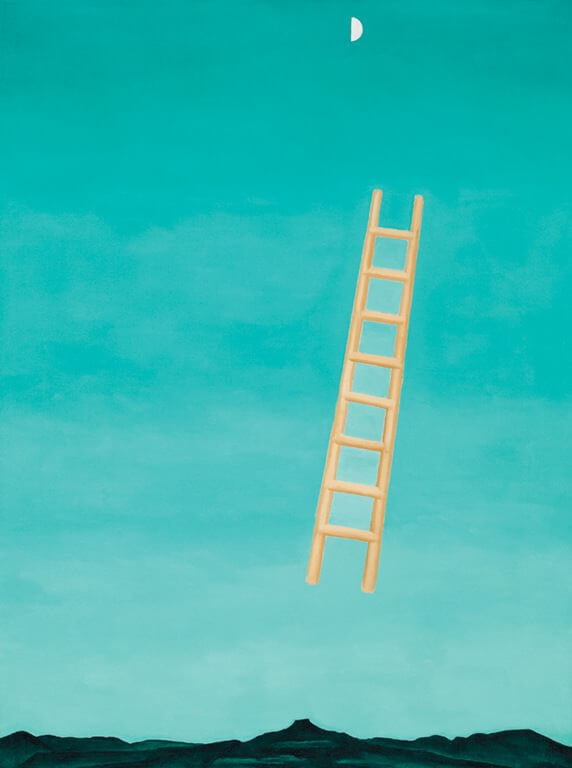
I’m so intrigued by this. I love that the ladder is hanging in mid-air, not quite a ladder to the sky as much as a ladder in the sky. There’s a moon far above it, and land far below, but it can’t quite reach either; there’s no real beginning or destination to the journey it provides. Is the effort fruitless? Is that devastating or liberating?
It also makes me think about the way we approach life. If we think of our world as a march from life ‘til death… I don’t know. Maybe for some people, it’s empowering, but it doesn’t feel that way to me. We need to find importance in simply existing– not just in getting somewhere.
The colors aren’t exactly muted, but they’re soft and comforting. It feels like a dream, and also sort of reminds me of Salvador Dali (booo). I love how green and lush the mountains below are, and that the moon is only a half moon (opposition, two sides to something bigger, divinity, cycles, etc). Is this meant to be a link between nature and the cosmos? Humankind and the universe around us? Also, I can’t tell if this is just an issue of image quality, but it looks almost as if the color between the rungs of the ladder is lighter and more turquoise-y than most of the sky. It’s like it’s a different realm entirely, climbing along and experiencing that journey.
The ladder to me is just another place. It’s not just a transitive space, meant to get you from one to another, but its own world/realm. I think a lot of people would think almost instantly that we humans are beginning on Earth, because that’s what’s familiar to us. What if we started on the ladder? Or on the moon? I’m not sure.
Journey of the Wounded Healer ; 1985 AD ; New York, United States of America ; 216 x 90 in ; Oil on linen
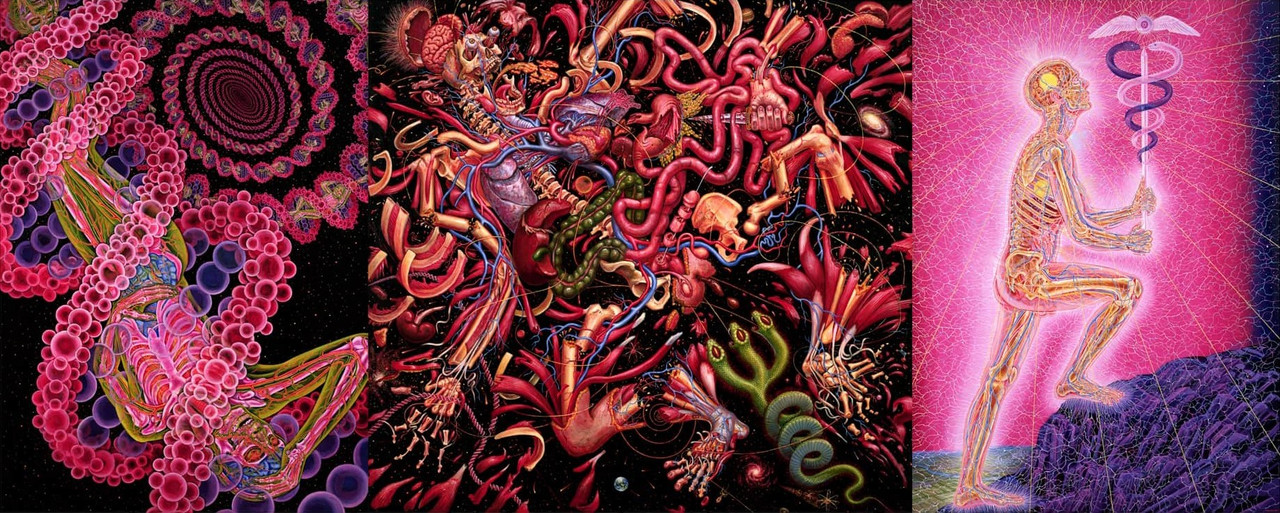
I’m sort of awestruck. There’s so much going on here– a lot of imagery both traditional and entirely reimagined. It’s a triptych that seems to have some sort of progression or narrative, though I can’t tell quite how. I’m just going to walk through them so I can find the story as I go.
In the first, a skinless/muscle-less skeleton (though it has a sort of green aura that seems to emulate the skin’ seems to be diving head first through space, wrapped in a spiraling DNA double helix. It has a hand on its head, signaling frustration or exhaustion of some kind– like it’s really getting to the end of its rope.
In the second, it’s exploding (though it doesn’t seem like it’s entirely the same creature, as it has skin and muscle and stuff). It’s being torn apart, seemingly as if because of a pressure build up. Honestly, it looks really painful. But also expansive and freeing? I see a lot of serpent symbolism which is intriguing… represents healing, rebirth, transformation, etc.
We see that especially in the last one, where the man is climbing upward, with a sort of heavenly glow/aura around him and holding the caduceus. I can’t tell if it was meant to be the Rod of Asclepius (often mistaken) for medical purposes, or is meant to be Hermes’ staff (rebirth symbolism, likely), but both definitely work. There’s awakening, ascendence, and more.
I can also read this as not quite narrative but simultaneous– maybe instead, it’s meant to be mind, body, and spirit all at once. An opening up and understanding– painful and incredible.
It’s such a weird piece. Very, very cool.
Lisa Lyon ; 1980-1982 AD ; New York, United States of America ; 101 x 75.6 cm ; Photograph, gelatin silver print
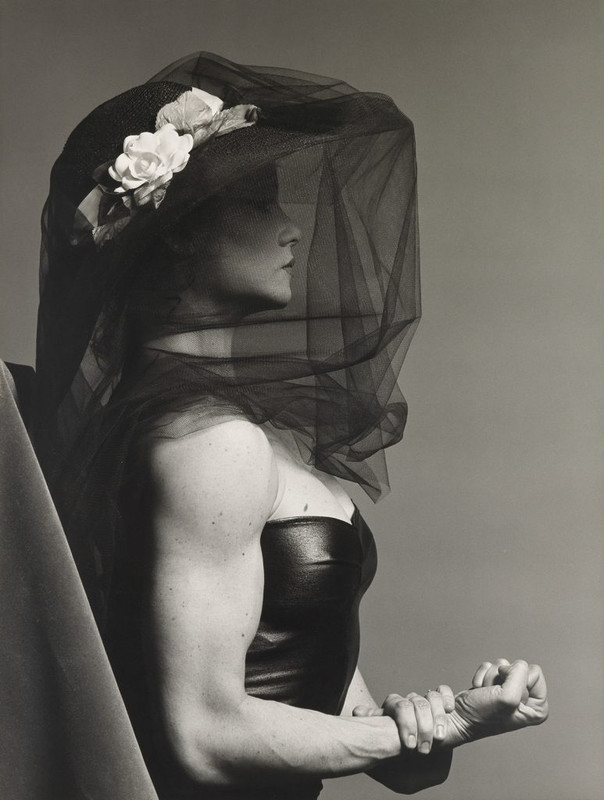
I love this. I can’t tell what’s going on with the sort of plate she’s leaning against, but we see a woman in a very old-fashioned hat (with white flowers– very feminine & soft) and veil, both black. It feels sort of like mourning attire, but then she wears an incredibly tight, low-cut, and sort of sexy leather dress/top. All the while, she has one arm flexed and is holding her wrist as she clenches her fist. There’s masculinity and femininity intertwined.
There’s so much juxtaposition in this piece, especially enhanced by the black and white lighting. It’s very intense and weird to me, and I like it a lot. She’s defined, and so is everything.
I think there’s an interesting exploration about grief, mourning, and strength, but also about different expectations and subversions of them. There’s a soft side and a rough side to the woman in this piece. She has a stoic expression– not giving anything away, almost painfully emotionless. The side profile is really interesting to me, too. We won’t look at her straight on. She won’t let us.
She’s being strong through this pain, and seeming to try and show that off. I can’t tell if she’s performing grief, or hiding it, or trying to balance the two. Hiding the real and performing the palatable? I definitely see the stages of grief in this, though. She’s holding her own arm down, too. She’s balancing all these sides of herself– holding her strength and intensity back.
I think it’s interesting how reminiscent she is of Rosie the Riveter, too. I don’t know quite how that relates, except that it’s emphasizing her power! The stance is just… powerful. With the dress/top part, it’s kind of odd because it doesn’t even fit into the idea of stages of grief. There’s this other side of her, too– maybe moving on? But she can’t let that happen entirely.
Imponderabilia ; 1977 AD ; Bologna, Italy ; Performance piece
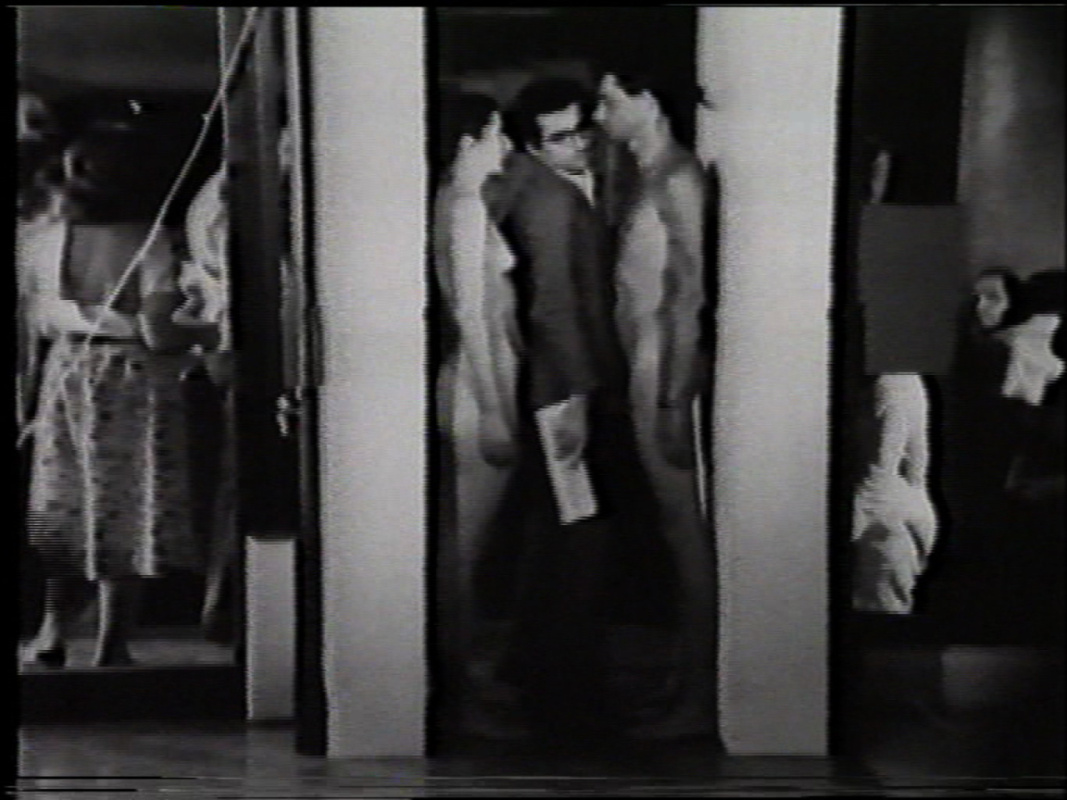
This is such an odd piece of art to observe. We watched a video of the gallery, and it took me a minute to figure out what was going on– that visitors were walking between two naked people, staring at one another in a narrow archway. It’s uncomfortable– awkward, intrusive, intimate. I kind of love it, though.
It’s challenging us to decide– quickly– what is the most comfortable way through, and then to think about why it is for us. Did you walk slow or fast? Facing to the side or forward? Which way did you face? Did your heart beat faster? From fear, or thrill?
I think the gender aspect is really interesting. Do you face the man or the woman? It seems like most people faced the woman– found her less threatening or uncomfortable– and I’m curious why. I probably would have as well (assuming I didn’t walk straight through), as her body is more familiar to me. There’s more comfort and understanding. Also, I just want to avoid feeling and generally experiencing the guy’s dick as much as possible. But even more than that, I wonder why the men chose to face her. Is it fear of being seen as gay? Is it wanting to see a woman naked? Is it that the taller ones don’t have to look at her?
It’s curious, and striking. I love this piece, honestly. It’s obviously a controversial work, but I think it’s important and thought-provoking.
Self ; 1991 AD ; New York, United States of America ; 208 x 63 x 63 cm ; Blood (artist’s), stainless steel, Perspex and refrigeration equipment


This is such an odd piece. It’s made of blood, which is so creepy, and looks like it’s peeling at every corner of the face. The fact that it’s blood is interesting because that means it’s living, sort of– decaying and decomposing. That brings to life questions of mortality. The nostrils almost look like they’re stuffed with tissue or something, and the ears look sort of fucked up in a weird way.
Initially, the feeling I got was that it’s reminiscent of chronic illness– peeling skin, discomfort. It’s very visceral. At the same time, the fact that it’s made of blood makes it feel more intense than that. More violent. I honestly don’t know what’s going on with it, though. The head looks so peaceful for its context. Maybe it’s the one perpetuating violence, not experiencing it?
The fact that it’s being preserved in a little fridge adds another layer. It’s on a sort of life support. It brings to mind medical advancements, and questions of whether they’re really advancements. Even questions of respecting one’s wishes vs. trying to keep them alive. How do you respect autonomy when it’s so painful to do so? What do you do when those two don’t coincide?
The piece also reminds me a little of “Head of a Roman Patrician,” which we looked at earlier this year.
I can’t tell what meaning this is supposed to have, or if it’s more just meant to shock. I don’t know what’s up with it. It’s pretty cool, though. Not my favorite, I don’t think.
School of Beauty, School of Culture ; 2012 AD ; Chicago, United States of America ; 274 × 401 cm ; Acrylic and glitter on canvas

I love how lively this piece feels! I can hear the chatter, the music, the confidence of the room. It seems to be a beauty parlor of some kind, but there’s more going on here than that. Everyone’s dressed in different kinds of African patterns, and they look so proud.
Across the mirrors in the room, you can see signs that say SCHOOL OF CULTURE and SCHOOL [] -UTY, though I’m not sure what that second one’s supposed to be. It gives this an extra level– that there’s not only community here, but learning. Maybe intergenerational learning?
There’s a weird white lady’s face stretched across the floor, which reminds me of the memento mori skull in The Ambassadors (also felt weirdly out of place there). The little boy is looking at it and reaching for it– ignoring all the rest that’s going on, which is interesting. There’s something particularly appealing to him about the white woman, even in a room full of Black joy and beauty– a preference taught and reinforced by society. The little girl, though, is looking up to other Black women, still while reaching for the white woman with her other hand. It feels similar.
I think it’s kind of cool that we can see the artist in the painting– taking a photo in the center of the mirror. It’s really beautiful to me that he paints himself as part of the painting, the culture, the community. He’s not documenting them from outside.
This piece reminds me a lot of Faith Ringgold’s work, too– specifically Dancing at the Louvre.
DRAWING RESTRAINT 9 ; 2005 AD ; New York, United States of America ; 92.7 x 289.6 x 203.2 cm ; 35mm film transferred to video (color, sound), polycaprolactone thermoplastic, aquaplast, self-lubricating plastic

This is so striking and surreal. I love the way the two figures are leaning into each other as they kiss– knives in hand, which should signal betrayal, but it doesn’t feel like it is, because they’re not really trying to conceal them.
At first glance, it almost looked as if the man was holding the limp body or just fur of a fox/wolf/other creature he had killed. The way the fur drapes around her makes it feel almost as if she’s an animal/mythical creature herself. She doesn’t feel real– more like a dream, or an apparition, or just a beast of some kind.
It makes me think of Shinto tradition, actually– maybe kitsune? I can definitely see the Japanese influence, of course.
Her headdress and hair are really interesting, too. The aesthetics feel almost like dry nature– whether in a desert, in the winter, or in some sort of tunda. She feels symbolic of death in some way. I can’t quite tell what’s going on with his outfit; it’s all black, seemingly kind of silky, and has a sort of interesting collar.
Also, the background– I have no idea what’s going on with it. In my mind, it feels almost like a zoo enclosure. There’s concrete all around them, and the white floor below them feels almost like ice or snow. I can’t tell what the rope/stick/pole thing is, but it evokes a dead tree for me. I think I’m just imbuing it with that animalistic energy I got from this piece. The idea of it being a zoo enclosure, or even just an enclosure of any kind emphasizes restraint, to me.
They’re soaking in something, actually. I can’t tell what. It looks oily and gross– like sweat, but pooling as if it was blood, rushing out. Could it be dried blood? It feels way too watery for that, though. It almost looks like they’re melting or rotting into the floor, like the way decomposing matter often gets mushy and wet. It also makes me think about how people’s bladders release when they die. I can’t fully tell what’s going on with it, though.
I’m thinking again about the knives. I love that they’re holding them so openly. There’s a sense of danger, but also understanding. No one’s trying to hide or pretend. There’s passion and necessity involved. Again, very animal– wild, instinctual. At the same time, there’s restraint. They aren’t just killing each other, or harming each other, or whatever else. They’re sitting still with their knives, and embracing each other tenderly– kissing slowly. The idea that they’re resisting this sort of animal nature to kill one another– for food, life, etc– is really interesting.
White Hero ; 2013 AD ; Tokyo, Japan ; 300 × 240 × 10 cm ; Acrylic and automotive paint on aluminium

I’m really overwhelmed by this piece. It’s beautiful, and I have absolutely no clue what’s going on. It seems very turbulent, like a fight scene– with this one woman in the center. I can’t tell if she’s strung up/captured or just standing up (it seems like the first), but she almost reminds me of one of the Sailor Guardians! Maybe in mid transformation?
Like I said before, it looks like there’s some sort of fight going on. The huge black thing seems like a great dragon of some kind, but it also looks inspired by a scorpion or some kind of bug. The blue at first made me think of water, but the way it wraps around the girl’s ankles and the dragon’s neck makes me think that maybe it’s more sentient? I do think it’s probably water, but it’s cool that it has a life to it.
It’s taken me so much looking to figure out what the white creature is, but I think it’s like a person diving down into the fight with a spear. It reminds me a little of hollow knight, or even just any fencer.
I love the chaos. It feels so wild & free & fantastical. I don’t have too much to say about the piece, to be honest, but it’s really cool to look at.
Easter Dress ; 1986 AD ; Lexington, United States of America / New York, United States of America ; 50.6 × 60.4 cm ; Gelatin silver print

This is such a cool and eerie photo. It feels almost like it’s from a VHS tape sequence in a horror movie.
The little girl is showing off her dress and herself in a really sweet and innocent way. She seems so proud and excited to be in something she finds beautiful. The black and white makes it feel more off-putting, though. Especially with the (obviously empty) dress hanging on the clotheslines, the other figures along the fence, and the old man moving toward the camera on the left side.
I get a sense that it’s exploring innocence vs. something more sinister. I don’t know who the sinister side is coming from– definitely not the little girl. Maybe the photographer, or some other adult? The old man on the left?
It’s an interesting piece. I honestly don’t have a ton to say about it– it just feels weird to look at.
Judith and Holofernes ; 2012 AD ; New York, United States of America ; 120 x 90 in ; Oil on linen

This piece is gorgeous. I’m enamored with all the bright colors, the powerful & intense look on the woman’s face, and the fact that the head she’s holding looks down. Floral patterns dance through the background, leaping across her dress, and add an intensity to the piece. It’s dynamic, glam, and strong.
It’s obviously very provocative in the modern landscape to create art that features a Black woman holding the severed head of a white woman. To me, this calls back to accusations of ‘reverse racism’ that often come up when we discuss the violence caused to victims of oppressive systems and resistance against this violence. It reminds me of ‘white woman tears’, too, as a victimhood complex often weaponized to punish those that speak out against aggression– micro or macro.
At the same time, I think in a literal way, it’s still really cool to see a Black woman portrayed with so much power, and holding the head of someone who is naturally perceived to have power and superiority over her. I’m curious about the context of the story, in that regard.
I also found it interesting that they included that natural motif in the background; it feels like it emphasizes ideas of a sort of competitive, dog eat dog world, and even survival of the fittest. I don’t think it necessarily means that in a literal way, but it does inform it. It’s also interesting since flowers are usually perceived as feminine and meant to represent fertility.
Dysfunctional Family ; 1999 AD ; London, England ; 58.25 x 20.5 x 15 in ; Wax-printed cotton, polyester, wood, plastic

These creatures are so odd and interesting! I don’t know where to begin. Their faces and poses are very endearing (I particularly love the eyes), and they’re so vibrant and lifelike. They almost remind me of Stitch (of Lilo & Stitch fame) with how sweet they feel.
I’m intrigued by the fact that the color combinations are two and two. It almost made me feel like there are the ‘girl’ ones– maybe a mom and daughter– who intuitively seem to be the yellow and red, with more feminine proportions and eye shapes, alongside the flower-like pattern, and the boy ones, who’re sort of lanky and awkward-looking.
The bodies all have sort of emphasized breasts and stomachs, which is interesting to me– particularly on the blue ones, which is interesting because they did strike me more as male originally. They get a bit of humanity in that way, too. I suppose, then, that it’s likely they’re meant to be women. I just can’t really make myself see it like that, though.
The tall blue one makes me giggle a little bit, with his puffed out chest. I will say that I don’t think the parents are the tallest ones. In my head, the two on the left are the parents, and the ones on the right are the children (the daughter being a teen, and the son being a little kid). I know it makes more sense that the tall ones would be parents, but the short yellow one reminds me so much of a maternal, grandma-like figure.
It could also be two separate parents letting their children play? In which case, the smaller yellow one would likely be a kid.
I’m curious about the color and pattern choice. The patterns also seem to have African fluence. The flowers on the outer edges of the eyes of the small yellow one reminds me of makeup, and makes it feel more mature.
I think it’s interesting that I saw these bright mosaic-looking (is it fabric that looks like mosaic?) creatures and immediately assigned familial roles and gender roles to them. Humans have a bad habit– though, of course, an understandable one– of being unable to see the world outside of our own societal constructs and ways of thinking, and I definitely feel that looking at this piece. I recently learned that pill bugs have separate neural ganglia in each limb that react entirely separately and very mechanically, and that was just entirely impossible for me to conceptualize. This called back to that in my mind. I can’t help but perceive them as ‘us’ but transformed, perverted, etc.
Also, they remind me a lot of bugs! Kind of like ants? Which is very fun, too. I don’t have any commentary on that; I just noticed it.
Generally, this does seem to highlight similarities and differences between beings (family?) as well. It’s fun to me, and the whole thing feels playful to me. You could extrapolate some more political commentary there than I already have earlier in this, but I don’t really want to? This piece makes me want to just enjoy it and have fun with it. It doesn’t feel like it needs to be very intense and serious, even if it is making some (cheeky) commentary.
Strategy ; 1994 AD ; London, England ; 274.32 x 638.81 cm ; Oil on canvas
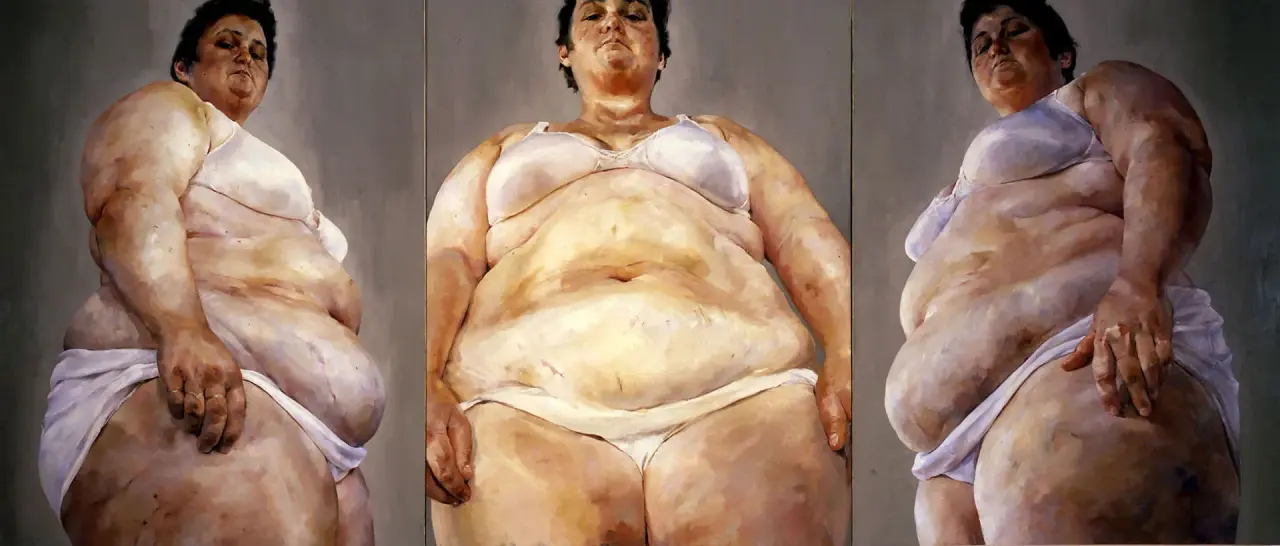
This piece is really striking to me. The woman in the painting looks down at the artist/camera/whatever with a look of disdain, frustration, disappointment, or maybe just seriousness. It makes us feel small as the viewer.
The colors are very dismal, and the artist chose to emphasize her rolls and discoloration, which is interesting to me. In the middle panel, there is some other lighting, though– a little bit of warmth.
It’s interesting because this feels like a very vulnerable position– almost naked, totally exposed, and from a lower perspective which is often dubbed as unflattering. I love that she doesn’t seem afraid or vulnerable, though. The fact that she’s looking down on us makes me feel like she’s sort of judging us for our judgments– commenting on the intense scrutiny we put on others’ bodies. She’s challenging us to comment on her, asking us to just say it. The fact that there are three of her adds to the intensity of that.
At the same time, it reminds me of body checks; there’s an interesting factor of self-judgment and internalizing the hate the world generates as well. It’s like a little progress check. I look at this and get a feeling of both frustration at the rest of the world and yourself for this hate.
Could she just be showing herself off, though? The fact that she wasn’t painted in some sexy, extravagant lingerie makes me think that’s not quite the purpose, but she is definitely gorgeous, and isn’t ashamed in any way.
I have many more thoughts, but don’t know how to put them together. I love this piece, though– a lot.
The Physical Impossibility of Death in the Mind of Someone Living ; 1991 AD ; London, England ; 213 × 518 × 213 cm ; Tiger shark, glass, steel, formaldehyde solution
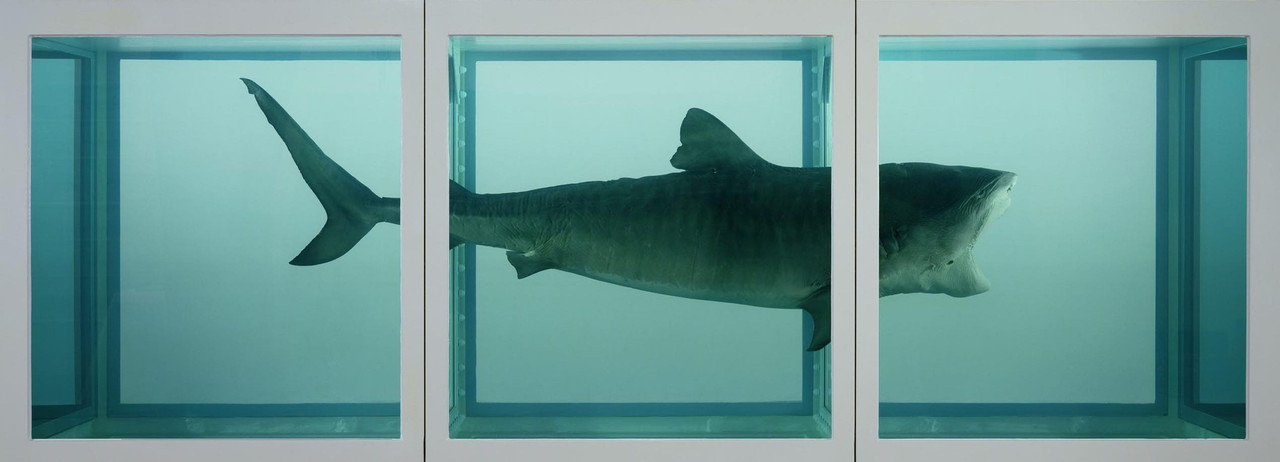
This piece makes me incredibly uncomfortable. The shark’s jaw is open, but it doesn’t feel very scary for some reason? We associate that open jaw with action, but I don’t see any; it’s so still, it’s almost uncanny. Probably because the shark is dead (if it’s real). When I look at it, I get more of a feeling of despair; its jaw is held open, even if it’s tired, and the cage around it holds it in. It almost reminds me of how your mouth gets kept open at the dentist. It’s like it’s being examined– set up to be observed. It might be more terrifying in person, but I don’t know. I just feel sad and disturbed.
It feels so sterile– almost reminds me of a hospital, though the body is being preserved in death (fresh death, specifically) and not in life. If it’s well-preserved (or meant to be preserved at all), then I guess you don’t get to watch it decompose, but that could be interesting if you do get to. It’s interesting that the cage is partitioned into three, calling back to triptychs. Also, cutting off the tail and head makes sense for how you deal with caught fish.
I will also say I’m curious about the choice in shark specifically. Sharks are often symbolic of strength, survival, determination, protection, etc, which definitely says to me that it’s commenting on life and death, and maybe even the way we treat the life around us, but I also feel like it’s sort of misplaced if this was a real, live shark. If it was, then sure, there’s a chance it was found and preserved, or simply taken from a place like an aquarium to be used as art once it died. But I don’t quite buy that, to be honest. It feels less probable.
The fascination, examination this creates is intense. It’s morbid, and absolutely makes me contemplate life and death. If it isn’t a real animal, I’m more intrigued. There’s more room for commentary on markets around animals, trophy hunting, etc.
I’m trying to gather my thoughts on this. It definitely is confronting life and death, regardless of how, but I don’t think I like the art– particularly if it’s a live animal as I expect it is. I’m thinking about how expensive ‘fine art’ is, and how much this sold for. Was it worth it, to hold death in your home or wherever you’re going to display it? Is this ethical? I feel like it’s not. I do think this is successful, though, in some regard; it makes me feel something, if not what he intended.
Kui Hua Zi (Sunflower Seeds) ; 2010 AD ; London, England ; One hundred million hand painted porcelain seeds


It’s genuinely so shocking to me that someone could make and paint so many little porcelain sunflower seeds. I can’t imagine how impossibly long that would take, and how difficult it would feel. I feel like I’d start to feel like Sisyphus after a while– especially if I got to watch all of them sort of blend together into a gray mass as I continued on.
To be fair, I doubt the artist made them all themselves. As with a lot of these artists who do projects of huge scale, I imagine he has a team.
When I heard about sunflower seeds, I thought pretty immediately of my grandpa who loves to snack on them– he always has a bag ready to devour. It also feels sort of communal, because it feels like a very shareable snack. It’s sort of interesting to have something be directly both a snack and a literal seed of life, meant primarily to reproduce. Then, it can’t really sprout life; there’s no room for them to grow and become new and different (like the people sitting in the room) because they’re porcelain! There’s a sense of uniqueness and also sameness.
There’s so many different ways to read this piece– a room full of potential life, yet monotonously gray, or a room full of seeds to share and eat and lay in. It almost looks like snow, sand, or gravel– comfy and odd-feeling. It’s very uniform, simple.
I’m also thinking about sunflowers themselves, now. The way they turn toward the sun is so direct and obvious; they know exactly what they need, what nourishes them. There’s a very deep personal understanding and connection with the world around them.
The colors and feeling of the sunflower seeds mismatches so much with all these ideas and memories I have swirling around them. It’s gray, simple, the same everywhere. They all took so much work, time, and love, but they’re lost among this greater mass. Everything blends into one being.
I’m thinking back to the fact that the artist likely has a team, too. There’s community and shared experiences, and yet it’s all lost to this sort of great project, and even to the main artist who conceived of it. In the end, it’s still viewed as the artist’s project alone.
Preying Mantra ; 2006 AD ; New York, United States of America ; 186.06 x 137.8 cm ; mixed media on Mylar

I’m really amazed by this piece. It’s so ethereal and gorgeous, and I don’t know quite where to begin. Our central figure is lounging playfully in the limbs of a tree— almost trickster-like or seductive. I feel like I’m being invited to play— to guess what this piece is trying to say. It’s begging me to misinterpret it— to dare to.
The body and the space around are both a collage— literally and figuratively. On their body, I love the sort of watercolor look— almost like the pattern of light in water. It’s dappled by sunlight, and it sort of camouflaged with the tree and its leaves behind her. They’re hidden away— a chameleon, and fairy-like. Also, they’re very androgynous; it’s interesting because they have a beard but also have positioned themself in a very “feminine” way. I love it.
I can’t tell quite what’s going on with their neck and behind her head. The thing by their neck feels almost like a spine, but also looks like a pitcher plant or maybe an insect, and the thing behind their head looks sort of like a bird. Her colors and patterns feel like an orchid mantis, too. Is she dangerous? The way the bird overlaps with their head is interesting to me— a sense of flight, peace, divinity in mind.
I love the way the patterns blend together behind them. There’s two main ones that meet each other at this sort of horizon— black, yellow & white patterned hills meeting the pink leaves & yellow sky behind them. It all feels like it’s moving— churning beneath & behind them. Actually, are the hills meant to be a blanket? This makes me question if they’re hanging in the trees at all or if she’s on the blanket. The perspective is odd, so I think I was wrong at first; it looks more like they’re on the blanket with the trees sort of wrapping toward her.
Regardless, the way the blanket/hills meet the leaves and sky makes me feel like there are two worlds colliding. Because of their sensuality as a figure, I’m getting themes of civilization and nature, nature and gender or sexuality, even just society vs. society. I’m not sure— it feels like it’s trying to explore clashes, but then the way overlap & ambiguity exists even still in clashes (with the shared colors between both sides). That also feels supported by the ambiguous gender. The fact that they used a cultural cloth (African, I think— maybe Southern?) beneath them also adds a question of culture and ethnicity for me. The fact that they’re laying back onto cloth is like it’s supporting them, but they also have their hand behind their head, supporting themself.
Stadia II ; 2004 AD ; New York, United States of America ; 108 x 144 in ; Ink and acrylic on canvas

There’s so much going on in this piece; it’s really interesting to me. I don’t know that it’s actually physically big, but it feels like it should be in the same way Rothko should always be huge— overwhelming, all encompassing to your vision. I want it to be wall-sized or larger. I want to have to crane my head to see every little detail— feel like I’m there.
Right away, it reminds me of a stadium, covered in flags and banners, but as if a tornado hit it (ha). Maybe a political chamber space, like for the UN? The lines that make it feel like one of this grand, auditorium-style structures also sort of emulate a tornado, especially with so much chaos surrounding them.
If it is a stadium of some kind, then I can understand the chaos as emulating the loud cheering— happy and angry alike. If it’s a chamber, it could be emulating the arguments & frustration that comes with those conversations. Maybe it’s not just a chamber with only politicians, but like… a political event with a crowd. It could be a performance space of some kind but I just don’t really get that vibe with the chaos & celebratory feel.
I’m curious as to why the artist chose to depict this kind of situation. In any version, there’s a lot of chaos, but I also feel like there’s a sense of commitment to your beliefs & history & culture here— party lines, countries, teams. It all sort of mimics the battlefield with strong nationalist sentiments and hate of the other for whatever reason is imagined. Commitment and love for your people can be beautiful, but this feels somewhat more doomed in my eyes, even with all the excitement.
There’s little dots in the center that feel like they highlight things. Yellow spotlights shine down the middle, and the smaller dots feel like confetti or maybe just other people (is it the ‘losing’ team or politician or whatever, or maybe some otherwise important people). It’s hard to tell what’s what because I don’t have a sense of depth here. There’s a ton of different perspectives and overlapping messy ideas— especially with the charcoal (?) smudges. They feel almost like little plumes of smoke, though I don’t know that they are.
Also, on a personal level, this got me thinking about the upcoming Olympics and the chaos of it. It’s beautiful and exciting, but also sort of terrible in its effects on the surrounding areas— particularly the homeless encampment sweeps that already happen too much and will increase in frequency. There’s excitement and something sort of apocalyptic/dystopian.
Electronic Superhighway: Continental U.S., Alaska, Hawaii ; 1995 AD ; New York, United States of America ; 15 x 40 x 4 ft ; Fifty-one channel video installation, custom electronics, neon lighting, steel and wood
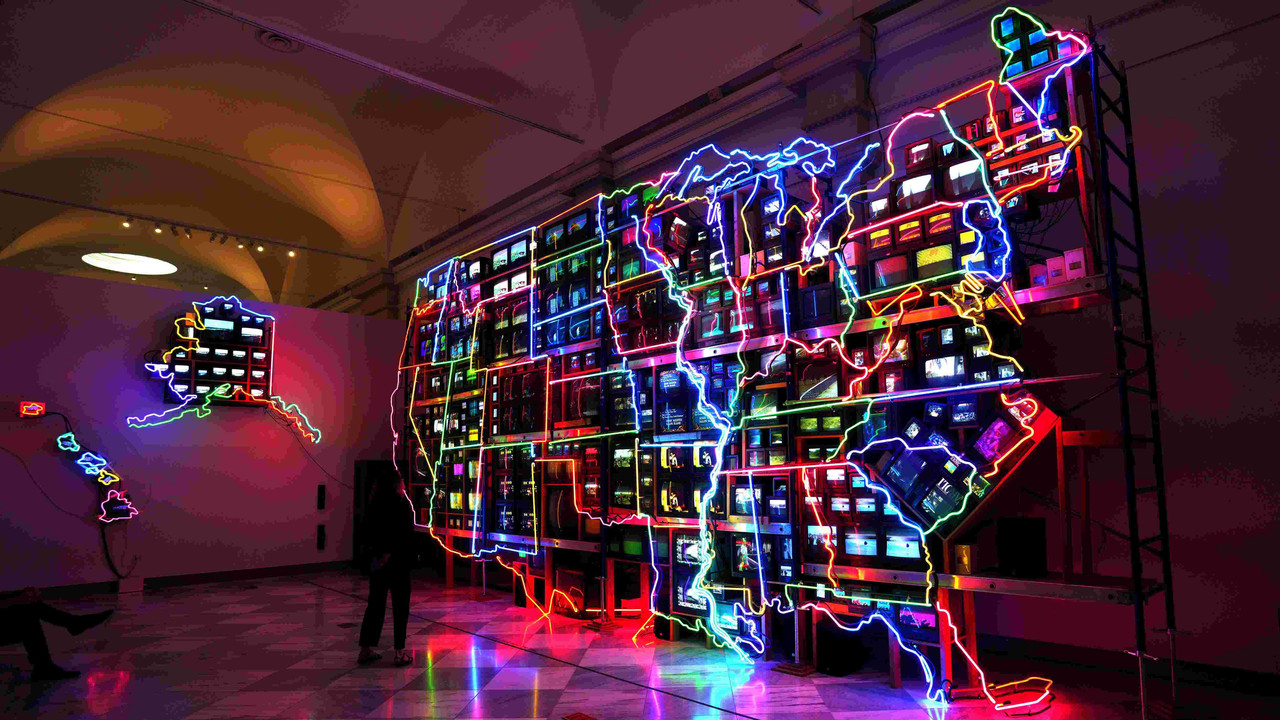
I’m very amazed by this piece. It’s massive and loud— a neon-lit, flickering map of the U.S., buzzing with TVs and electric light. There’s something hypnotic about all the blinking images, overlapping sounds, hum of electricity. It’s flooding your senses with information, exactly how the internet does. It also feels a little sad and tiring, though, like being online or simply staring at screens for too long.
The shape of the U.S. is mapped out in glowing neon tubing, each state framed in color, and each one has a cluster of televisions playing videos inside. They all seem to be specific to their states— clips of moments from their histories, symbols that’re commonly associated with them, or literally just videos of places within them. They have their own mythologies and cultures.
This piece definitely feels like a product of early internet to me, like a warning or a prediction— already imagining the internet as a kind of sprawling, overwhelming thing. It’s a grid of images and signals that connects the whole country but also drowns us in the process. With the start of the internet, there was this push to believe in tech as this unifying force, but this piece doesn’t feel optimistic. It feels chaotic and disconnected. Even though it’s all one piece, the TVs don’t talk to each other. They’re loud but desperate, in their own little boxes.
It also makes me think about the internet as a literal information highway, which was a term that’s definitely thrown around. It’s funny now, how that’s exactly what happened. Travel happens online— not necessarily in the physical world.
Also, a lot of the images in this piece are of the press, which makes me wonder if it’s also a political commentary of some kind— describing the way we’re overwhelmed with information by different biased sources, all clambering for our money and attention. I’d have to think about that more. It definitely feels like it’s a commentary on capitalism in some regard— yes, primarily about the internet, but also just about how everything wants to capture us as a product. We’re being sold to and used.
Generally, the colors are garish and artificial— neon pinks, greens, blues— almost like Vegas signs or cheap motel lights (which also feeds into that capitalism commentary). It gives the whole piece this mood of a performance, like America is putting on a show— for others, but also for its own citizens. We’re watching it on repeat— letting it ensnare us, trapping ourselves behind glass screens. Parts of it are beautiful and wonderful, maybe, but it’s also sinister and sort of exhausting.
Dancing at the Louvre ; 1991 AD ; New York, United States of America ; 73.5 x 80 in ; Acrylic on canvas, tie-dye, pieced fabric border

I’m immediately amazed by both the bright and beautiful colors and the fact that this is a quilt! It depicts people (a family?) dancing in the Louvre, showcasing some paintings that also seem to portray families behind them. It’s a really gorgeous piece, and the strong colors & flowers on the edges make it seem so vibrant and bursting with life. There’s writing across the top and bottom, too. It’s interesting to see this family of Black people dancing in a space that tends to be treated with ‘reverence’— quiet observation— and embrace European art & identity, mostly casting others aside. In that way, this piece is letting its characters break the rules, and it’s breaking the rules by depicting them. They’re centering their own joy, art, and selves in a deeply Western space. They’re sort of rewriting the story of Black people & art.
I think that this could be a direct call-out to the very white supremacist culture of art, especially at such a ‘high’ level. It’s exploring the importance of Black people finding themselves in art even if it’s not already presented for them (with the reflection of the family in the depicted art, which should be reflecting but isn’t quite because of the whiteness) and in just experiencing it at all! But it also feels like it’s just trying to tell a single story— not a general one. This is one woman, a few children. They’re finding their place in art and in a white world in general, and this is just holding space for that. Maybe the writing along the bottom and top imply that specific story/narrative?
I’m curious as to why the artist chose the quilted medium. To me, it feels really sentimental, generational, and even maternal— like history & skills being passed down through mothers & daughters. It’s an act of care. I find it really beautiful, regardless. It’s kind of cool to me that you could literally wrap this story around you.
Pink Panther ; 1988 AD ; New York, United States of America ; 104.1 x 52 x 48.2 cm ; Glazed porcelain

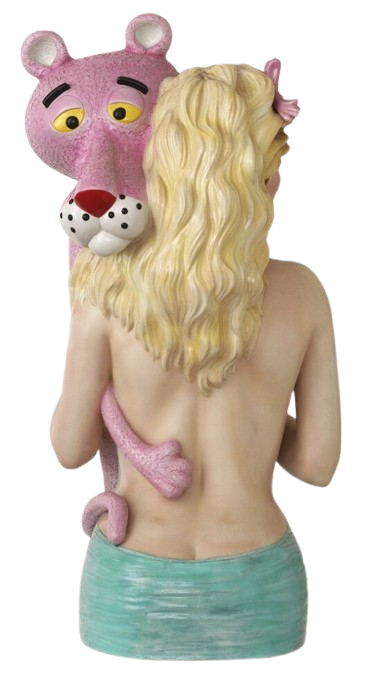
I’m really interested & confused by this piece! It looks almost like a small figurine, though the fact that it only features part of their bodies makes me think it’s probably much larger.
We have this very skinny, blonde white girl in a super tight & revealing dress— covering her breast with one hand and holding the pink panther with the other. At first, I wondered if the pink panther was just sort of awkwardly being held, but the fact that his tail sort of wraps around her hip makes it feel like there’s some possession on his end. It adds this extra level of perversity to it for me. It’s also interesting to me that the pink panther seems so tired; I wonder if this is an expression of Hollywood’s fantasies? Both her & this cartoon are essentially made up for entertainment. I want it to be a critique on consumerism– that we should be ‘happy’ with all that we have, and yet we remain sort of hollow & unsatisfied– but I honestly just don’t get that vibe from the piece. It makes sense logically, and yet I don’t think that’s quite what it’s about.
The colors palette also seems quite old— almost out of a 50s or 60s catalog. I’m curious if this is a parody of works that are sort of nostalgic for a time with less progressive thought, or even if it’s just one of those pieces. It feels like it intends to be provocative. The dress defies physics for the purpose of revealing her body (unless it’s a mermaid tail or something), and she has this incredibly brilliant smile. At the same time, this sort of sexual symbol is paired with a very childish figure— a cartoon! The pairing, and this piece in general, could be sort of insulting to a random viewer. It feels unnatural and like it’s happily reveling in something very wrong.
The Gates ; 1979-2005 AD ; New York, United States of America ; 7053 gates, 23 mile path ; Steel, nylon, and vinyl
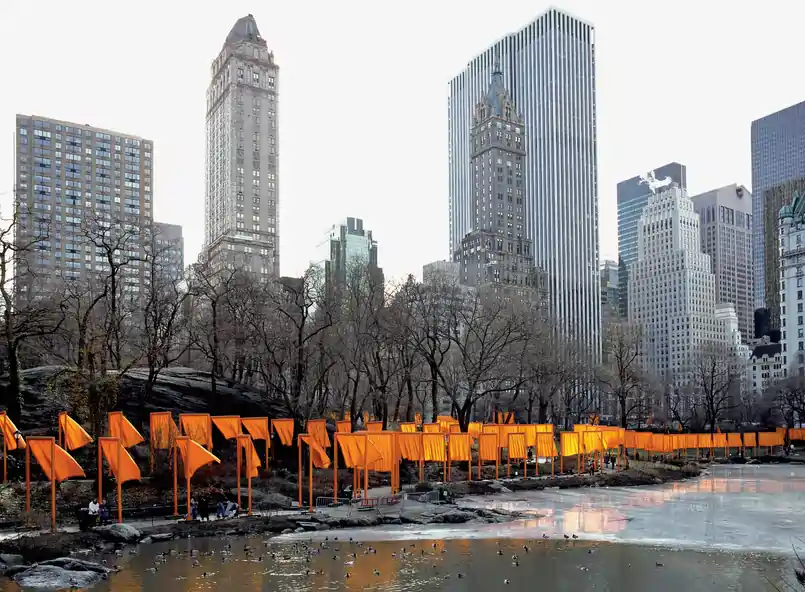

I’m enamored by the brilliance of this piece— particularly in the photo I’m looking at, surrounded by barren trees, gray skyscrapers, and a frozen lake. My guess is that this is in Central Park, but that’s pretty unfounded— the photo just seems similar to photos I’ve seen. If it is, I think it’s interesting because Central Park has an appeal of being an escape from the city into nature; would locals like it? I guess that they might not, though personally I think public art + nature is a very exciting and lovely combination. It’s especially interesting in winter, when people might not be going out and the nature isn’t as traditionally gorgeous. I’m curious if it was a temporary installation (which I feel like a lot of public art ends up being), because then it being in winter is especially important. The piece seems to be lining a lot of pathways so if you were visiting, you might walk through it a lot more than you usually would.
I’m curious how many of these orange gates there are, with their long curtains. Why so many? The curtains seem to end at a really tall height, too; it’s not like we could pass through them while we walk below the gates. They’d just dangle above us. Since the curtains are cloth, I feel like the gates would add a lot of warmth to your walk in the park— especially with the way they float above you like a sun. Photos that show them in the light are beautiful; I adore the way the real sun catches the cloth. It adds this brightness that feels unnatural and natural in different ways.
I’m trying to imagine different people experiencing this art, and I can totally see myself as a little kid, running through them all, treating them like fairy portals to explore. Even as an adult, I think there’s a certain element of transition & new beginnings that comes with walking through a door or gate; it could feel sort of overwhelming but also renewing to walk through so many. I think that’s especially true because it’s winter and soon to be spring, and there’s a lot of rebirth that comes with it. Maybe it could act as a sort of cleansing ritual? I could also see this bringing a lot of renewed appreciation to the park, especially if it was a temporary installation.
Tāmati Wāka Nene ; 1890 AD ; Hokianga, New Zealand ; 101.9 × 84.2 cm ; Oil on canvas
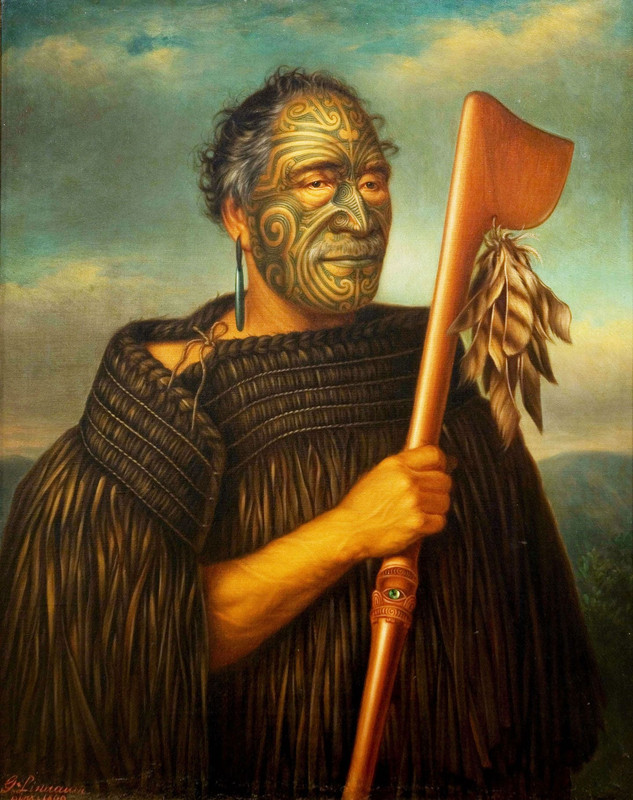
I got the impression right away that this was a portrait of someone powerful— maybe in war, or in governing. Their stance and expression just sort of exude strength to me. The person has traditional Māori ‘tattoos’ which are called moko and meant to represent personal identity and heritage; his are full of spirals that kind of evoke nature (especially when paired with the background being nature and his outfit being full of natural materials). At the same time, the art style is pretty traditionally European, which makes me think they are a Māori chief who’d be involved in diplomacy with the British. Could the person depicted be one who sided with the British? But then I wonder why they’d be depicted with such traditional clothing and expression, and not as more assimilated into whiteness. More than that, though, I imagine it was painted by a European who had some amount of reverence and respect for the person’s culture and self; they might be particularly intrigued by the culture.
He seems to be wearing a very large cloak made of feathers (maybe of a kiwi bird?) alongside some turquoise/jade/greenstone earrings. I’m curious if these have any cultural significance or are simply decorative or a show of status & rank (having nice things). I’m intrigued by the staff, which also seems like it could be a kind of blunt weapon— something that especially would make sense as a show of poetry. It’s adorned with some more feathers and has a little carved hand grip with an eye that I’m guessing is made from abalone.
I love the colors in this piece— everything seems to be reflecting off everything else. The sky is shown in their skin, and the colors are striking yet muted.
I really love this piece, honestly, and feel mostly intrigued by the context/use of this painting. Is it meant to remember him? Is it propaganda? Is it cultural or political?
Chairman Mao goes to Anyuan ; 1967 AD ; Beijing, China ; 220 × 180 cm ; Oil on canvas

This piece feels almost mythical— like it could be depicting a scene of an epic of some kind (the odyssey, beowulf, mahabharata). Obviously this is depicting a man walking, but it also seems to be depicting the idea of a force moving through the world, striding down from a perfectly blue sky. The fact that he’s above the clouds, too— seemingly exploring the tops of mountains— makes him seem like he’s descended from another realm. The mountains also seem to represent strength in my mind, which places him among them.
It seems like propaganda to me, especially as i’m pretty sure it’s depicting Mao Zedong, but also because of this positioning. He’s young here, idealistic, standing above the landscape rather than within it, as if he’s literally elevated by his vision. At the same time, he seems to have overcome the obstacle that is these mountains. His stance is strong and confident, as if he’s pushing forward because he knows it’s necessary. The colors feel deliberate, too— particularly the choice of red in the umbrella (associated with luck, the communist party, and warding off evil) and the path in front of him which symbolizes, I imagine, the world he’s walking into. This also contrasts against the very pastel, peaceful, ethereal background. I’m intrigued about the umbrella/parasol. It would make more sense conceptually as an umbrella (preparing to shelter against difficult weather & resistance), but I also think it sort of has to be a parasol based on looks. I just can’t quite understand the symbolism there.
His clothes are simple— not very ornate— but still quite nice. He’s impressive, but not disconnected— a worldly man despite the insinuation of leadership and status in this portrait. Maybe it’s the clothing of a scholar or politician? That choice, though, feels similar to the fact that he’s been put in nature, in order to imply his connection with the world around him.
Generally, though, he seems sort of untouchable— determined with a closed fist and a concentrated look. It reminds me a bit of old religious paintings, where saints stand just a little too still, glowing— their expressions too serene for real life. It’s not about capturing a moment as much as it’s about shaping a legacy. At the same time, it’s super realistic! It’s not trying to totally depict him as other and different. It feels like a court painter’s work in Europe.
Under the Wave off Kanagawa ; 1831 AD ; Edo, Japan ; 24.6 × 36.5 cm ; Polychrome woodblock print, ink and color on paper
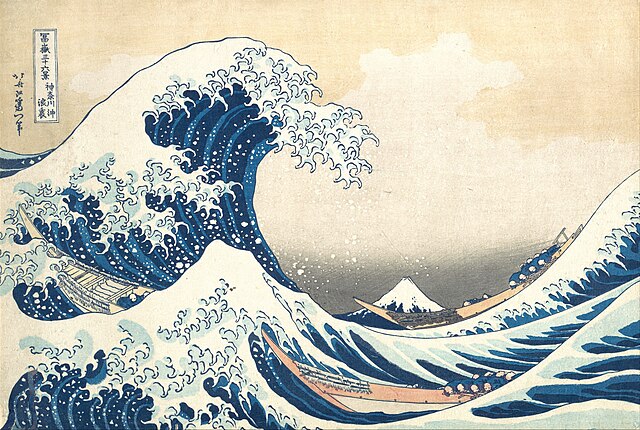
This piece is so incredibly famous, it feels hard to really look at it. My brain just goes “oh yeah, I know that one– moving on” and tries not to look any deeper. But I do feel that, forcing myself to really look at it, I’m hit by how actually huge this wave is. It seems alive, curling in on itself– barely holding together before a collapse. It seems clawed and hungry, but also sort of slow– so enormous, it can’t move any faster. There’s such a tension in this moment before the crash.
Mount Fuji is so small in the background, it almost disappears. Obviously, to some extent, it’s just about perspective, but it also definitely tricks your brain for a second. Is this wave that big? Just maybe. And the mountain is a symbol of permanence and stability, but it looks delicate and is somewhat forgotten in favor of the chaos in the foreground. At the same time, it’s sort of untouchable. It’s far, and no matter how violent the waves get, it will stay standing. There’s almost a theme of perseverance here.
The boats and the people in them add to that. Three long, thin boats– fragile-looking, too– that are riding the waves as if they’re a part of them. The fishermen inside are only slightly visible– hunched over bracing themselves and seeming almost exhausted in the vague impression of faces that they have. I’m intrigued by the choice to paint their clothing in that beautiful Prussian blue, too. It gives them a sense of unity with the chaos they’re enveloped in; yes, they’re victims of it, but they’re also part of it. And the golden ratio in this piece makes that even stronger. Everything here is wrapped up in the rest. They also don’t seem to be trying to escape (even if it would be hopeless to try)– embracing the danger and pushing forward. It’s necessary!
The print seems to be a woodblock print, likely from the Edo period? Essentially, this isn’t one of a kind; it’s reprintable, meant to be experienced by regular people. It makes sense that a piece like this– beautiful and striking, yet speaking to the perseverent values of these hard-working regular people– is something they would want in multiples! Also, Edo-period Japan was relatively isolated from the world– peaceful, yet under relatively strict rule– so I can imagine pieces that explore new places (and travel destinations like Mount Fuji) alongside maybe unfamiliar chaotic situations would be interesting.
Jahangir Preferring a Sufi Shaikh to Kings ; 1615-18 AD ; Mughal India ; 46.9 x 30.7 cm ; Opaque watercolor, gold and ink on paper
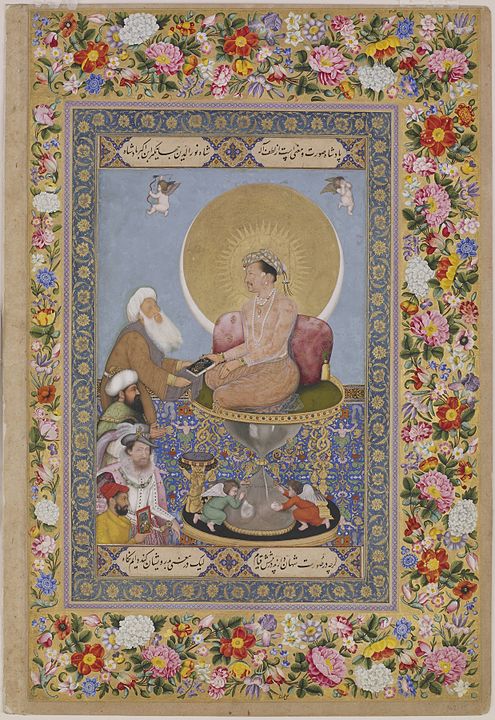
The first thing I notice here is the hierarchy, how the focal point person sits on this elevated platform– literally, a giant golden hourglass haloed by a sun and moon– physically above the other figures, glowing in a halo of gold and flames. The composition is very carefully arranged, all the characters seeming to spiral up toward this moment of exchange– the seated man offering a book to the person kneeling in front of him.
I’m trying to guess at the historical context of this (channeling AP World History to help me analyze this clothing…) and want to guess that this is a Mughal piece, with the man who’s receiving the book being some sort of religious figure (maybe a sufi?) and the others being a sultan, a European who’s rich in some way, and an Indian person (the artist, maybe, since he is depicted with a painting in hand). Everyone else is below the sufi physically, though– even the European, painted with delicate realism, who honestly seems sort of offended. To me, that signals that this piece is almost entirely about hierarchy– about the main man (maybe a Mughal king?) choosing spiritual wisdom over political power. It’s absolutely some first class propaganda.
I only mentioned it vaguely here, but the hourglass takes up a really huge portion of the canvas and is a really interesting choice. Time is literally running out beneath the king, which feels like a massive statement for a king to make. This isn't just a casual seating choice; it’s a visual metaphor for the fleeting nature of power and life itself. Still, though, the king isn’t panicking. He’s above it, glowing with his sun-and-moon halo, as if transcending time itself. There's an almost divine permanence implied in his stillness, despite the fact that, beneath him, sand is slipping away. He’s acknowledging mortality while also asserting something eternal.
Below him, too, there are the tiny cherubs at the base of the hourglass who add another layer of divinity, as if he’s being supported by them. I honestly can’t tell what they’re doing, either; it seems like the one on the right is writing his name into the glass, but he also holds a jar I’m curious about. Also, why these European cherubs? Is it meant to show a sort of global influence– that he is involved everywhere?
The piece really does feel over the top in the best way. There’s an impossibly intricate floral carpet, the throne is decorated with delicate Persian-inspired inlay, and everything is edged in gold. I love how the borders of the painting are just as much a part of the art as the scene itself– flourishes of plant life, text that makes it feel like a page from a royal manuscript. It’s definitely Mughal, but there’s Persian and European influence woven into it, especially in the shading of the faces, the way volume and dimension are rendered.
Shiva as Lord of the Dance ; 11th century ; Tamil Nadu, India ; 68.3 x 56.5 cm ; Bronze

I know this piece! Very well, actually— I think my dadi has one by her bath. It’s a depiction of Shiva called Nataraja, where he is the Lord of Dance doing his divine and cosmic dance. This depiction is incredibly well-known, and in most Hindu temples. I think the common understanding is that this is the state he is in when he performs his duties of creation, destruction, and preservation.
In this depiction (and in most), he’s enveloped in a ring of fire, holding the flame of destruction in his upper left hand. His hair stretches out to both ends of the ring (seemingly representing the universe, cycles, the eternal, continuity, unity, connection) and sort of emulates a halo, and he holds a drum in his upper right hand. The fire is interesting as well because yes, it destroys, but it also has healing capabilities.
The other hands are mudras that represent things I can’t quite remember! I’m going to guess that the forward-facing hand is meant to comfort and make clear that the viewer is safe as I feel the forward-facing hand usually does, and the other hand shows gracefulness and peacefulness in his dance. He’s also balancing in tree pose, which obviously connects to the balance he is meant to uphold. Also, Shiva is dancing upon and crushing Apasmara, who is the demon of ignorance.
He looks incredibly tranquil throughout this process, which I love— a serene smile on his face and his eyes closed calmly. Even though there’s a lot of chaos involved with this, it’s like… doing what needs to be done. It’s not good or bad; it just is.
Funeral Banner of Lady Dai ; 180 BCE ; Mawangdui, China ; 205 x 92 x 47.7 cm ; Painted silk

I absolutely adore the colors in this banner. The reds and blacks make it feel so intense and important, though not necessarily bad, as red could signify good fortune moving forward and black could just be symbolic of the unknown/unknowable and even peace.
I can definitely see several layers in this piece. In the center-ish region, we see a person standing in robes, leaning upon a cane, surrounded by attendants. Underneath them, these very long dragons’ bodies are entangled and reaching toward the sky above. The sun and moon in the top section alongside this gives the impression that they’re in heaven or maybe a dream of some kind? But I think heaven is more likely, meaning that this piece would likely have some sort of commemorative or funerary/ceremonial use. If it is funerary and not just a memorial, then is it meant to identify them? Does it have a spiritual/religious role to play, like maybe the book of the dead?
Below the dragons, we see people sitting quietly (I imagine) with some vases in front of them, perhaps to hold food or some other things. Behind them, I can see a little of what looks like their robes. I’m not sure if that’s just background detail or if it’s meant to be them (their corpse?) and is either faded or just hard to see. Below them, there’s a weird creature… it’s very marine to me, like some sort of squid monster.
A lot of animals inhabit this piece— particularly the tortoise and fish with owls on their back near the bottom, and then moving upward. At the top of the piece, which we identified as heaven (or some sort of dream world), there’s a lot of sort of… mythological exploration. We see a sun (with a crow? or other dark bird) on one side and a moon on the other, likely signifying balance. We see the heads of the two dragons, and what looks like two horses with something riding them? There’s also two people who seem to be guarding the realm alongside the dragons (which are also meant to be an embodiment of all animals, sort of representing everything).
I’m honestly pretty overwhelmed by this piece. It seems to be telling a story more than making a claim about immortality during life or something. I’m not sure what its use is. If it was a funerary banner, then I’m curious about why it exists.
The Court of Gayumars ; 1524-25 CE ; Tabriz, Iran ; 45 x 30 m ; Opaque watercolor, ink, and gold on paper

I’m really impressed by the beautiful color in this piece; especially with what looks like watercolor. It’s so bright and well-placed and really draws my eye around the whole piece little by little. It’s interesting to me because the placement of the men/people reminds me of that within a court of some kind, with the man in the center sitting in padmasana in a sort of ‘throne’ and the others standing at attention all around him. That said, it clearly can’t be a literal one as they’re very intertwined with nature instead of being in some palace setting– sitting upon cliffs and trees and grasses, and among animals. The animals themselves almost feel part of this community with the way they’re placed in this circle of people; there’s absolutely a sense of unity and harmony there. Also, it’s interesting that so many people are directly lined up but there are a few groups that are separated. Is it hierarchical? It has a lot of flow and definitely feels like it’s constantly moving and changing.
Maybe it still is a court of some kind, but a mythical one? Like… if it’s storytelling, then maybe this is a king of nature (or just among and in harmony with nature). It could also be a god of some kind, though that makes less sense to me culturally if this is Islamic (or West Asian in general), which is something I assume because of the Arabic script/calligraphy along the top and bottom of the piece. I also think this script really emphasizes that this could be a story or an attempt at informing/history. It’s likely part of a book of some kind, though I’m curious as to what kind.
I’m also curious if this could also be some depiction of heaven or enlightenment or some other space you could reach with time and work? Is this a place you can go or that exists/once existed? A utopia– imaginary or real? The focal point character is sitting in padmasana, as I referred to earlier, which also makes me think this could be more religious. There’s so much color and energy around him specifically; could he be a kind of leader other than a king, but I imagine he’s both a spiritual and actual ruler.
The yellow (gold?) in the sky makes this feel like a sunrise which definitely adds to that sensation of this being a beginning/dawn of the world, civilization, or just… something new. I’m not sure what. I love the detail in the greenery as well, and I’d love to take a closer look at that top left corner.
Kaaba ; pre-Islamic monument, rededicated 631-32 CE ; Mecca, Saudi Arabia ; 15 x 10.5 x 10.5 m ; Granite masonry, gold, covered with silk curtain and calligraphy in gold and silver-wrapped thread

This is the Kaaba— the holiest shrine that exists in Islam, and the destination of Islamic pilgrimage (the hajj) for all who are able in their lifetime. In Islam, five-times daily prayer is done in the direction of Mecca and the Kaaba rather than Jerusalem, and the direction of these is marked in all mosques. When people do visit the Kaaba, they circle it seven times and often kiss the Black Stone or al-Hajar al-Aswad on the eastern corner of it (believed to have been given to Ibrahim by the angel Gabriel).
Muslims believe that the Kaaba was constructed by Ibrahim and his son Ismail, and that when Muhammad returned to Mecca after being driven out to Medina, the Kaaba became a central space in worship (and thus pilgrimage).
This is just some of the story of the Kaaba, but it’s undergone many renovations and changes and looks little like what it once was! Now, it’s an incredibly unique religious structure. Its solid gold door is absolutely gorgeous and incredibly detailed, and a large black cloth covers the rest of it as a way to show respect and reverence to the site (which makes sense, with how much covering and modesty is emphasized in Islam). My guess is that the door and embellishments around it are covered in calligraphy of Quranic verses, but I couldn’t be sure. I also don’t remember if it’s legitimately restricted entry (outside of being restricted to Muslims) for any reason other than preservation of the Kaaba, and I’m curious to know more!
I’m also curious about the color symbolism. Was a black chosen for practical reasons like its ability to hold up, or is it more symbolic? Maybe exploring evil or just potential and the unknown. Most people who visit wear white which seems like it supports that idea. Also, if I remember correctly, people believe that al-Hajar al-Aswad is now black because it has absorbed the sins of the people who touched it and was once white, which again makes me think that this blackness represents both unattainable things and sin. The gold could also represent the sun, god, wealth, divinity, and so much more. It being a cube is interesting to me; it wasn’t always one, but why was it designed that way later on? Is it something about balance?
Veranda Post of Enthroned King and Senior Wife ; 1910-1914 CE ; Ikere, Nigeria ; 152.5 × 31.8 × 40.6 cm ; Wood and pigment

This piece, to me, is reminiscent of a family portrait. It’s made of wood, which is interesting, because it was important enough to create but not important enough to be made in stone to last forever. The fact that the person in front is sitting on a huge chair (throne, I imagine) with servants at his feet (small due to the choice to use hierarchical scale) makes me think he’s a king. One of the servants seems to be playing a musical instrument which intrigues me! The king’s feet are also kept from touching the floor which, if I remember correctly, is often a custom for rulers throughout the world. The crown is definitely really elaborate which interests me; I’m curious about the symbolism within it. There seems to be a bird atop it, maybe symbolizing transformation and ingenuity?
The woman behind him, I imagine, is his wife (or perhaps the most important one). It’s interesting to me that she’s depicted standing and seemingly much taller than he is. Would that not make him lesser? Is it to make her seem like a powerful nurturing figure? She’s blue, so is it like in Egyptian art, where she’s meant to be a goddess or a spirit of some sort? Or just supernatural in some way? Are women just viewed as more important in this society? She has very emphasized breasts which definitely leans into the idea of fertility and motherhood to me. She’s wearing a very elaborate headdress and wearing beaded bracelets (coral?) that match her husbands’. She’s also connected to him through her hands on the back of his throne. I wonder why she’s baring her teeth. I know it’s hard to keep them clean & healthy, so maybe it’s a symbol of wealth or status?
Bundu Mask ; 19th-20th century ; Moyamba region, Sierra Leone ; 47.9 x 22.2 x 23.5cm ; Wood, metal
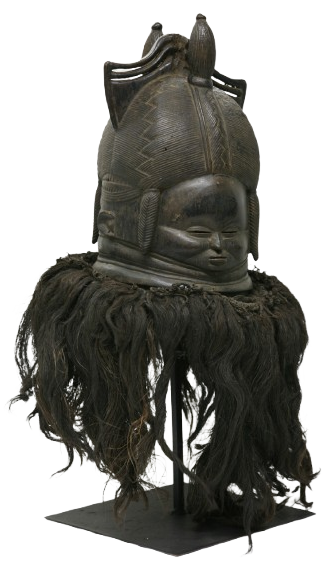
I’m really intrigued by this piece although I don’t know exactly what’s going on with it. It’s obviously a bust of a person, and their facial features are very small— almost like a baby’s or an old man’s. The figure has this very large helmet on and the artist used some sort of hair from the bottom of the helmet as if to create a sort of poncho/shawl. It honestly looks very nice, though, which gives me the sense that the person they’re portraying has power and wealth (a sense I also get because they have a bust of them). The sort of vague waviness of it makes me think also, though, that it isn’t quite human— more like a spirit. The helmet or headdress reminds me of the dress of a general/decorated officer. It could also simply be hair with a smaller headdress (or simply an abstract representation of hair) and even necklaces or just neck fat, in which case I don’t imagine it’s a general, but still someone or something powerful. Even the idea of it as a helmet feels ceremonial, though— it’s not like a general wears this all the time.
I’m curious as to what the small face represents— or it could be more that the head is big (thus representing great intelligence?). The sort of squinted face also does give me a sort of wide and dedicated energy, likely because of its aged look. It also feels like there’s a sort of smirk in there because of the smile lines, which I’m curious about. Again, I just keep coming back to ‘why that expression?’ It’s interesting that the features are so small and fragile, though— is this meant to be a woman? In general, the piece’s strong ambiguity makes it seem to me like it’s most likely a spirit of some kind.
Wall Plaque from Oba’s Palace ; 1550-1680 CE ; Benin, Nigeria ; 49.5 x 41.9 x 11.4 cm ; Brass

This piece is incredibly striking! It seems to be depicting some sort of king or ruler and his attendants using brass— the king being the largest figure in the center with lots of jewelry and riding sidesaddle on a horse. There’s a lot of symmetry in the piece, so it’s interesting that he’s riding sidesaddle. Is it ceremonial? Also, that his jewelry is covering his mouth is interesting; it’s reminiscent of the ‘speak no evil’ sort of imagery. The others in the image scale in size likely based on importance within his court (two really small ones near the top and at his feet, slightly larger but child-sized ones beside him, and two almost as large as him shading/shielding him). Their heads are huge, which is interesting; is it trying to emphasize their intelligence? I’m also curious if the two shielding him are doing so from battle or the sun. They all have these very serious and intense faces, like they’re doing something important. I wonder if it’s meant to be a specific event or representative of the leader’s rule, maybe?
There are some interesting floral motifs behind them that I’m curious to know more about. Each is only four petals— maybe bearing resemblance to the cross? Is this post-trade/colonization work? Come to think of it, it’s likely that the horse was traded as well and he learned sidesaddle as a result of trade, so I wouldn’t be surprised if Western influence had made a huge impact on African art already by this time. That said, the flower could also be trying to express a flourishing kingdom/army and emphasizing his growth and power as a leader.
I’m intrigued by the differences in their regalia. I know it’s meant to differentiate status, but I want to know the specifics! I also wonder what the point of this piece is. Is it meant to tell a story? Be a display of power? Commemorate leaders? If so, were there more of these plaques? This one is pretty high relief and seems intended to hang up like a tapestry.
Bandolier bag ; 1880s CE ; Wisconsin, United States ; 87.6 x 30.5 cm ; Wool and cotton trade cloth, wool yarn, glass, metal

This bag is truly mesmerizing. There’s an immediate sense of movement in the beadwork, like the designs are shifting just beneath the surface. The symmetry is striking, but it isn’t rigid— it feels organic, like the shapes are growing into each other rather than just being mirrored. There’s something about the patterns that reminds me of botanical imagery like flowers/plants and even butterfly wings, in parts, and there’s also a softness in the color choices. I’ve just noticed, actually, the face in the center! There seem to be arrows pointing in toward the sides of the head, so it could be focusing on listening and storytelling in some way. I’m not sure, though. The beaded tassels at the bottom especially add a kind of fluidity, like a fringe swaying as someone moves.
I definitely wonder about its owner. The piece is obviously Native American— a guess says maybe Ojibwe? I can imagine someone wearing it across their chest, the bag resting at their hip. I’m curious if it’s meant to be everyday or more official? Is it used in any specific job? Beadwork is intricate and beautiful, but I also think it’s easy to forget that it’s somewhat everyday, too, just because it doesn’t seem everyday to our own tastes. At the same time, beadwork always feels really powerful to me— like a form of storytelling, even if I don’t have the language to fully understand it. I feel like the choices— certain blues, pinks, browns, the way the motifs interlock— mean something specific, that there’s intention behind it beyond just “this looks nice.” The contrast between the bright, angular bands of pattern along the strap and the slightly softer, more intricate design on the bag itself makes it feel dynamic, like it was designed to be seen in motion.
And looking at it makes me want to touch it— imagine the cool smoothness of the beads, the tightness of the weave, the slightly rough edges of the tassels. It’s fascinating how beadwork does this, how something so small-scale, piece by piece, can create a textile that’s both durable and delicate, solid yet shimmering.
Thunderbird Transformation Mask ; ~19th century ; somewhere near Alert Bay, Vancouver Island, British Columbia, Canada ; 78.7 x 114.3 x 119.4 cm open, 52.1 x 43.2 x 74.9 cm closed ; Cedar, pigment, nails, leather, metal plate
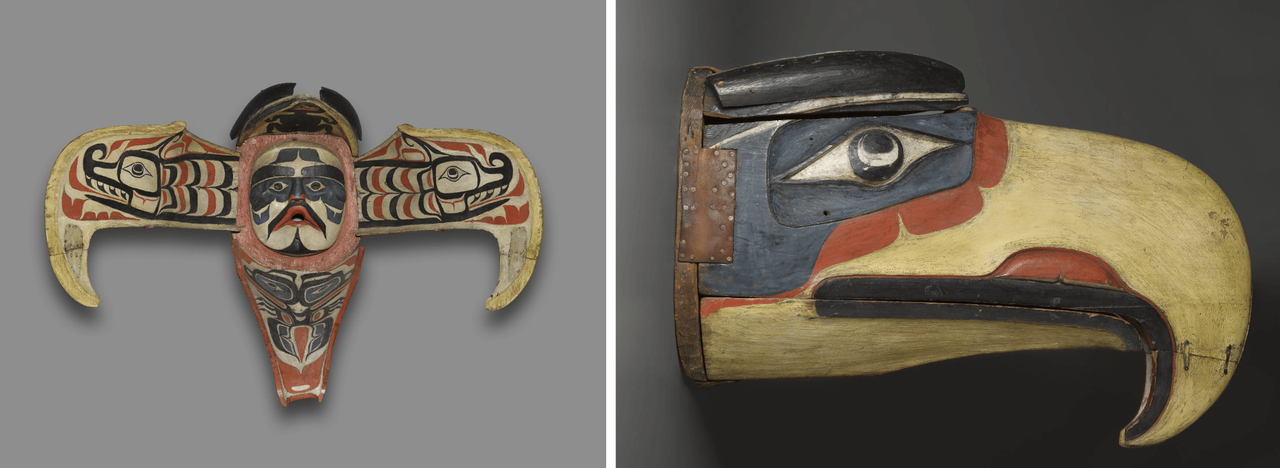
I’m really captured by this piece. The colors are so beautiful and every line feels precise and intentional. It almost feels alive, like it’s watching you just as much as you’re looking at it. It’s not just an object, but something more— like maybe a story, a ritual, a performance frozen in two frames.
I love how the reds, blacks, yellows, and blues pop against each other, almost vibrating, while the symmetry of the design feels like it’s holding chaos at bay. The fact that the face moves— opening and transforming— gives me the sensation that two worlds are colliding, with inner and outer faces telling completely different stories. It really does feel like it's meant to tell a story— maybe through ritual or dance? Its opening up reveals this new perception as if some new aspect to the story has happened. I feel like it could be showing a supernatural experience— like an encounter with a god that at first presented as an animal. I also wonder if it’s meant to tell new stories or retell old ones— an aid for myths to be passed down. If it is for ritual, I imagine the second.
I’m curious as to what’s going on inside the mask, though. I don’t really get it. It seems like a man has these two snakes/creatures coming out of either side of his head. This could be a depiction of a god, or maybe it’s meant to tell some other story I’m just not aware of. Are the creatures behind him, closing in? Aiding him?
Calendar Stone aka Sun Stone ; 1502-1520 CE ; Mexico City, Mexico ; 12 ft diameter x 39 in thick ; Basalt

I know this piece; it’s one of the most famous Mexica pieces I can think of! It’s massive, which this photo doesn’t show, but is very impressive, and its size gives it a sort of undeniable energy— as if it was made to be seen, to demand attention. Looking at it feels almost like I’m being pulled into the past, but not gently. It’s loud, with all its intricacy. Every inch of the stone is carved with something deliberate— figures, patterns, symbols— and that density feels like it’s meant to remind you of how much this object holds. History, time, and cosmology are all there, if layered and heavy.
The central face, which I think could be Tonatiuh (sun god, given that it’s literally the center of the sun), stares out with this sharp, almost demanding expression. Its tongue is shaped like a blade and feels a bit aggressive, but I imagine that’s the point. I’m not sure of what all the symbols that surround it mean, but I can infer. Obviously there’s the central face (who’s holding something in a tight grip in each hand), and then there’s other ‘gods’ or at least figures of some kind right around the sun face. From there, you can see some smaller figures of animals that could represent the rest of the world. But it also feels like it’s not trying to portray everything statically— it’s a circle, cyclical, and feels like it’s exploring those cycles of man & empire. Violence, war, love, nature, relationships in general. Something like that. It’s also clearly directional, with its little spikes! It’s trying to give a history— a calendar and a catalogue in one. That makes me wonder if it could be state-sponsored?
I can’t stop thinking about the way the circles radiate outward, too, like ripples in water. Each ring seems to have a layer of knowledge— about the universe, their gods, the sort of order of the universe. The glyphs and figures carved into those rings are so precise, so carefully done; it’s as if every piece has its own story.
I feel that aside from being a calendar, this could be a tool of ritual. It’s already pretty clearly a way to mark time and history, but also a reminder of sacrifice, of the balance between gods and humans, of the literal lifeblood that kept the world moving. You can almost feel the weight of that belief system, how deeply interconnected everything is.
Moctezuma’s headdress ; Made before 1596 CE ; Unknown City, Mexico ; 46 in height x 69 in diameter ; Gold, Feathers of Quetzal, Lovely cotinga, Roseate spoonbill, Piaya cayana

This headdress immediately draws the eye in with its radiating pattern of vibrant green feathers, edged in blue and anchored by reds and golds at the base. It looks very regal— a piece crafted with immense care and meant to be worn by someone powerful and significant. I’m curious if it’s more of the level of a king or a God— maybe someone who’s both? I say that because the symmetry of the design, paired with the richness of its materials (feathers, gold/jewels), gives me the impression that this wasn’t made just to impress but to actually elevate the wearer to another level. It also seems to be an Aztec piece just based on design and aesthetics.
The feathers are very long, soft, and carefully layered, and they seem to be quetzal feathers. They add to the feeling of rarity and divinity since quetzal birds were sacred in many Mesoamerican cultures. This specific piece could be a reference to Quetzalcoatl. Either way, it’s not just decorative; it’s symbolic. The green of the feathers could represent fertility or life, while the gold at the base ties it back to power, wealth, and the sun. The reds might evoke blood, sacrifice, childbirth and thus life, or the earth. The turquoise was likely associated with both fire and young warriors and rulers because of the god Xiuhtecuhtli. The whole piece comes together like a story— and very much one of power.
I already said I’m not sure if it’s meant to be worn by a ruler or God, or maybe even someone representing a deity during a ceremony. Regardless, though, it feels larger than life, like its purpose was to bridge the wearer and the divine. There’s a weight to that idea— that this headdress might have been central to something spiritual or ritualistic, not just a marker of power but a tool for connecting to something greater.
It feels overwhelming to look at, not in size but in the amount of detail and meaning packed into one object. There’s a sense of reverence in how it must have been made, as though each feather and bead was chosen with intent. And even now, removed from its original context, it still carries that energy; it feels like it’s watching us as much as we’re watching it.
Coyolxauhqui Stone ; 1473 CE ; Tenochtitlan aka Mexico City, Mexico ; 10.5 ft diameter ; Volcanic stone

I feel like I have a bit of an unfair advantage with this piece, having more knowledge than most about Mexica/Aztec culture and myth. This seems to be depicting Coyolxauhqui (Bells Ringing On Her Cheeks) having been dismembered and decapitated by her brother Huitzilopochtli (who was birthed by his mother for the sole purpose of fighting those of his siblings who wanted to kill her) because of her plot to kill their mother, Coatlicue. She’s fairly naked, which I imagine would be viewed as shameful, which is also interesting because her initial reason for killing her mother was shame and disgust around her mother’s own pregnancy and sexual activity.
I could see this disc being a monument of some kind, as it’s very high relief and technical and recounting this myth could serve as some sort of lesson. I wonder if it’s a warning, though– whether to the people of the Mexica empire, the people of conquered city states, or even just flat out enemies. It’s clearly recounting an intense story about betrayal and the consequences, and I could imagine it working well to try and warn/repel others from rebelling or starting anything, really.
The piece itself is really beautiful. Coyolxauhqui is looking upward– maybe in repentance or hope that something might save her– but she also seems to have accepted this fate. She has a snake belt around her waist, with a skull tied to it on one side, a beautiful headdress, and bells on her cheeks– all classic symbols to identify the figure as her– but I’m not sure if there’s anything more that these symbols are meant to mean about her (except her snake belt, which I think she got from her mother). I think it’s interesting that she also keeps her snake belt despite the clear attempt to humiliate her– she keeps this aspect of her mother but also her nobility. I do know she’s the goddess of the moon and milky way, but the rest of her symbols don’t seem explicitly related to that.
Great Serpent Mound ; 1070 CE ; Ohio, United States ; 1300 ft. length ; Earth

This is a truly huge monument! I’m really drawn in by its serpent-like form, and also curious how it was made. Honestly, all landscaping that changes the land itself is kind of beyond me. It weirds me out in a cool way.
I love that this sort of needs a far-away eye to really see what’s going on. Walking alongside it would make it harder to get the full picture of the monument. This makes me feel like it’s likely not art for the sake of art, but maybe something more important. I know serpents are pretty important in a lot of Indigenous cultures and thought to have some sort of supernatural, magical, or even just medicinal powers, so the choice of the serpent could be to signify health and magic for the land, maybe? Or maybe it was meant to be used as a site for rituals? It could also be a path to walk for reflection or something like that… I’m not sure!
The fact that it’s a crescent is really cool to me, too, and makes me consider ties to the moon, planets, and space in general. Could this be related to seasonal celebrations or beliefs?
I honestly don’t have a lot to say on this one, but it’s really beautiful to me. It makes me feel small, and I’d love to see it in person. Truly an interesting monument!
Spiral Jetty ; 1970 CE ; Rozel Point, Box Elder County, United States of America ; 15 ft × 1500 ft ; Land art sculpture with salt crystals, basalt rocks, and mud

I know this piece and love it deeply! This is a land sculpture that exists in Salt Lake City, Utah, and is made (if I remember correctly) primarily of basalt stone and soil. I’m a huge fan of artists who interact with nature directly in their work, and this piece is no exception!
The piece definitely seems to be commenting– to an extent, at least– on humans intervening in natural spaces and how that affects said spaces depending on how intentionally we move through them. How can we do things that leave less impact? Is less impact the goal?
The artist decided to create a spiral formation– a symbol that often represents rebirth, growth, progress, time, evolution, etc, and also aligns with concepts of mother nature and the sun in many cultures– feeding back into this theme of interaction with nature and the slow progression & change that occurs in nature with time. Spirals are also prevalent in nature a lot, too (golden ratio!), so it makes sense they’re associated with mother earth. It also makes me think about how we’re speeding up those changes the more we interact with the earth in a selfish and greedy way (climate change… yay…). I wonder if selfish is even the right word– is it selfish to do something that will eventually hurt us, or is it just self destruction? I guess that depends on whether you view yourself as part of humanity or a whole separate being.
Anyway, I think the choice to use materials like rock and soil in a piece like this, especially one that resides in water, is a really strong and interesting one to make. It transforms the art into something that will inevitably change with time and constantly renew itself, which stands out to me also because of that spiral form of this piece. I’m sure it would transform on its own regardless (whether it means algae growth, animal interference, even tourists taking rocks), but this definitely makes it more apparent. Water level could hide it or leave it entirely open. One day, it’ll fade and disappear entirely through erosion, the same way we do. There’s a huge theme of impermanence and transience here, asking us to accept that. But I also don’t think it’s suggesting that’s a reason to let go and not care. It’s asking us to keep in mind our impermanence, too, and know that the world moves on, and we need to make sure it’s able to. It’s a reflection on mortality, too.
I imagine approaching this piece in person; it sounds peaceful and beautiful. The lake, sky, and mountains span out beyond you and you can simply walk this spiral and let it sink in. The smell of salt and algae might catch your attention. You’d become part of the art itself, too– completing the work. You’d never see the spiral from above the way you might in a photo. It’d be a very meditative experience. I also think this is interesting, as it sort of breaks down the boundary between nature and human. I recently read Wandering Stars by Tommy Orange, which explored the idea of us as the earth, not just ‘on’ this earth (a concept very common in Indigenous cultures, though I loved this specific phrasing of it). Especially because the piece asks us to be part of the art if we’re to visit it, I think this really feeds into that idea.
Tilted Arc ; 1981-1989 AD ; New York, United States of America ; 120 ft x 12 ft ; Steel sculpture
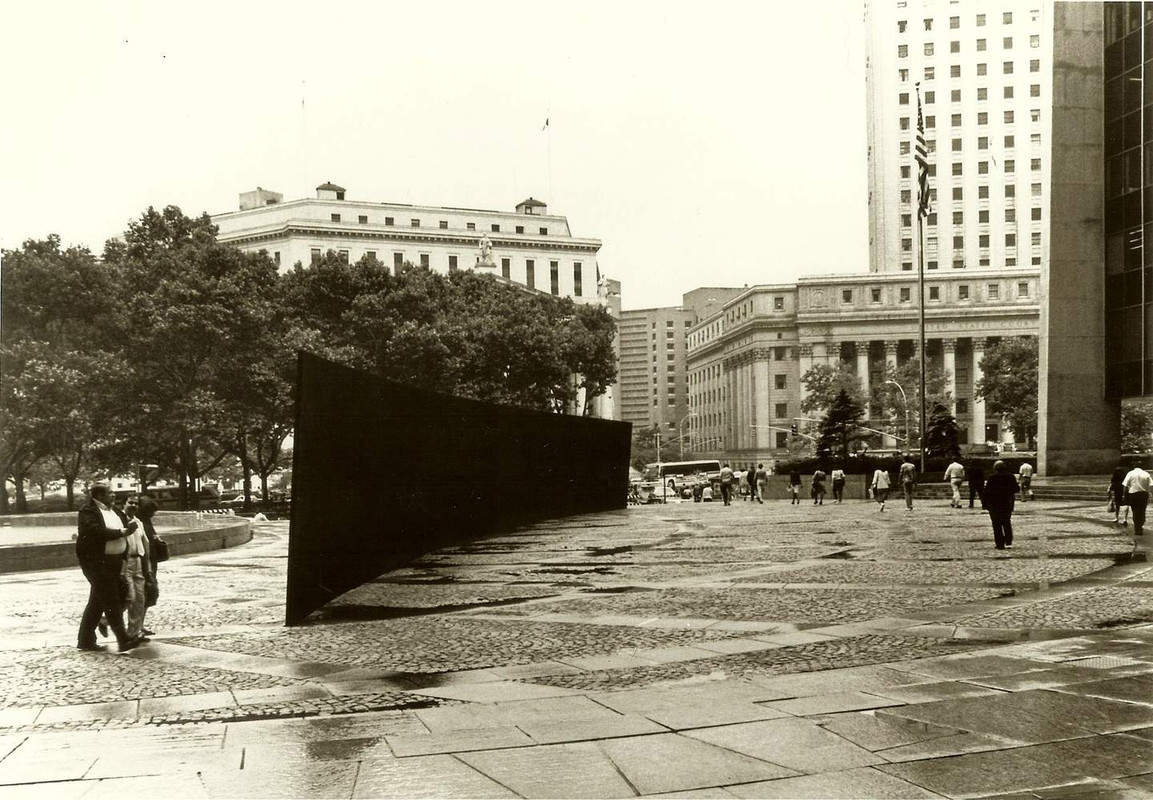
This is such an interesting piece. The first thing I’m struck by is how obstructive it is– spanning the entire length of a plaza, and seemingly cutting off the fountain from the rest of the space and the buildings overlooking it all.
Seeing how utterly large it is makes me wonder what it’d feel like to stand in front of it. I imagine how overwhelming its presence must be, especially as it curves over you, sort of enveloping your field of vision. I imagine it’d really shock the senses and force you to pay attention a bit, especially if it forced you to go out of your way to get around it. The piece is clearly redirecting the flow of movement around it, and I feel like a disruption of routine in that way would really make you pay attention more.
At least I imagine it that way, thinking about how changes to routine usually push me out of autopilot. I don’t know if it'd have quite the same effect if you were a tourist visiting this space for the first time as opposed to being pushed to acknowledge something new in ‘your’ space, but it’d probably still evoke something in you. When faced with something so overbearing and large, some reaction is bound to occur, right? Even if it’s just a feeling of annoyance.
I know that ark isn’t spelled the same way as arc, but I also feel struck by that as the piece sort of emulates the bowing side of a ship/boat to me. I don’t think that’s exactly what the artist intended, but it just came to mind for me, especially since this is by a fountain.
I can’t think of too much else to explore here, but I do really like the piece. I feel like it interacts with its environment (or community, I guess, more than environment) in a cool and interesting way.
Fountain ; 1917 AD ; New York, United States of America ; 38.1 cm × 48.9 cm × 62.5 cm ; Porcelain sculpture

This definitely isn’t what you’d expect in a typical art gallery– it’s a ready-made, ordinary, manufactured urinal, turned on its back and signed "R. Mutt 1917." It obviously doesn’t employ colors, brush strokes, or traditional art materials. In my eyes, it feels pretty clear that this piece is primarily about challenging your notion of what art is and can be.
The first thing that hits you when looking at this piece is the stark whiteness of the urinal, which stands out against any background it's set against (unless you’re using a white background, I guess). This white is the kind of clinical, sterile white you see in bathrooms, which plays into the whole theme of the everyday becoming art. It’s devoid of any additional color, which might be its way of stripping away the distractions, leaving you to confront the form and function– and the unexpected context.
The artist is taking something incredibly utilitarian– an object you’d never glance twice at– and choosing to place it in an ‘art’ context, forcing us to take a second look. By doing this, I feel like they’re really toying with our perceptions, pushing the viewer to question what makes something "worthy" of being called art. Is it the intention behind the object? The placement? The artist’s signature?
The ‘signature’ itself (who knows if it’s a signature or meant to be something else), "R. Mutt," is another layer. It sounds like a pseudonym or a joke, further playing into the whimsical yet provocative nature of the work. This urinal isn’t just a urinal; it’s signed like a masterpiece, which in itself could be seen as a jab at the art world’s sometimes pretentious nature. If it’s not his name and it is meant to be a signature, I wonder if there’s some shame that comes with having made this. It also evokes the idea of graffiti which is really interesting to me.
When you look at the piece, it’s hard not to feel a mix of amusement and a slight irritation or confusion. It’s almost as if the artist is chuckling at an inside joke, and you’re not quite sure if you’re in on it or the butt of it. It sort of (irrelevant-ly) reminds me of how MGMT put out Oracular Spectacular as a commentary on how easy it is to make shitty pop music and how ridiculous it is, and then blew up (and ended up making a lot more music). I wonder if this artist is arguing that this is art, or making fun of arrt like it. Or are they just presenting it, and trying to open up a conversation? Are they just experimenting?
The work generally evokes a sense of absurdity– here we are, staring at a urinal in an art gallery. I think there’s also something interesting here about the fact that it is a urinal– something used to dispose of waste (unwanted things in general). Is there something more to this piece because of that? Art that eats art? The way the art scene eats artists? Decided what’s important? I’m not sure.
At the same time, there's also a deeper, almost rebellious satisfaction in seeing something so ordinary receive such attention. It breaks down barriers, throws "rules" out the window, and boldly declares that art isn't just about beauty or skill– it's about thought, concept, and challenging boundaries. The piece doesn’t just sit there; it stands as a challenge, a question mark against established norms of the art society. It’s not just a piece to look at– it’s a piece to think on, to react to, to discuss. I guess that’s why it might be so important to the art world.
The Two Fridas ; 1939 CE ; Mexico City, Mexico ; 173.5 cm x 173 cm ; Oil on canvas

This is a really beautiful piece by Frida Kahlo, clearly exploring the interaction of both her European and Indigenous heritage, as both wear common 20th century style clothing for women– one in a white European dress and her hair up in a common European style, and the other in a very brightly colored dress. The Indigenous one is also darker skinned and has her legs spread with her breasts quite visible through the clothing, while the European is lighter skinned and sitting in a more ‘ladylike’ fashion (to Europeans) with her body quite concealed and restricted.
The hearts are the clear center of the painting to me. The European Frida is holding a pair of surgical scissors and has seemingly cut open her chest to reveal a bleeding and somewhat ripped-apart heart, with blood dripping onto her dress. One artery runs out of her heart and toward the scissors, where it’s been cut from connecting any further to something else, while the other connects to the Indigenous Frida’s heart– connecting the two. They’re also more simply connected by the fact that they’re holding hands. I feel like there’s a really beautiful harmony and love here, but they’re also at odds with one another. It’s like they’re trying to reconcile.
I think that this painting has both a very internal and external side to it. On one hand, it’s definitely exploring the inner turmoil that comes with being mixed– and especially being mixed due to colonialism, and not just the love of your parents or whatever. There’s a lot of hurt, there, and a need to explore how the two sides can coexist and add to your identity. I also think it could be exploring presentation vs. your internal world and self, although Frida obviously was quite unapologetically herself. But the other side is much more environmental, as Mexican society has long had to deal with a similar struggle– of Indigenous roots and people and European colonialism. My personal opinion is obviously that this one is less two-sided; I will always hold Indigenous knowledge and culture close to my heart. But I do think this is a huge power struggle in society, and especially at the time Kahlo was alive, during the Mexican revolution. I also think the blood on the white, pure European dress could really point to the blood and violence that comes with an attempt to resolve this.
Indigenous Frida holds a little locket (or maybe just a portrait) in her hand, which I assume is of Diego Riverra, since a lot of her art explores her relationship with him. I think this could give the hearts another meaning, since the Indigenous her has a full heart, and the European her has a more ripped-up heart. It’s like some aspects of her are being loved and others being rejected. I imagine she experienced this everywhere in her life, too, whether people loved the European side and hated the Indigenous or vice versa.
Object ; 1936 CE ; Basel, Switzerland ; cup - 4.375 in diameter, saucer - 9.375 in diameter, spoon - 8 in length, 2.875 in height overall ; Fur-covered cup, saucer, and spoon
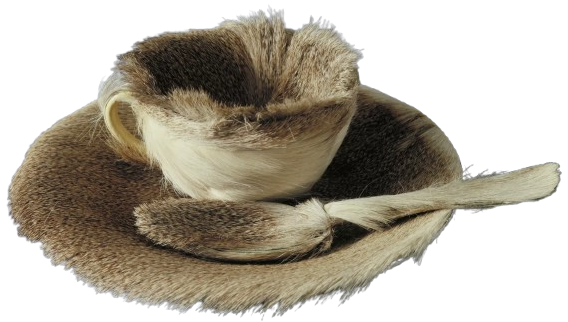
This piece instantly makes me feel curious and uncomfortable, specifically because of its weird juxtaposition of materials and potent symbolism. It's just a cup, saucer, and spoon– common items in a lot of households– but the artist takes these familiar, comforting items and makes them unimaginably odd by covering them in fur. I’m not sure exactly what kind of fur it uses, but it seems like it’s from some sort of deer-like creature, which adds layers of texture and a sort of primal wildness to the piece, which is, at its base, everyday.
The choice of using fur creates a tactile experience that's pretty unusual for objects like tea cups and spoons typically associated with the smooth, cool surfaces of ceramic or metal. I get a few different ideas from this contradiction– mainly that it’s interesting to pair two strongly feminine things (fur & a tea set) that also contradict each other in sensation. But then there’s something more that comes with how this unexpected substitution invites us to imagine the sensation of fur against our lips as we sip tea, which is both intriguing and repellant. It feels almost violent and gruesome in this weird way.
The color of the fur is a creamy beige, blending almost seamlessly with the off-white color we might expect from a ceramic tea set. The subtle color choice doesn't scream for attention but instead whispers for a closer look, emphasizing texture over hue. The natural pattern of the fur might still be faintly discernible, suggesting the wild origin of the material, standing in stark contrast to the domesticity of tea-time paraphernalia.
That initial contradiction of expectation vs. transformation in texture makes me view this piece through the lens of contradiction and challenge. The piece seems to blur the lines between the animate and inanimate, wild and tamed. The fur, a material from a living creature, clings to objects symbolizing civilization and refinement– a duality that can evoke a range of emotions, from amusement to discomfort. It even sort of explores the exterior vs. interior world, like it’s forcing the more raw and pure that usually hides inside out to the surface, letting it obscure the more polite and accepted. Is that bad? Weird? Good?
Regardless, it feels like a nod to the unexpected and surreal, maybe drawing from a dreamlike logic where anything can happen, and the ordinary becomes extraordinary through simple, yet radical alteration.
Improvisation 28 ; 1912 CE ; Munich, Germany ; 112.6 cm x 162.5 cm ; Oil on canvas

This painting feels like a visual symphony, with each stroke and color playing its own unique sound. It’s almost like he threw open the doors to a realm of abstract emotion and let it all wash over him. You can almost hear a soundtrack to this piece– maybe something experimental, layered with a multitude of sounds and textures. I imagine something with piano, definitely; maybe it sounds like Jacob Collier.
Anyway, the technique here very much emphasizes freedom. The brushstrokes are loose and vigorous, seemingly dancing across the canvas without a care, and a blend of sharp lines and soft washes makes us feel both the precision and the spontaneity the artist must’ve been channeling. The painting doesn't just occupy the canvas; it bursts through it, with each stroke asserting its right to exist in whatever form it needs to. There’s no strict boundaries– none at all, really.
Color definitely plays a massive role in the piece. The contrasts are striking, with fiery reds and cool blues clashing, while blacks and whites add a more grounding effect. The colors seem to emulate emotions, conflicts– resonating with an internal energy that's quite intense. The red might stir up feelings of passion or danger, while the blue could be read as deep, contemplative, or soothing. Where the colors overlap or clash, new shades and sentiments emerge.
Obviously, it’s a bit difficult to explore any more traditional symbols in something so abstract, but I’m sure it’s possible to find some. You might see shapes that remind you of mountains or waves, or figures and faces that seem to peek out from the chaos now and then. It feels like the artist is using these familiar elements– morphing them into something new and unrecognizable and pushing us to find personal meaning rather than some universal truth that they’re presenting to us.
I don’t know the artist or the piece, so I can’t really speak to its inspiration, but if it has anything specific, it feels like they might have been inspired by a sense of upheaval, whether personal or societal. There’s a sense of dismantling and rebuilding in the way forms and colors collide– as if he's wrestling with ideas, with the very notions of form and space, and creating something that defies any easy interpretation.
The Kiss ; 1907-1908 CE ; Vienna, Austria ; 180 cm x 180 cm ; Oil and gold lead on canvas

Klimt’s The Kiss is an incredibly iconic piece– too much so to pretend I don’t know it, so I won’t! But even without the weight of its fame, it’s really hard to look at this painting and not feel drawn into its rich, golden world. The technique is mesmerizing– metallic gold leaf dominating the canvas, turning the figures into something very divine-like. It feels both solid and ethereal, as if the couple is suspended in time, existing in a moment so profound it became eternal.
The figures themselves are wrapped in a cascade of textures and patterns. His robe is geometric, almost mechanical, with bold rectangles and dark squares, while hers is softer, with organic, floral motifs that flow into the meadow below them. The juxtaposition between the two suggests a unity of contrasts: the logical and the emotional, the masculine and the feminine. Their poses echo this harmony, too– with him leaning in, protective and almost overwhelming, while she bends back, soft and yielding, yet radiant in her surrender.
The use of color beneath the gold is equally striking. Her robe is filled with bursts of red, green, and blue, like flowers blooming within the warmth of the gold, while his palette remains muted. It almost feels like she brings life into the scene, a garden flourishing within his embrace. She seems to almost be giving him some, though, as just a little bit of life flourishes around his head with the crown of vines. She’s changing him a little bit, or adding on. Together, their connection feels sacred, but also intensely human, rooted in the way their faces meet and her hands clutch his neck. You can almost feel the heat of their closeness and the weight of his hands on her.
The meadow they stand on is small and precarious, almost too delicate to hold them. Beyond it, there’s nothing– just that shimmering gold, blurring the line between the earthly and the divine. It feels almost like a suggestion that love is all there is, a transcendent force that defies boundaries.
Emotionally, the painting feels deeply intimate but also universal. It captures a moment of vulnerability and ecstasy, making the viewer feel like a witness to something sacred. It’s not just about these two figures but about love in its purest, most consuming form. It’s overwhelming, tender, and a little bit otherworldly.
The Coiffure ; 1890-1891 CE ; Paris, France ; 43.3 cm x 30.2 cm ; Drypoint and aquatint on laid paper

This painting sets us in this very quiet, intimate moment. A woman sits on a cushioned stool, facing a mirror, mid-gesture with her hands reaching toward her hair, like she’s getting ready to put it up or take it down. It’s not dramatic, not posed– just this simple, everyday action that’s somehow deeply intimate. Her head tilts slightly forward, her gaze hidden, giving this moment a sense of inwardness, of thoughtfulness. She isn’t doing her hair for anyone else; it feels like a moment of care, of ritual, just for herself. That subtle curve of her spine, the way her body softens into the cushioned stool– there’s something so human about it.
The scene is soft and hazy, not in a way that blurs details but in a way that makes you feel like you’re catching this moment through a veil of sunlight– through a window (but without the creepy implications of that). I’m also not sure, though– maybe it is an intrusion, with this woman turned away and trying to hide herself, with a man seeing anyway through the mirror. That sort of implies that the audience and artist are men, though, which doesn't feel right. I think there’s something softer and less sexual here. It reminds me of how women might get dressed together in the same room, and there’s nothing there; it’s just bodies together. There’s such quiet and privacy, though, that it makes me want to shy away from the idea that she’s with anyone at all. It feels really personally intimate and alone to me… but then whose perspective are we inhabiting?
The lines are delicate and sketch-like, but deliberate enough to give everything its place. It has a very muted, pastel-heavy color palette– mostly pinks, creams, and soft browns, with little contrast, which makes it feel dreamy and private. There’s a harmony to the tones– nothing jars or jumps out too much. It feels controlled, restrained, and kind of still. There’s very little drama or intensity to this, except for maybe the intensity of her contemplation or focus. The soft pinks of the woman’s robe spill into the scene and wrap it in this muted tenderness. Even the mirror behind her reflects more than just her silhouette– the mood itself, hazy and muted, is wrapped in it. The whole piece feels inward-facing.
It’s also definitely hard to miss the Japanese influence in the composition. The flatness of the perspective, the cropped edges, the way her face and body are shaped, and even the way the colors seem to layer over one another like printed textures– all of it feels inspired by Japanese woodblock prints. The pattern on the carpet beneath her adds to that sense of design– it’s less about depicting reality and more about creating a unified visual rhythm.
Emotionally, it’s calming, even meditative. There’s a sense of reverence for the mundane, for this fleeting moment that might otherwise go unnoticed. You might feel a kind of quiet melancholy, too– this is solitude, after all– but it’s a tender, warm solitude. It invites you to slow down, to pay attention to the way light catches on skin or the curve of an arm. The artist really captures the smallness of this moment, and makes it feel universal.
The Scream of Nature ; 1893 CE ; Berlin, Germany and Åsgårdsstrand, Norway ; 91 cm x 73.5 cm ; Tempera on board (though there are several versions and mediums)

It’s hard to pretend that I don’t know The Scream (I'd say most people do), so I’m not going to, but wow is the piece beautiful every time! Looking at it, the first thing that hits me is how visceral and raw it feels. The swirling lines in the sky– blood-red streaks mixing with darker, turbulent waves– give the whole scene this unsettling sense of movement, like the air itself is alive and suffocating. The way the figure is centered, holding their face, feels almost like they’re physically anchoring themselves in this storm of chaos, though the world keeps spinning violently around them. The technique feels frantic, like the brush was moving quickly, almost trembling, to capture something fleeting and urgent. The colors are intense– mostly warm tones like reds, oranges, and yellows, but then there’s the coolness of the blue water, cutting through the chaos with its own icy despair.
The figure itself is almost skeletal, androgynous, faceless but expressive all at once. They seem both human and otherworldly, like they’re a stand-in for everyone, or maybe no one, like they’re dissolving into their surroundings. Their hollow eyes and gaping mouth make you wonder if they’re the source of the scream or if they’re reacting to something even worse that we can’t see. It’s not just a scream you can hear– it’s also a scream you can feel in your gut, vibrating with tension between the fiery red sky and the calmer but eerily still bridge.
There’s these two figures casually walking along in the background– entirely chill and refusing to recognize the chaos, which makes the isolation of the screaming figure even louder. There’s two options here– one in which the two men in the background are disconnected from this awful & awesome scene, and one in which the main figure is the one disconnected from reality, entirely engulfed by something in his own mind. I think the second makes more sense, especially with the knowledge that this painting represents a pretty deep and existential anxiety.
I also wonder if the two men are related to the main figure. I have some ideas about that, but first I’ll back up to explore the setting. The screamer is standing on a bridge, and in the background, we see a pretty clear picture of a body of water of some kind, with little boats floating atop it, and this intense red sky above. I’m intrigued by the boats, which could to me signify the fact that the world moves on regardless of the chaos & emotions you’re feeling. I think that ties into the two men– this calm movement forward of all these other figures adding to the isolation and sense that nothing else is stopping for you. I wonder if they might be friends of his? I think that could add to the intensity there, too– that even people you know & love might not notice or be there with you in this moment.
There’s a sense of dread here that feels both universal and deeply personal. It’s like a sort of nightmare you’ve had where you can’t quite explain what’s wrong, but it lingers anyway. The symbols feel broad but visceral: the bridge is both a divider and a passage, the sky a symbol of emotional turbulence (and maybe what has caused it?), and the figure a kind of soul caught in the middle of it all. There’s something comforting in how it doesn’t shy away from those raw emotions; it’s very vulnerable.
La Gare Saint-Lazare ; 1877 CE ; Paris, France ; 75 cm × 105 cm ; Oil on canvas

This feels like a moment caught in the blur of a busy, industrial city (vibes say Paris?). I’m going to take a stab at it and say this is by Claude Monet because of the distinct style. In this specific piece, the brushstrokes are quick, loose, almost haphazard, as if Monet painted the scene in the time it takes for a train to arrive and depart. Everything about the painting feels alive– steam billowing into the air, merging with the smoke from the trains, creating an almost dreamlike haze that softens the harshness of the metal tracks and industrial structures.
The use of color is particularly stunning. I really love the blues and purples in this piece; I actually thought it was a painting of jacarandas at first glance because of them. Anyway, at first, the palette seems muted– pastel blues, purples, and grays dominating the scene– but as you look closer, there’s a surprising vibrancy to it. There's lots of complementary colors! Oranges and yellows peek through the clouds of steam and lay against the railroad tracks, suggesting the warmth of sunlight breaking through, or maybe just the energy of human movement that fills the station. It definitely gives it a time of day– either early morning (which feels right to me) or later in the evening. The trains themselves are dark and hulking, like these sort of mechanical beasts, but they’re not menacing; they’re part of the rhythm of the place, part of the city’s heartbeat.
The billowing smoke definitely draws you up toward the roof, with intricate ironwork arching upward, framing the chaos below and providing a sense of structure and order. It’s like the station is a cathedral, with its own kind of spirituality– not religious, but rooted in progress and the promise of travel. The figures scattered throughout are almost ghostly– barely sketched in– but that works to highlight how insignificant individuals can feel in the face of something as monumental as industrial progress (particularly in the industrial revolution, I imagine). Even if they’re small and haphazard, they’re there: a vital part of the scene.
Looking at the painting, there’s a pretty strong sense of motion and noise– you can almost hear the hiss of steam, the clatter of wheels, the distant murmur of voices. The muted colors definitely soften that a bit (I’m reminded of a Miyazaki scene, and the soft horn of the trains that might exist in one), but don't get rid of it. It’s not nostalgic, exactly, but it’s also not cold. There’s a strange tenderness to the way the light plays on the steam, the way Monet gives life to the machines and the people who interact with them.
I know Monet painted things less for some deeper meaning or political commentary and more to capture this state of transience, of fleeting experiences (especially in nature), but it still feels like both a celebration and a questioning of progress in the industrial revolution– like Monet was fascinated and maybe a little overwhelmed by the world he was painting.
The Oxbow / View from Mount Holyoke, Northampton, Massachusetts, after a Thunderstorm ; 1836 CE ; New York, US ; 130.8 cm × 193 cm ; Oil on canvas
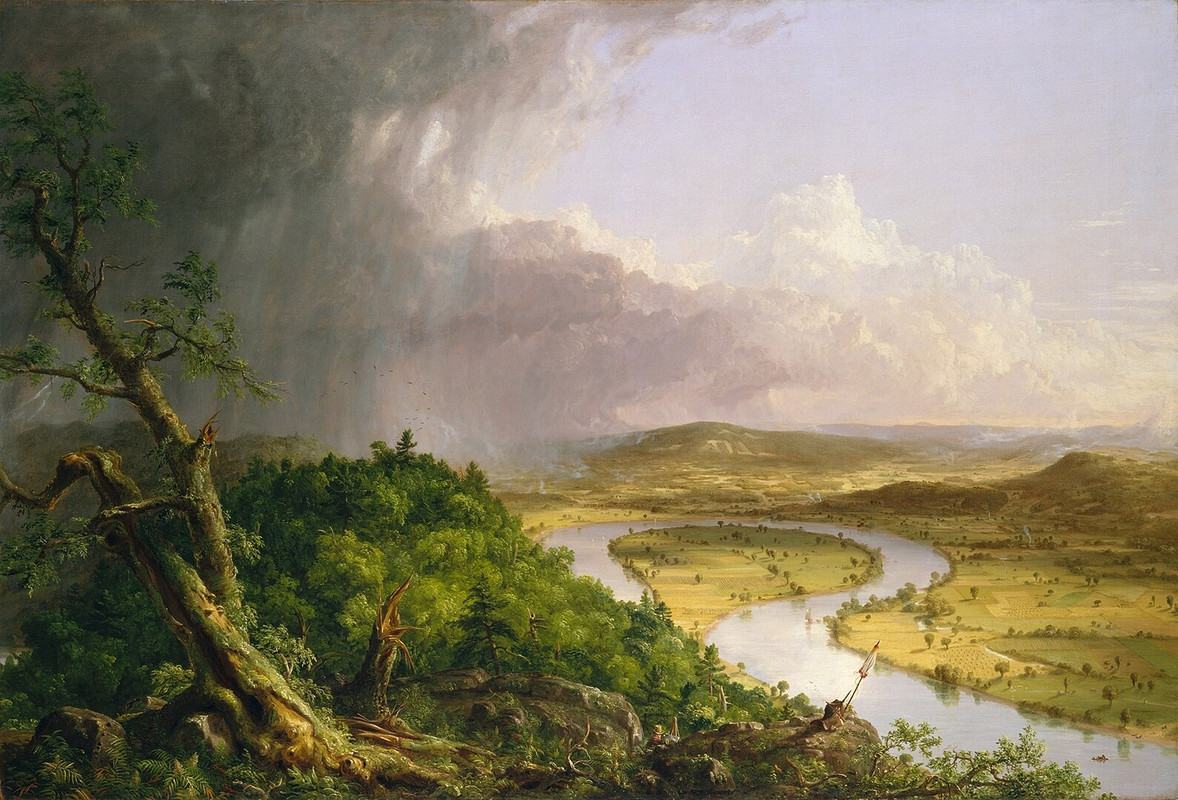
The first thing that jumps out in this piece is the sharp divide– a sort of fuzzy diagonal slash– between two worlds. On the left, there’s a chaotic feeling. The sky churns with dark, looming clouds, streaked with light as if it’s fighting the peace and calm it’s trying to overtake. Trees seem to bend and break in the wind, their jagged forms reaching out. One tree in particular takes up the foreground, clearly cracked into pieces and destroyed. The land feels wild, untamed, and alive, but also threatening. There's a heaviness to this side– a sense of struggle and potential destruction.
On the right side of the diagonal, it’s like a completely different painting. The land opens up in soft, rolling fields, framed by these very calm curves of the river's oxbow shape. I’m curious if the river is man made or natural, especially because of the farmland around it. I also can’t tell if the storm has passed, here, or if it’s about to face it. Either way– the colors are warm and inviting, with golden yellows and soft greens. This side is all peace and harmony, touched by human hands but not overwhelmed by them. Tiny specks of houses dot the landscape, almost blending into it, and it feels like a vision of what some people might imagine when they think of the "good life."
On the left, dark browns and murky greens dominate, while the right side glows with a sunlit palette. It’s like nature’s duality is being laid bare: untamed wilderness versus cultivated land. But the divide isn’t clean. The edges blur slightly, as if to remind us that the wild and the controlled are constantly pushing up against each other.
There’s a tiny figure tucked into the scene– pretty easy to miss. He’s standing in the wilderness and holds an easel, painting the scene we’re looking at. It definitely seems like the artist is trying to put a little Easter egg of himself in there, but it also adds something more to the piece. It makes me wonder if maybe this painting is also talking about perspective– how we frame nature, or how we choose to see it. It doesn’t feel like the wilderness is inherently bad or the farmland inherently good, but there’s a tension between them, and the figure makes you feel like you’re being asked to think about where you’d stand. Are we intruders or maybe stewards? Both? Are we taming this land? Ruining it? This piece seems to suggest we’re making it better, though I wouldn’t agree. Especially in the context of settlers and cultivating land (whether rightfully or not), this question is especially important.
Liberty Leading the People ; 1830 CE ; Paris, France ; 260 cm x 325 cm ; Oil on canvas
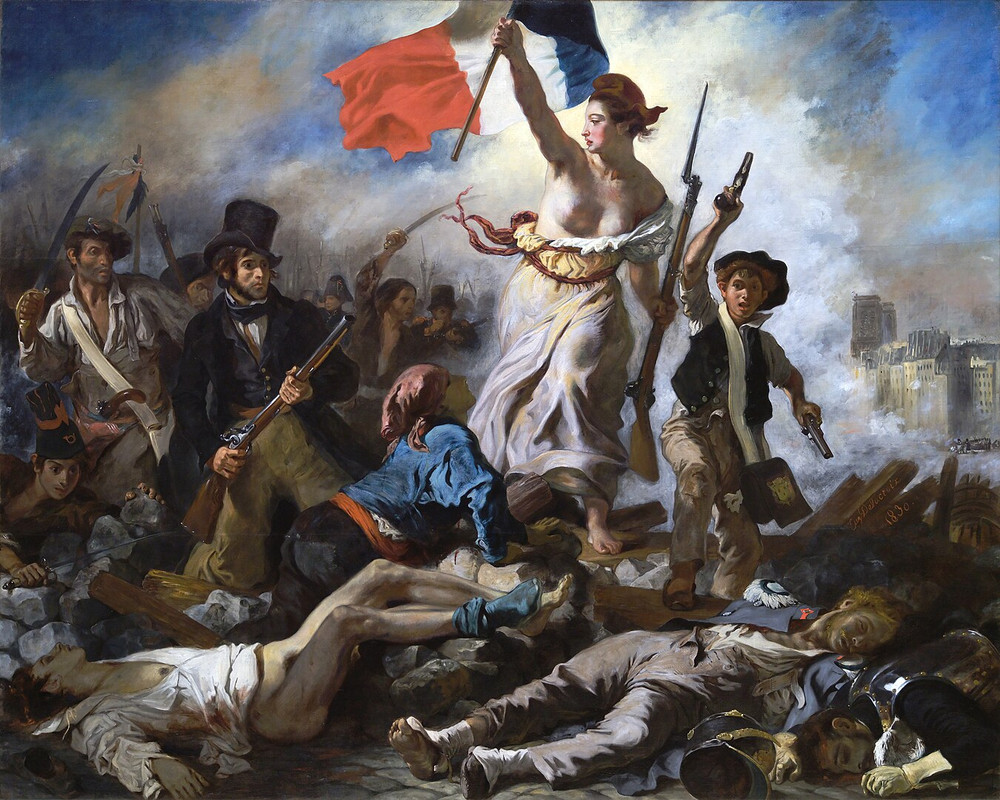
This painting clearly captures the fervor and chaos of the July Revolution in France-- I'm only thinking it's not the French Revolution because she doesn't seem to be dressed in clothing that fits with the time period of the French Revolution. At the heart of the painting is a figure I’m going to take a chance and identify as Liberty– personified as a robust, bare-breasted woman leading a diverse crowd over a barricade of fallen bodies. In one hand, she holds the French tricolor flag, and in the other, a musket, embodying both nationalism and revolution. I’d argue that her raised flag also specifically symbolizes the values of liberty, equality, and fraternity, and acts as the painting’s focal point, rising above the chaos and pulling the viewer’s gaze upward. From the positioning of the flag, herself, and those following her comes a triangular composition that really draws my eye upward from the chaotic struggle at the base to the flag soaring high– full of hope. The arrangement creates a sense of upward motion, as if the crowd is pushing toward freedom and victory.
The artist uses light and shadow in a very dramatic way– amplifying the painting’s emotional intensity. Liberty is illuminated in a very golden light, elevating her to a near-divine status, while the smoky background is tinged with earthy tones, underscoring the grim and violent reality of the battlefield. The bright red, white, and blue of the flag also stands out starkly against the muted palette, emphasizing a sort of central role as a symbol of national unity and revolutionary fervor. That said, the red, white, and blue repeat in little sections all over the piece. At the same time, the visceral details of the fallen bodies, rendered with gritty realism, remind viewers of the human cost of freedom– one man even with his pants gone, clearly violated and murdered.
I feel like every figure in the painting carries some symbolic weight. Liberty definitely evokes classical ideals of freedom and truth– she’s absolutely an allegorical figure for France’s freedom. Her bare chest seems to reinforce her role as a maternal and unifying force (maybe nourishing force), while her musket obviously connects her to the revolutionary struggle. She’s barefoot, too– emphasizing freedom. A man below her grovels at her feet, seemingly in awe and excited by what she is/what she represents, especially as a sort of… protector and birther of freedom in her country. The figures around her are all incredibly diverse, and represent different cross-sections of society: a bourgeois man in a top hat, a worker in a white shirt, and a young boy with pistols. I wonder if the young boy is a symbol for America, too– which is quite young at the time, and has sort of American, cowboy-like clothing. Regardless, they together embody the collective effort of the revolution, cutting across class and age. The dead, dying, violated at their feet really intensify the need for and cost of revolution.
The Swing ; 1767 CE ; Paris, France ; 81 cm × 64.2 cm ; Oil on canvas

This piece is immediately such a playful, layered painting– it feels like a snapshot of indulgence, mischief, decadence, and romance wrapped up in pastel colors. The girl on the swing is obviously the focal point and the heart of it all– her bright pink dress making it hard to miss her. It’s very luxurious, spilling over the swing like it has a personality of its own, symbolizing wealth, femininity, and maybe even desire. She looks entirely like a flower, which has a few meanings that’re sort of contradicting and fun– innocence, desire, and also the fact that when flowers are blooming, they’re also attracting mates. She’s carefree and confident, mid-air, fully in control of the scene– even as she teases both the man hidden in the bushes below and the one pushing her swing. That kicked-off shoe is a small but brilliant detail– a sign of abandon, a little rebellious moment in an otherwise orchestrated scene, like she’s saying, “Catch me if you can.” It feels like she’s flinging all decorum out the window, and also sort of mimics the energy of being freely and excitedly in love. This is especially true because it also shows off her ankle, which is obviously quite scandalous for a girl of her perceived status.
There’s also the man in the bushes, looking up at her with a not-so-innocent gaze. His hidden position and craned neck makes it clear he’s sneaking a look up her dress, and the way he reaches toward her– almost like he’s trying to grasp her or her attention– adds a layer of tension to all the fun. It’s interesting that he seems to be in a bush of roses, since she’s reminiscent of a rose– maybe trying to suggest that he’s sort of a player? Across the painting from him, the man pushing the swing seems older and more shadowy, possibly oblivious to what’s happening right in front of him– especially because he’s literally in the dark of the painting. Could he be her husband? There’s also the possibility that he knows she’s with others, but can’t really care– maybe leaning into infidelity in loveless, aristocratic relationships. Either way, there’s a triangle of power and flirtation happening that keeps things interesting.
I love the use of the two cherubs that sort of mirror the two men, as well– like the one in front of her that’s shushing her, which seems to imply that maybe she’s having an affair, and then the two that also seem to be looking up at her like the man in the bushes. It definitely adds to the sort of affair-like cheeky and scandalous energy.
The colors and lighting really bring everything to life. The greens and pinks are soft and vibrant at the same time, creating this lush, dreamy environment. Light filters through the trees, casting a glow on her dress and highlighting the key players in the scene. But the darker areas– the shadows in the foliage, the hidden corners– add just enough mystery and unease to balance out all the charm. It’s like the artist is reminding us that even in a playful moment, there’s always something just out of sight. One side is beautiful and bright, and the other feels odd and out of sight. The brushwork is definitely another highlight. Everything feels light and airy, like the painting is in motion. The way the artist handles texture– whether it’s the silkiness of her dress, the roughness of the tree bark, or the softness of the clouds– makes the scene feel tactile and alive. You can almost hear the swing creaking, the leaves rustling, and the laughter echoing.
In general, the painting has this mix of feelings that’s hard to pin down. On one hand, it’s carefree and indulgent, full of laughter and sensuality. On the other, there’s this undercurrent of tension, maybe even danger. The swing itself feels symbolic– she’s suspended in mid-air, weightless and ungrounded. It’s a moment of freedom, but it’s also fleeting. The man in the bushes and the older figure (literally) pulling the strings remind you that this freedom isn’t entirely her own, and also emphasize that it’s sort of taboo. Knowing that this piece is French also lends itself to the idea that it has to be playing on the idea of overt and unnecessary decadence– especially in higher class people and places like the Palace of Versailles. It seems like it’s commenting on that decadence, especially with how idyllic the painting sort of feels.
Spaniard and Indian Produce a Mestizo ; 1715 CE ; “New Spain” aka Spanish colonial Mexico ; 102 cm x 126 cm ; Oil on canvas
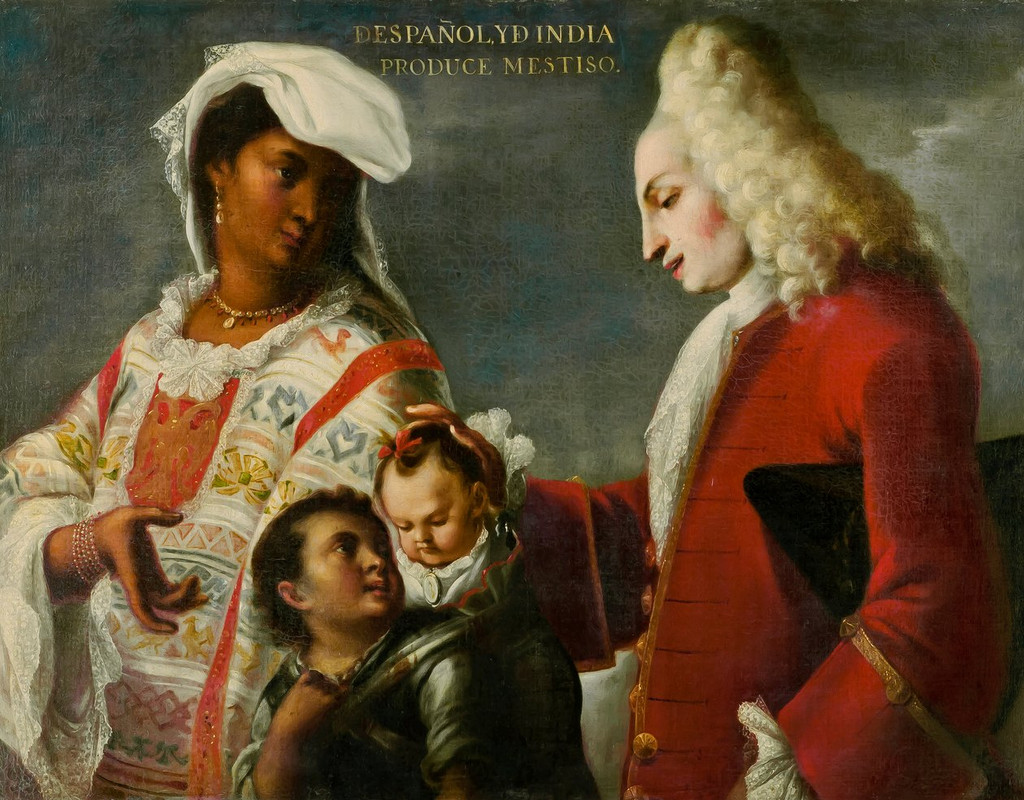
This painting makes me feel uncomfortable right away. At the top of the painting are the words “Depañol Yd India Produce Mestiso,” which clearly signifies that this painting is attempting to discuss the casta system (for better or for worse). It presents a complex family interaction among four figures, each marked by distinct features and clothing that communicate cultural and social tensions. The woman on the left wears white clothing that’s intricate and patterned, with vibrant, warm colors and textiles that hint at Indigenous or even African influences. Her head is covered, possibly suggesting an imposed modesty or an attempt to assimilate into European customs. Her gaze is also directed downward and away from the father, which sort of indicates submissions– likely forced– but also (in my hopeful heart) feels a bit like quiet resistance or emotional distance, as if silently protesting an imposed structure and colonial lens. The man, in stark contrast, is dressed in European-style clothing, his posture and gaze carrying an air of superiority.
In the center, we see one figure who could be an older child or a servant of some kind standing beside the mother, holding an infant in their arms. If it is another child of theirs (or just of hers), the arrangement shifts the familial dynamics. Rather than the mother directly holding the baby, the older child takes on a caretaking role, suggesting a shared responsibility within the family or possibly the necessity for children to support each other in these families. This positioning can imply that children (specifically non-white children of any mix) in colonial societies often took on adult responsibilities early, shaped by the pressures and constraints of the colonial system. If they’re a servant of some kind (which I think is also emphasized by the difference in skin color between the two children, with the older one being darker), it still definitely emphasizes the presence of the casta system and mestizaje, and their impacts on successive generations, as colonial societies would have categorized these children based on appearance and parentage.
The artist’s intent might have been to document or validate this system, portraying the results of cross-cultural unions as a visual taxonomy rather than a celebration. In general, the painting seems like it’s trying to paint the scene as more beautiful than I might imagine mestizo relationships actually were, and could possibly be an attempt at propaganda to make it seem more beautiful for Indigenous people to have children with white people, thus turning their population more white.
It also definitely echoes the dynamics of power and hierarchy prevalent during the colonial period. The man’s gesture toward the children– a seemingly paternal or possessive touch– implies ownership or control, reinforcing his authority. He looks at them with an expression that could be interpreted as interest, but not necessarily warmth. This dynamic reflects a clear colonial mindset– one of dominance over and objectification of non-European peoples.
The painter uses a lot of contrasting lighting and clothing textures to draw distinctions between the figures. The man’s clothing and pale complexion catch more light, emphasizing his dominant presence, while the mother’s darker skin and elaborate garment reflect less, rendering her more subdued in the scene. This technique seems to visually reinforce the societal hierarchy imposed on these figures, with the European figure quite literally illuminated as the focal point.
The painting evokes a lot of mixed emotions: a sense of tension, sadness, and discomfort at witnessing this racial hierarchy encoded in art. It obviously reflects a forced merging of cultures, with themes of control and subjugation subtly conveyed in the figures’ body language. It’s clear that the work both reflects and reinforces colonial ideologies, leaving us to question the humanity and agency of those depicted within this colonial framework.
Marriage A-la-Mode: 2, The Tête à Tête ; 1743 CE ; London, England ; 69.9 cm × 90.8 cm ; Oil on canvas
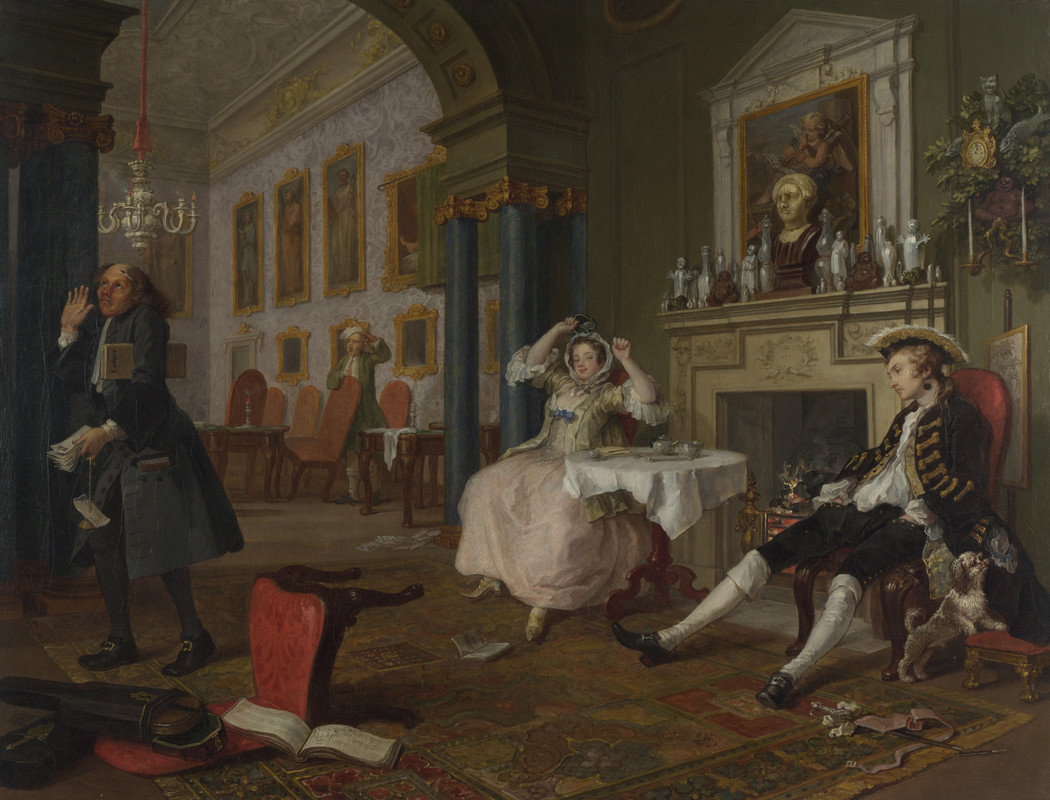
This piece definitely has a strong sense of sarcasm which seems to mix with some social commentary. Two people sit beside each other, seeming entirely indifferent to the other’s existence, and the room around them is both grand and incredibly cluttered. It almost seems like the afternight of a drunken night/party; there’s a broken sword on the floor (hints of a duel?), an instrument tossed aside and onto a fallen chair, and a dog sniffing at a woman’s clothing of some kind in the man’s pocket. I wonder if the two sitting people are supposed to be married or together, since that tiny detail with the dog would make the most sense if it’s making a statement about lack of fidelity or loyalty.
Aside from the indifferent couple, two other figures add depth to the scene. There’s the accountant on the left, looking completely fed up as he holds a stack of unpaid bills. He’s kind of like an anchor in the scene, representing the reality that the couple is ignoring, and he has a look of exasperation and resignation that's directed out of the frame, like he’s trying to signal to us, “These two are a lost cause.”
On the other side of the room, there’s a servant who’s caught mid-yawn, holding a cup of coffee as he seems to be cleaning up the aftermath. His bored expression and casual stance suggest he’s seen this scene play out too many times to be shocked. These two figures underline the theme/energy of disinterest and wastefulness– the accountant and servant are the “grounded” characters surrounded by wealth, but the scene shows that they’re the only ones dealing with the consequences of the couple’s lifestyle. Together, these figures add a sense of frustration and irony to the painting, contrasting with the “whatever” attitude of the couple and helping drive home the social critique this painting seems to aim for.
In general, I get the feeling that this piece is trying to critique how frivolous and superficial British aristocracy (what this painting seems to depict) really is. Everyone has these over the top expressions and energies about them, and it’s like their entire reality that we can imagine they present to the world is a facade– an illusion.
The painting uses a surprisingly muted color palette for such a chaotic scene— soft browns, greens, and creams that give the scene a hazy, almost tired feeling, like the room is recovering from the night as much as its owners are. There are small pockets of vibrant red, though, like the insanity of it all is still going to continue; it’s not over. The wife looks relaxed, but also has this sort of cheeky energy as she puts her hands up (maybe to stretch), and the husband's clearly exhausted, sprawling across the chair. These add to this “over it” vibe, painting a picture of aristocratic life as hollow and repetitive. They’ve got all the material luxuries, but they’re missing any real connection, and it’s going to stay like that.
The artist also plays with space to reveal character; the two sit far apart, barely looking at each other, emphasizing their emotional distance. Their technique is detailed and sharp, using objects in the room to tell stories: portraits, scattered items, and that ignored servant in the doorway, all adding to the chaotic feel. The work feels like a callout, like it’s saying, “Look at the ridiculousness of it all.” It’s satirical, but there’s also a sense of sadness behind it– a feeling that these people are wasting their lives and their privilege on shallow pleasures.
Woman Holding a Balance ; 1662-1664 CE ; Amsterdam, Netherlands ; 42.5 cm x 38 cm ; Oil on canvas
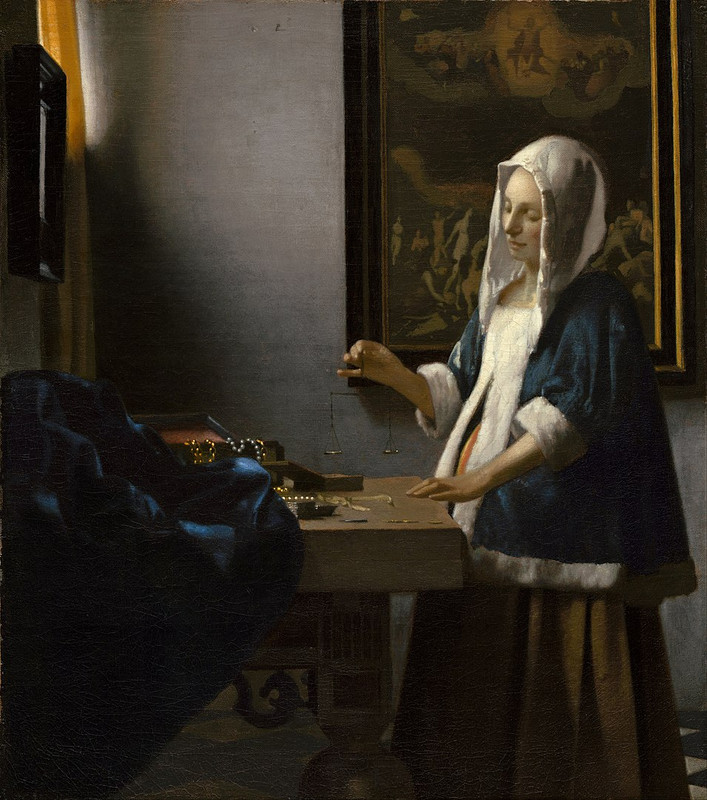
The first thing that catches my eye about this piece is the lighting. The figure depicted is cast in this beautiful ray of light coming from a window we can only see the corner of, and illuminates most of the room except the bottom left dark corner– sort of like there’s a diagonal drawn through the piece. The light just barely catches her hand, which holds a balance (or scale), and the balance gets to occupy a space right in front of the frame’s dark corner and in the exact center of the painting. The window also paints her in such a soft lighting that her sort of pensive countenance feels even more enhanced and intimate– like I’m interrupting her.
The most obvious thing to me about this piece is that right behind her (on the right of the painting), we see a depiction of The Last Judgment, bathed in light, and that on the left of the painting, we see a lot of earthly treasures/goods that are bathed in darkness. The scale she’s holding is positioned directly between the two, almost balancing them. I really love that there are two sort of diagonals in this piece (one that draws a line through the riches, the balance, and the Last Judgment painting and one that draws a line of darkness vs. light).
I think this is definitely trying to display a conflict between materialism and morality, but is also specifically encouraging the viewer to live a holy life. It sort of calls to mind the idea of Temperance (the tarot card) for me. She definitely has a holy or earthly energy to her, and feels like she’s calling us to be like her– and her depiction seems to be a sort of reference to the Virgin Mary.
She has a mirror in front of her, as well, which seems like it could reference a few things. One option is just that it’s another suggestion of vanity, materialism, etc, but I personally prefer the idea that it’s asking her (and through her, us) to reflect on her/our actions and explore what decisions we make. This painting is a huge moment of reflection for the figure, and it’s definitely inviting us in to reflect as well.
The Hunters in the Snow ; 1565 CE ; Vienna, Austria ; 117 cm × 162 cm ; Oil on wood
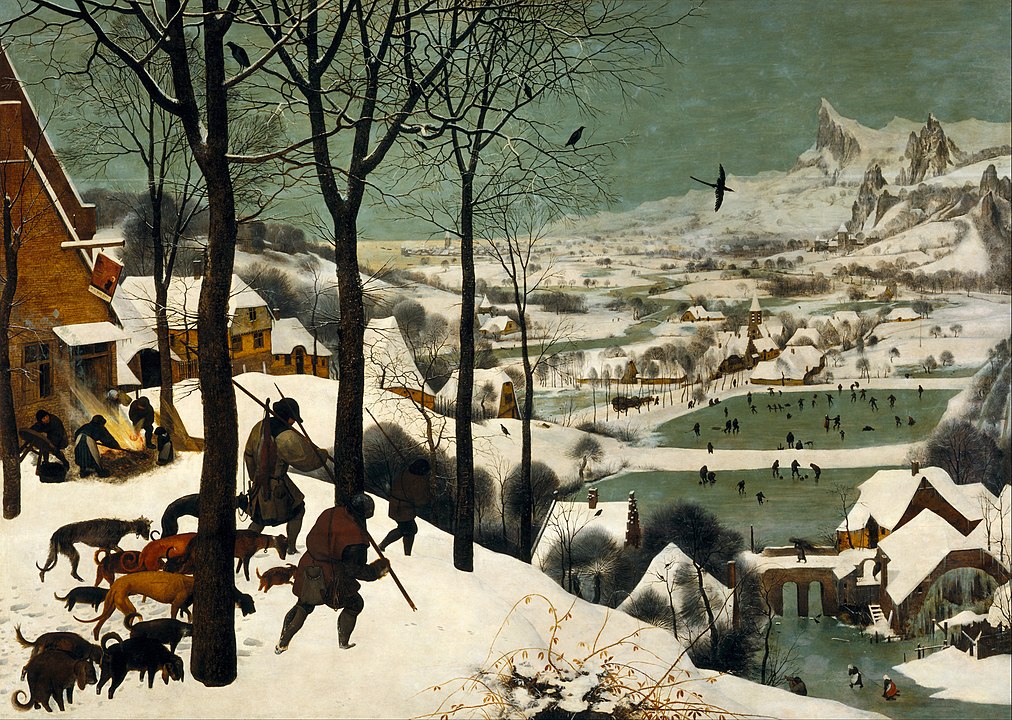
This is clearly a winter landscape that meets you with an immediate sense of calm, almost as if you can feel the cold seeping into your clothes. The hunters at the top, silhouetted against the snow, seem to anchor the scene with a quiet exhaustion. Their dark figures stand out sharply, casting shadows across the snowy ground that tell of their journey and the scarcity of the season. I almost feel a kind of sympathy for them because of how easy it is to sense the hardships of winter— bare branches above them mirroring their own sparse catch. The scene doesn’t glorify them, but rather situates them within the broader world, a part of the natural cycle they’re bound to.
The hunters’ dogs sit and walk beside them, clearly carrying a story of their own. Their bodies mirror the hunters’ weariness, with heads hung low, tails barely lifted, like they’re too worn down by the cold and the journey to do much. They also seem quite skinny and hungry, and I’m curious about the fact that not all of them are hunting dogs. Their positioning, slightly behind their masters, emphasizes their loyalty and the difficulty of being sort of ‘in this together’. The dogs’ placement feels intentional, reinforcing the sense of unity and shared endurance. They’re not animals in the background, but active participants in this story of survival, each step they take adding to the scene’s quiet, somber tone.
Beside the hunters and their dogs, a small fire crackles, its warmth barely visible but also crucial, a quiet resilience against the icy palette that surrounds it. This is where you see the contrast of warm and cold— life continuing in small acts despite the winter chill. It does seem a bit desperate, though, too.
Looking past the foreground, the landscape is composed in such a way that your eyes naturally travel down the slope, guided along by the angles of the trees and paths, until you reach the village below. Here, the positioning becomes clear: this isn’t just about the hunters, but a snapshot of the entire community, each layer revealing people going about their lives. Villagers are scattered across the ice, skating and playing, adding a sense of motion and lightness. The people are tiny compared to the massive expanse of the snow-covered land, but they still fill it with energy. The contrast between the hunters’ labor and the villagers’ leisure feels deliberate— a hint at the communal endurance that defines the scene. It’s as if the painting is saying that everyone, whether toiling or playing, is part of the same rhythm.
After leading you down to the lake and village, the painting continues to draw your eye further, where the sky opens up and a flock of birds sweeps across the background. Their dark forms create a contrast with the softer, grayer sky, giving the feeling of movement and freedom, almost as if they’re watching over the scene from above. Beyond the birds, the landscape stretches out to reveal the vast, snow-covered mountains, towering and imposing. These peaks feel distant, almost otherworldly, casting a shadow over the entire valley below. It feels like it’s leaning more into the intense and harsher side of nature, contrasting with the sort of hope and joy we feel in other parts. Together, the birds and mountains create a sense of vastness that makes the figures below seem small yet connected to something greater, almost reminding us of nature’s scale and endurance.
The colors in this piece— mostly whites, grays, and soft greens— lock you into a frigid winter atmosphere. The limited palette brings the scene into sharp focus, almost crystallizing it; you can feel the cold through the screen or canvas. At the same time, there’s a sort of softness to it— the snow isn’t harsh or blinding, but blanketing, creating a muted calm that feels peaceful rather than barren. This sort of brings to light the theme of resilience in difficult times— how even the harshest season carries a kind of quiet beauty.
Through these layers, the artist uses depth and positioning to show the natural flow of life within the community. The slope and winding paths draw you in gradually, moving you through different vignettes within the larger scene. The painting seems to evoke a sense of timelessness, where every small act— skating, hunting, or tending to a fire— contributes to a larger whole. I also feel, though, like it’s a little bit too magical. Knowing this was made around the 16th century, it feels like it’s sort of a wish for what could be, while their actual winter might be less joyful, magical, beautiful, etc.
Venus of Urbino ; 1538 CE ; Venice, Italy ; 119.1 cm × 165.1 cm ; Oil on canvas
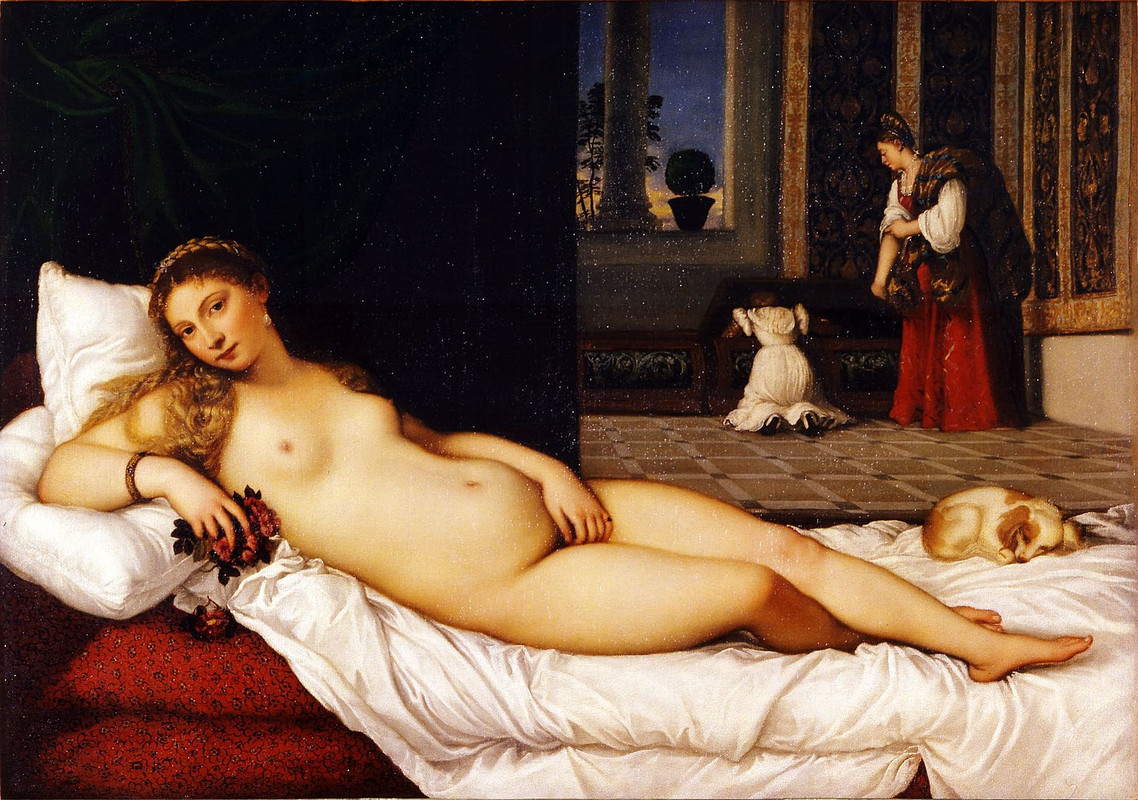
This painting, which I recognized as a depiction of Venus, is instantly captivating with its blend of sensuality and elegance. It sort of draws me into a quiet moment of intimacy– especially with the way Venus is looking at the viewer. To me, her gaze is one of the most compelling aspects of the painting. It feels direct yet soft, as if inviting the viewer into a private moment without hesitation or shame. She’s also reclining as she looks at us– nude against the backdrop of a rich, domestic interior– creating a striking contrast between her exposed form and the more structured, detailed surroundings. She’s very unashamed of her nakedness, and seems perfectly comfortable in this– possibly even touching herself (though her hand could just be resting by her vulva). The light and positioning highlights her body (specifically her stomach or maybe womb, specifically), but her darker eyes still draw your attention, as does her easy smile. The sense of ease in her expression, paired with her relaxed posture, definitely evokes a sort of confident sensuality, which feels purposeful in how Venus is presented as both a figure of beauty and control.
I’m kind of curious as to who the audience is for this. It feels really intimate and private, obviously– especially with the intensity of her gaze, and how much it feels like it’s just you and her, even with the servants in the background– but I wonder who it’s meant for. Is it for someone’s wife? Someone’s husband?
The piece also feels really impressive technically– things like the lush texture of sheets and drapery and the vibrant contrast between her pale skin and the deep red fabric really standing out. The way the light hits her body feels like it adds a warm glow, making her appear almost sculptural, and every fold in the fabric– particularly the heavy drapery behind her– has weight and texture, creating a dynamic sense of depth in the painting.
The painting seems to speak to themes of eroticism and domesticity, blurring the lines between the two. There’s lots of small details that play with that, all drawing me into her world. For example, the presence of the dog, often a symbol of loyalty and fidelity, along with the soft interior setting, suggests a more private, lived-in world. Its curled, resting pose reflects comfort and trust, possibly underscoring themes of loyalty in love. At the same time, Venus’s open nudity against this backdrop feels like a bold juxtaposition, perhaps suggesting a balance between sensual pleasure and the everyday life of a woman. The same goes with the roses (and the red in general in this painting), which seem to emphasize love, sex, etc.
Another big thing I notice in this is the servants in the background, which offer a sharp contrast to Venus’s stillness. They seem to be searching through a chest, which feels domestic, almost mundane, in comparison to the goddess’s sensual presence. This could symbolize the everyday nature of love or sensuality being intertwined with the routines of life. Their placement in the painting feels like they’re secondary to Venus, emphasizing her centrality and dominance in this private moment. The busy nature of the servants could also highlight Venus’s calm and control, suggesting that while life moves around her, she remains in command of her space and her sensuality.
The School of Athens ; 1509-1511 CE ; Vatican City, Rome, Italy ; 500 cm × 770 cm ; Fresco

This painting immediately commands your attention with a very grand scene and a sense of balance throughout it. The first thing that stands out to me is the architecture— towering arches and deep columns that draw your eye into the space, giving the scene both depth and majesty. The figures are posed dynamically, but still arranged in a circular pattern, having an almost choreographed energy. Their gestures are varied— outstretched, upward, and toward one another— suggesting lively conversation, debate, and exchange of ideas. It makes me imagine philosophers or students.
There’s a very subtle but effective use of light in this, too. Light pours into the space and illuminates the central figures, but bathes the surrounding characters in a soft glow, creating contrast and adding dimension. This light seems almost celestial, maybe signifying clarity, wisdom, or discovery— like something grand is being revealed. That said, I feel like the shadows under the arches and within the folds of the robes anchor the figures and keep the scene from becoming too ethereal. It’s still grounded.
The characters themselves are also quite different and varied, each distinct in both expression and posture, which invites the viewer to imagine their thoughts, moods, and intentions. Some seem absorbed in contemplation, while others appear animated in conversation. I do think there’s a sort of focal point of two dudes in the middle who are also sort of surrounded by people watching them— maybe more important philosophers? They seem to be discussing different viewpoints (one with his arm out, one with his arm up). This mix of serenity and action breathes life into the painting for me, and gives it a sense of movement despite its stillness.
The colors of this piece also add to that vibrancy— bold reds, blues, and greens against the softer tones of the architecture creating a very intense, charged energy that contrasts with something more peaceful in the setting/atmosphere. The blue in particular draws your eye as well! In general, the piece gives me a feeling of curiosity, inspiration, and maybe even reverence? It’s sort of like it’s inviting me in, asking me to consider what ideas are being shared, while simultaneously being almost overwhelming in its grandeur and scale.
Dürer’s Adam and Eve ; 1504 CE ; Nuremberg, Germany ; 25.1 cm x 19.8 cm ; Wood engraving

This piece interests immediately, as it seems to be an engraving– and an incredibly masterful, impressive one at that. It captures not only the biblical moment of humanity’s first sin (I imagine so, at least, from context clues), but also a sense of balance and tension. The figures of Adam and Eve stand at the center of the composition and embody pretty standard ideals of classical beauty: Adam’s muscular form contrasting with Eve’s softer, more graceful posture, positioned symmetrically to one another and standing in contrapposto. This symmetry gives the piece a sense of harmony, as if they are caught in a moment of stillness before everything changes.
There’s an interesting detail– that the snake is handing her an apple, but Eve already holds a forbidden fruit in her other hand, her gaze focused on Adam (almost like she’s inviting him to eat this without making him aware she’s already done so). Adam, on the other hand, is grasping a branch of the tree of knowledge, and seems to hesitate, not fully aware of the gravity of what’s about to happen but already suspicious. The animals scattered throughout the scene– like the serpent, the parrot, and the elk– each seem symbolic of different virtues and vices, their presence adding a richness and complexity to the scene. The serpent, coiled around the tree, is particularly striking, with its sinuous form. It seems like a visual representation of temptation winding its way into paradise.
There are some branches covering Adam and Eve’s genitals, insisting that they aren’t perfectly natural (or maybe that to be natural is still to be modest). These branches as coverings feel almost fragile, as if the moment they bite into the fruit, the branches will wither away, leaving them exposed not just physically but spiritually as well. It heightens the tension between purity and shame, suggesting that this state of innocence is temporary, and the knowledge they’re about to gain could strip them bare in every sense.
Adam is holding a branch (I wonder if it’s from the tree of knowledge or something) that has a sort of sign post on it which I can’t quite read (though I doubt it’s in English or Spanish anyway). It could be an author’s signature, though, or a message of some kind? Even not knowing what it means directly, its placement definitely does contrast with the natural surroundings, adding a human-made element that maybe hints at the human habit of labeling and taking ownership of what was once pure and unspoiled.
There’s something sort of haunting about the innocence in their faces, coupled with the dark, tangled wilderness around them. The dense foliage seems to press in on them, almost as though nature itself is waiting, holding its breath. For me, this creates a sense of inevitable loss– Eden is both lush and claustrophobic, teetering on the brink of destruction. The fine details of the leaves and branches– the way light and shadow are etched into the background– make me feel the overwhelming presence of this paradise, and yet it’s veiled in this sort of atmosphere of inevitable doom.
In my eyes, the engraving is reflecting on the fragility of innocence and the weight of choice. Adam and Eve seem poised between their perfect forms and the burden of human imperfection. The scene draws me in through its beauty, but also leaves me with a sense of melancholy because of the shadow of what’s to come.
The Birth of Venus ; 1484-1486 CE ; Florence, Italy ; 172.5 cm × 278.9 cm ; Tempera on canvas
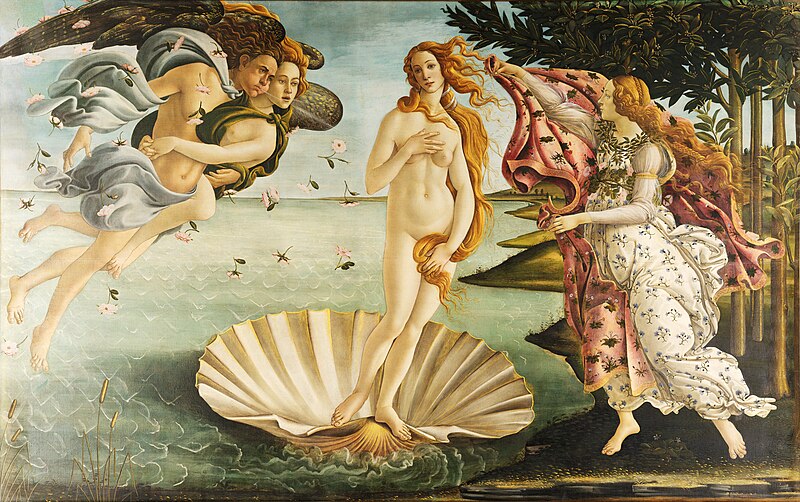
This piece, which I know is called The Birth of Venus, is definitely a more vibrant, modern take on classical mythological themes— instantly striking with its bold use of movement and color: The figure of Venus is clearly central, but also feels surrounded in a very comforting way. She’s emerging from the sea, but it almost feels like she’s a child being pulled from a bathtub and wrapped with warm towels. She’s covering herself up a little— specifically around her pelvis and her breast— but doesn’t seem like she actually cares too much about being modest, and the woman reaching for her seems almost frantic and excited to get her covered in a cloth. She feels very alive, too— the sweeping, flowing lines of her hair and the surrounding waves creating a sense of motion that feels almost like the painting is breathing.
Venus’ pose is confident yet serene, and evokes an aura of renewal and empowerment almost as if she’s reclaiming her space in a contemporary context, having been stuck in tradition and the past for so long. Her gaze isn’t directed outward but seems introspective, adding depth to her character as more than just an idealized figure of beauty. Because of the depiction of her rising from the sea in this shell, she becomes a symbol of rebirth in a personal sense, too— maybe hinting at themes of self-discovery and transformation.
Three other figures flank Venus, contributing to the overall scene: to her left, a pair of what look like wind deities blow softly toward her, their breath gently guiding her toward the shore, with a whole lot of flowers caught up in their breath. Their presence adds a very mystical, ethereal quality to the scene, connecting her strongly to nature. To the right, a female figure, draped in flowing cloth, leans toward Venus with a garment, as if ready to clothe her once she reaches land (again, evoking that image of a child). They frame her in a moment of divine emergence, while the calmness of the sea and the dawn in the background suggest a peaceful, new beginning. There’s a contrast between the softer tones of Venus and the more saturated colors around her that makes her figure stand out, but it also highlights the sense of harmony between her and the natural world she inhabits. The water doesn’t fully recede into the background, but encircles her, and even caresses the shell she stands upon, almost like it’s trying to help guide her. The shoreline flows in and out across the coast, almost like it’s beckoning her forward, and the trees’ branches almost seem to be waving at her.
In general, it’s a very soft yet sort of empowering scene.
The Arnolfini Wedding Portrait ; 1434 CE ; Bruges, Belgium ; 81.8 x 59.7 cm ; Oil on canvas
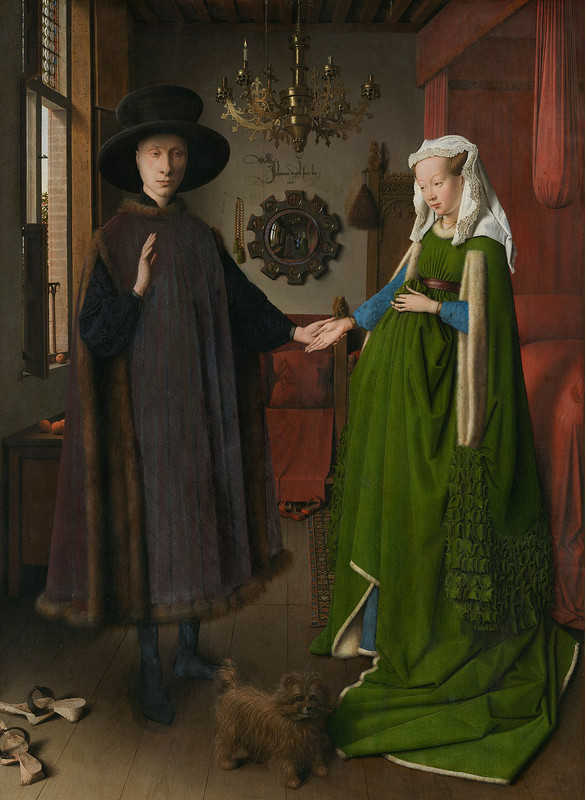
This portrait strikes me instantly with the sense of depth and intimacy, but also distance, within it. It feels almost intrusive, like I’m witnessing a private moment frozen in time. The couple, with their solemn expressions and clasped hands, have a sort of quiet tension between them. Their faces seem pretty still– not like they’re talking– but there’s a subtle undercurrent of something like uncertainty or contemplation beneath the formality of their poses.
The mirror in the center of the piece draws me in, and sort of makes me feel as if I’m not just a viewer, but a part of this scene. It’s a kind of portal that extends the space beyond the frame, showing a reflection of the room that has a few more figures. I’m sort of wondering about the figures reflected in the mirror– their purpose and the dynamics they bring to the moment. There’s two– I wonder if one is supposed to be me? And maybe the other is the artist?
The textures in the clothing and objects are another really beautiful element. The folds of the woman’s dress, with its rich, luxurious fabric, seem to drape and fall with weight, while the fur trim has a very tactile softness that contrasts with the hardness of the wooden floor or the cold, shining metal of the chandelier. There’s many objects scattered around the room, too– the bed, the shoes, the dog– and feel purposeful, with each detail seeming carefully chosen to add to a sense of narrative, though I‘m not sure what narrative. The dog specifically reminds me of loyalty and faithfulness, too, so I definitely get that the couple’s relationship is the focus of our story. On the chandelier, as well, there’s only one candle lit on the man’s side, which is an intriguing detail– I wonder if she’s less alive in their partnership (which feels possible when added to the sort of tense, uncomfortable look they’re sharing), or maybe literally dead.
Of course, the most obvious aspect of this painting and its narrative is the woman’s apparent pregnancy. Her rounded belly, accentuated by the way she holds up her dress, definitely suggests the presence of new life. While she might not be pregnant (could be fat, or her holding her dress up and out in a weird way), the visual cue is strong enough that it immediately makes me consider the significance of fertility, lineage, and family/relationship in this scene. She doesn’t seem to be wearing a ring, though, which makes me less inclined to believe that she’s actually pregnant.
That possibility introduces a layer of vulnerability and tenderness. Her body language feels guarded yet proud, contrasting with the formality and stiffness of the man’s pose, and they seem sort of uncomfortable and unsure with one another. I like that we don't know the couple’s story— whether they’re at a significant moment of anticipation or whether the portrayal of pregnancy is symbolic of something deeper, like wealth, status, or legacy. It adds another dimension to the already intimate, quiet moment the painting captures, making it feel rich with possibilities beyond what is explicitly shown.
Röttgen Pietà ; 1300 CE ; Rheinisches Landesmuseum, Bonn, Germany ; 34.5 in height ; painted wood
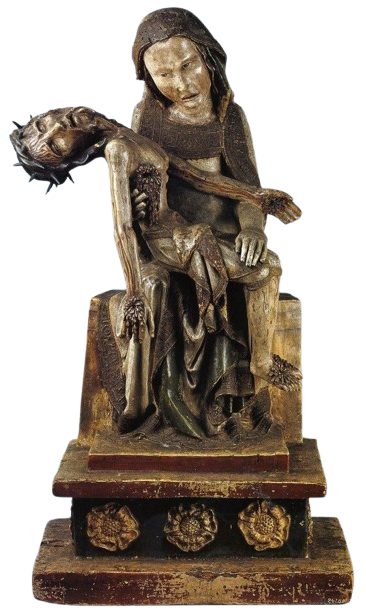
This is a really incredible, striking piece. It’s very stylized and harsh– Jesus adorned with taut skin pulled over visible ribs, open wounds, with a pretty horrific look on both his and his mother, Mary’s, faces. She looks distraught and agitated, and even exhausted, holding her clearly dead son with such a gruesome body. In a lot of images of Mary holding Jesus after his death, she seems to have an understanding (maybe given to her by God) that there’s a reason for this, and a way forward, and so she seems more at peace, but here, she’s sort of viscerally angry and confused. I feel really in awe looking at this piece, just sort of stunned by the violence and sharpness of it all.
I love that we can see all this blood dripping down and across them both, as well. It just feels so much more intense than anything we’ve seen before from Christian art. It’s a very deliberate departure from the more beautiful and pristine.
I can definitely feel a sense of trying to connect divinity to humanity– showing that even Mary and Jesus are sympathetic to and can understand our intense suffering. It feels like the kind of piece you’re meant to contemplate and mourn for. It allows for a more personal and emotional connection with these religious figures that comes with an understanding that you do have similarities.
Last Judgment Tympanum ; 1050-1130 CE ; Conques, France ; 6.7m x 3.6m ; limestone slab

This feels like it’s in one of those arch/triangle-like sections above a doorway or entrance, and my best guess is that it depicts something like a Last Judgment, so I wonder if it’s one somewhere in front of a Church of some kind?
There’s a lot going on in this scene. Christ/the Lord sits in a throne, with a hand up– seemingly passing some sort of judgment– making the sign of “As above, so below.” He’s surrounded on both sides with angels, some holding books, others holding swords, and more.
Right below him, what looks like an angel and a demon of some kind both hold pots (maybe filled with the souls/remains of people?) and face one another.
I can’t quite tell between some of the angels and people, but there seem to be a lot of people along the left side of the piece lining up and waiting for judgment, while on the right, people are devoured and hurt by demons and monsters. Above, we see angels flying above (and possibly holding things? I can’t quite see) in the heavens. It’s curious to me that there’s no specific ‘paradise’ option depicted, but we can imagine it. Unless, there’s a chance that the bottom left is meant to represent the Kingdom of Heaven? But that would be an odd choice. I’m surprised the artist didn’t choose to divide this world into heaven above and hell below. In general, I feel like it’s very mixed, with angels helping people in hell being hurt by the monsters, and other things like that. There seem to be some themes of redemption and salvation as possibilities.
It definitely fits into the Christian idea of hell as a motivator to be good and Chritian– especially if this is in a Church or monastery of some kind. It’s a very intense piece, and I feel stuck and cramped looking at it– maybe even a little worried. It’s sort of overwhelming. I feel like I’m waiting in that same line that all those passed souls are– which is I imagine what it might want me to feel.
Theotokos and Child Between Saints Theodore and George ; 6th-7th century ; Saint Catherine's Monastery, Mount Sinai, Egypt ; 68.5 x 49.5 cm ; encaustic on wood
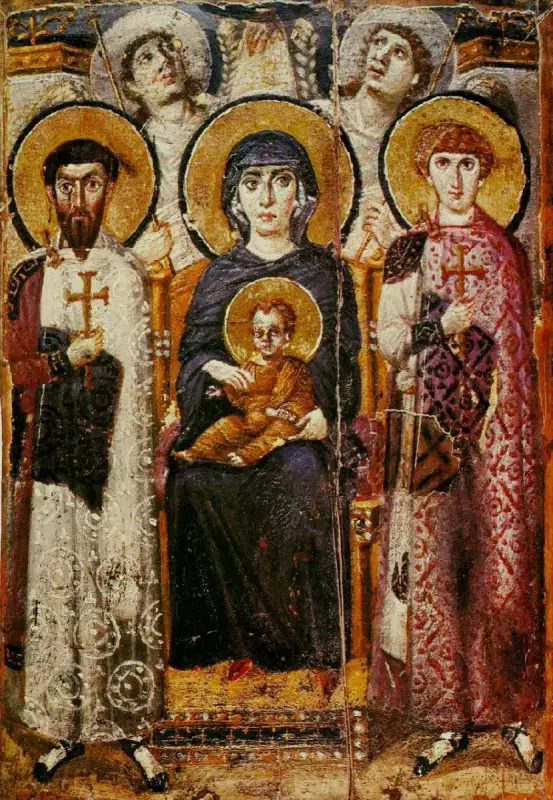
This piece, to me, looks slightly raised/curved, like it either wasn't meant to lay flat, has warped with time, or has some parts that are raised/higher than others as part of its design. Maybe it uses wax? It depicts Theotokos holding baby Jesus while sitting upon a throne, and what seems to me like saints of some sort (I don’t imagine priests, since they have halos)? They seem to be sort of soldier-like as well, though, armed, armored, and protective.
Above them all, two angels look up to what I imagine are the heavens, at God (?), who is producing light and shining it down on Theotokos and Jesus. It definitely feels like there’s a lot of upward movement in this piece, as even Theotokos looks up and to one side, like she’s watching for something out of the corner of her eye, and the angels look up further to God.
I also feel like we get a sense of hierarchy through this; the saints are in a world somewhat like our own world– with their feet touching the ground– Theotokos and Jesus slightly above– elevated on a throne, looking beyond us– and then the angels in the world of God and heaven, pointing up to it since we can’t even begin to imagine it.
The baby Jesus is definitely depicted as older, also! The hairline is weirdly pushed back, though he looks fairly normal otherwise, so it’s definitely leaning into that idea of depicting Jesus as older/wiser.
Maybe it’s just in the photo I’m looking at, but it also looks like there’s some reflection on one of the angels’ halos, kind of like the light on Theotokos is bouncing back onto him.
The color is very gorgeous in this piece. The gold leaf is stunning as always, but I feel particularly impressed with and drawn in by the lighting on the sort of saint-soldiers’ robes. The white one is very gorgeous and intricate, and the darker shading near the bottom is really satisfying to me as is the shadow on the red/purple rode.
That said, I’m a bit confused about the way the lighting works/where the light source is in this piece when I understand that there’s light shining down on Theotokos (that doesn’t seem to be making shadows– it’s Divine, fine), but there also seems to be a light source from the left side of the piece that’s making a sharp shadow under the left saint’s arm and a softer one under the right saint’s arm?
Theotokos Mosaic ; 867 CE ; center apse of Hagia Sophia, Istanbul, Turkey ; 16 ft height ; Mosaic

The art is incredibly brilliant, with an incredible gold (gold leaf?) background, and gold littering the clothing of who I assume is Jesus in Mary’s lap, alongside the stool and platform they sit upon, which seems to be It seems to be a mosaic, sort of fading away/peeling back. I imagine the gold would symbolize some sort of ‘light of heaven’ or ‘Glory of God’. Seating her on the stool/platform is interesting, as it suggests status in her inability to touch her feet to the floor (same with the jewels on her things).
Mary is wearing dark robes, which remind me of the version/period of her often referred to as Nuestra Señora de la Soledad, or Our Mary of Solitude (who my original name, Marisol, comes from). Of course, though, she is not currently grieving the loss of her child, as he sits directly in her lap. She has a very solemn look on her face, and her eyes look almost exhausted (to me). I wonder if he’s just returned? She has her hand on his shoulder, too, showing some amount of care and nurturing.
I like that Jesus is wearing sandals as a child, too, sort of emphasizing his image as a historical figure– especially in addition to his kind of adult face even though he’s a child.
I can’t tell if she’s in blue from just this image, though, so it’s hard to say if she’s actually in anything like that state, or if she’s just being depicted in blue like she often is.
Mary is much larger than Jesus is, though Jesus’s halo also has a cross within it. That said, I like that they’re both depicted as holy and important (I feel this sentiment goes away with time for many Christians, who emphasize God, Jesus, and the Holy Spirit much more than Mary).
I love how solid this art is with its colors– gold as its primary, and then some amount of white, green, red, and the dark blue/black of Mary’s robe.
Justinian and His Attendants, Justinian Mosaic ; 547 CE ; San Vitale, Ravenna, Italy ; 104 in x 144 in ; Mosaic
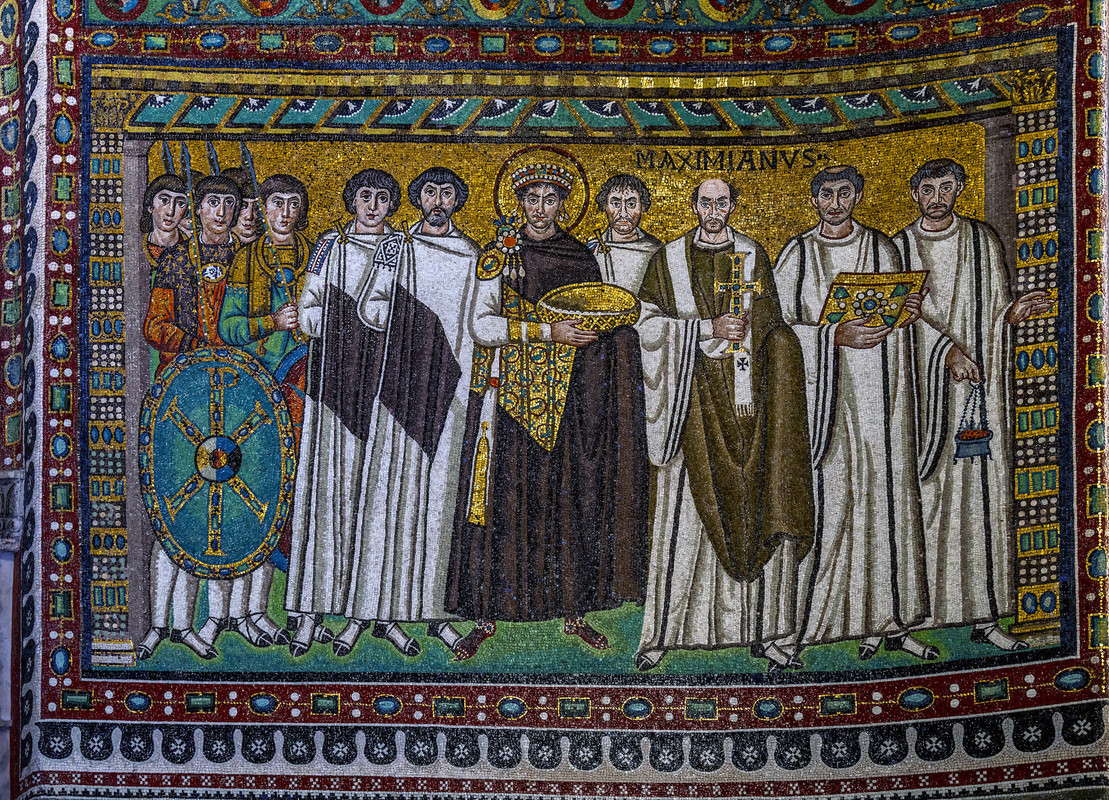
This piece, right off the bat, feels like some definite propaganda from the Emperor/King alongside the Church (Catholic, I imagine) and military. Our focal point is obviously the King/Emperor in the middle with a halo around his head, signifying his divinity and connection to that. We’re getting a very ‘divine right to rule’ sort of energy, and I feel that this piece is trying to show their collective power and collaboration as the general authority of whatever country/nation/empire this comes from. They all have very neutral expressions, and eyes that sort of stare through you– almost intimidating.
They’re also holding a whole lot of riches! The border is very beautiful, full of little gems that, in my eyes, also signify the wealth that comes with their authority. I’m curious about their color choices, with so many blues, greens, golds, reds, and then even some black, white, and orange. It feels like there’s a lot going on, but I do still feel like there’s a very central few colors. It’s not too chaotic.
I’m not super interested in the piece overall, but I’m really drawn into the color/temperature with so many cool tones and a sort of solemn atmosphere. I could almost imagine all these people standing as this painting is done of them (though it likely wasn’t done like that), and can feel the stale, stuffy energy.
This piece also depicts a fairly strong regression in realism and art ‘style’– no more exact contrapposto– and I’m curious as to why. It’s definitely mosaic, though. In the corner, we see a little bit of text that says ‘MAXIMIANUS’, which I don’t know exactly the meaning of, but I can guess is a name.
Ludovisi Battle Sarcophagus ; 250-260 CE ; the Vigna Bernusconi, Rome, Italy ; 59 in height ; Marble

This piece is a huge, incredible scene with so much going on in it. It seems to be pretty high relief, with different Roman soldiers fighting and clambering over one another. Some are riding or leading horses as well, and some people have fallen to the ground— spears in their chests and sides. It’s definitely a dramatic and intense scene with a lot of violence and death. I wonder whether the purpose of it was storytelling, to demonstrate power and strength of a people/army, or just to memorialize an actual historical war/event.
The huge slab stands on a couple pedestals with little lion figures on them, though I’m not sure how intentional the choice in animal was. It definitely does symbolize valor, strength, dedication, determination, etc, so it seems like the right kind of choice for a war scene.
I feel pretty overwhelmed by this piece— there’s so much going on in every direction, and the chaos makes me sort of tighten up. I imagine it’s the same for the figures in the piece, as a lot seem stuck between one another, or trying to comfort themselves while in pain. Others seem really determined and need to move forward.
We do definitely see two ‘sides’ in this piece, though— with a more heroic, noble, and civilized Roman army and then the other people in more casual clothing, depicted a bit more like barbarians as they grab at all the Roman soldiers. The ‘barbarians’ are very squished to the bottom and have expressions of agon and have beards (I wonder if it’s an expression of lack of civilization in them), so that we get a sort of hierarchy among them (the Romans are clearly winning). I have to say, though, that we also get a sense of protection within the piece with some figures. For example, I see one interesting scene of a soldier with his hand around the jaw of another man who’s sitting in front of him, his shield cast around him as if to protect him.
I also feel like, despite all the chaos, we do have a sort of focal point, with a man riding a horse in the center of the piece, one arm out as if to gesture to a crowd. I wonder if he’s some sort of beloved leader, or someone the artist is trying to glorify for one reason or another. His gesture is a sort of oration gesture, and reminds me of previous depictions of Augustus.
Head of a Roman Patrician ; 75-50 BCE ; Otricoli, Italy ; 1.16 ft height ; Marble bust

This piece is incredibly striking– intricate details throughout the entire face, with deep wrinkles, sagging jowls, and a furrowed brow, alongside some scratches/scars, birthmarks, and other imperfections. There are some lighter wrinkles on the neck, too, that are really well done. I’m enamored with the commitment to realism, and curious as to why the artist chose this man to depict.
I wonder if it’s some sort of dedication to ancestors/heritage/history, or a symbol of the society’s (Roman’s?) pride in those things. It’s like they’re displaying that they admire age as a symbol of knowledge, wisdom, and experience. Unlike the ideal bodies depicted in a lot of Greek art, he’s an ideal in a mental context. If this is commissioned, he’s not trying to make himself look perfect, but unique and powerful in his own right.
He has some really sharp facial features and a very focused expression, and in general, it’s such a specific, non-ideal (physically, at least) depiction of a person, that I imagine they were likely wealthy/powerful in their life (or maybe it’s just a representation of the power/wealth that can come with age generally). In that case, they’d likely be some sort of patrician.
The eyes freak me out a little bit, but also clue me in to the fact that this piece was definitely originally painted in many colors that have since worn off.
I really love this depiction in general, though. I love how deep the wrinkles are, and how worn the face feels all around. It feels like I could reach out to touch the skin and it’d be soft, warm, and fleshy. Even though he seems really stoic and intense, he also feels sort of like a grandparent. I can see his vulnerability and honesty behind the way his face rests. I also really like how the wrinkles all around almost make him feel tree-like to me.
Augustus of Primaporta ; 20 BCE ; Villa of Livia, Rome, Italy ; 6.83 ft height ; white marble, likely a copy of an original bronze

The piece is interesting and odd from the get-go, especially with the inclusion of a little baby seemingly holding onto the Roman man’s leg/cloth. I imagine the baby is a Cupid, as he seems to have the beginning of a wing behind him, and I find that odd baby-things in Roman and Greek art usually have Cupid (or specifically Eros/Psyche). I can’t tell what exactly the baby is on– some sort of animal or thing? It seems like it’s diving forward, so it could be a shark/dolphin/whale of some kind, or maybe even a diving bird.
The man himself is clearly Roman and of great importance, and reminds me of depictions I’ve seen of Augustus, the first Emperor of Rome, but I couldn’t say that it’s him with 100% certainty (I’ll still refer to him as such throughout this). In my eyes, this piece is a clear display of power. Augustus is wearing a beautiful, intricate breastplate that depicts scenes of battle (I can’t tell which battle) alongside the Gods to draw attention to his power in battle and war, and especially his victory, while also emphasizing his divine connections. He also seems to be pointing away, which is a very commanding position– maybe toward an army or his subjects, or possibly orating in general.
I’m not sure exactly how the Cupid ties in, since a god of love feels like an interesting choice, but I imagine it’s just a show of connection to divinity and culture/history as a whole– really just adding to the propaganda of this image and helping to make him look like a jack of all trades. Also, if I remember correctly, Julius Caesar to be the son of Venus, so that could be part of it.
I’m really impressed by the cloth around his waist. It’s incredibly detailed and high relief, and it’s folded around itself in a really elegant way.
I think that he all around feels like a very imposing figure in this piece. His contrapposto stance is strong, and he’s not afraid to take up space with his body language. His expression seems fairly casual and nonchalant, but it’s still serious and intense. I feel smaller while looking at the piece, and the air is more tense. I think it’s likely made of marble or stone of some kind, but I can’t quite tell.
Alexander Mosaic ; 100 BCE ; House of the Faun in Pompeii, Rome ; 8.92 ft × 16.67 ft ; mosaic, made of 1.5 million tesserae
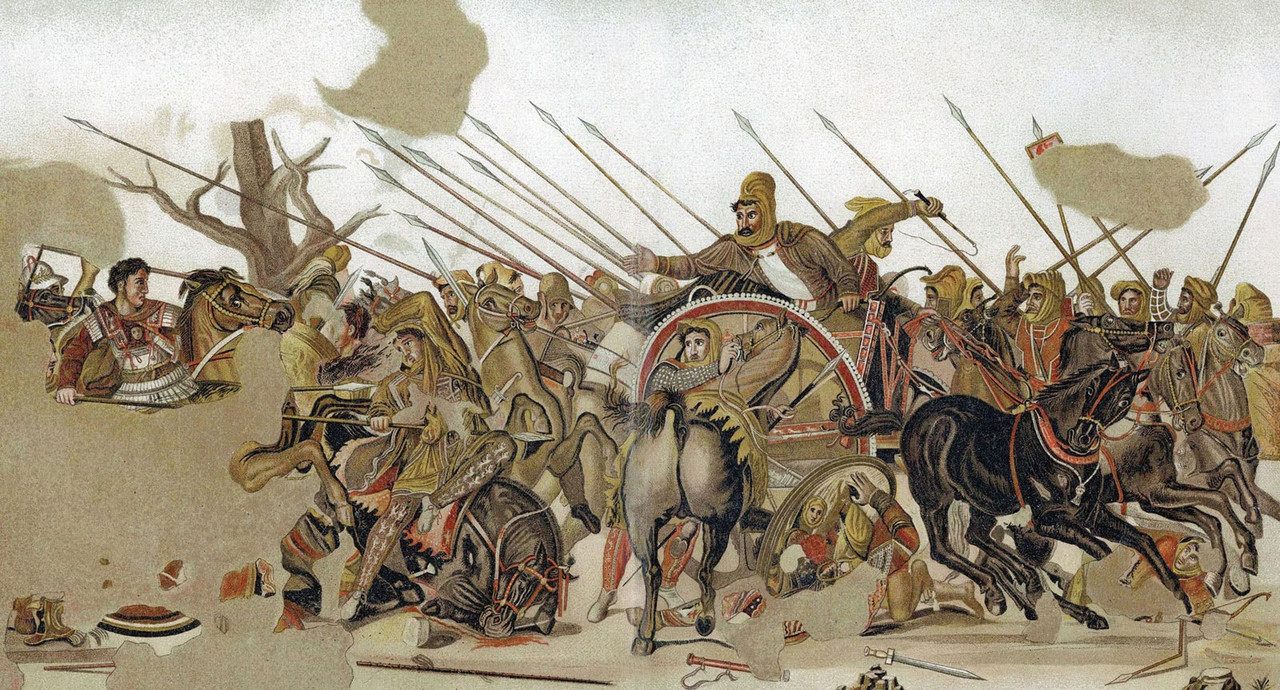
I felt struck by this piece right away– the fear that seems to encircle all its inhabitants as they ride into battle against one another. There feels like there's some Persian influence of this art, though I wonder how much of that is just because of the subjects they’re depicting. On the right, we see one side of the battle– maybe a Persian army– and the Macedonian side of the battle on the left (I’m guessing based on my very vague knowledge of the Greco-Persian wars).
It feels like this is a really big turning point in whatever this battle is. It’s chaotic– there’s people crushed between the wheels, all the spears are pointed to one side, and there isn’t a clear story of a winner or loser, moral one or evil one. That said, I’m sure there is a winner, and this does seem like a very large show of power. It’s commemorative but sort of like propaganda– a display of hard power to prove their strength and superiority.
One of the more notable things is that a person to the left of the chariot has been stabbed by someone who is maybe Alexander the Great, though it could be some other Macedonian figure– the others pointing and staring, upset. Just knowing that makes it clear that he’s winning, but it’s interesting that the Persians are placed so highly above composition-wise. (maybe to suggest that they were so powerful, but still couldn’t win?).
The person in the chariot points toward the man stabbing him, but it seems to me like the men upon the horses in front of him are dismounting, maybe just to fight on foot, but I imagine more likely to abandon the battle. I guess that suggests even more strongly that this is a depiction of the beginning of the end for the Persians.
Apollonius Seated Boxer ; 100-50 BCE ; Quirinal Hill, Rome, Italy ; 4.2 ft height ; bronze with copper inlays
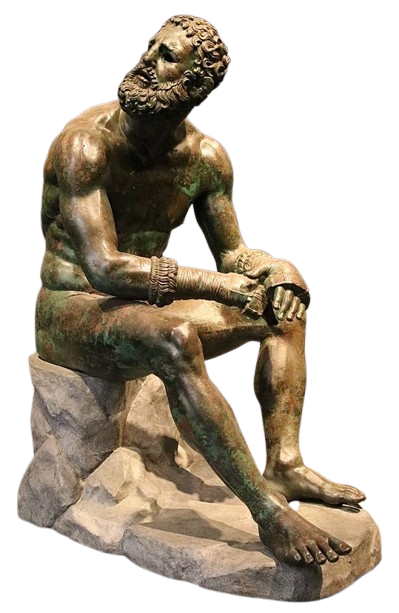
The man looks off into the distance, very exhausted and in pain. I get that feeling even more because his wrapped hand reminds me of that of a boxer or fighter of some kind, making me think that he might’ve just gotten out of a fight of some kind. He also has cauliflower ear, which makes me even more certain he’s a boxer. I can’t tell if he’s defeated, exactly, but he’s definitely drained. His expression is really dramatic and intense, and it almost looks like one of despair, so maybe maybe he has been defeated. It could also just be a very intense depiction of pain and exhaustion, though.
All that said, the way he’s seated still looks really powerful to me. He has a strong ‘stance’ (for lack of a better word), and seems like he’s also a bit energized and ready to fight again– maybe has some adrenaline running. His feet are hovering off the ground, and it feels like there’s some sort of potential energy in the way he’s positioned.
I wonder if there’s any meaning to this piece outside of it being a depiction of a human experience– could it be a sort of symbol/talisman, almost? Is it just a piece for decoration in the home or the city, or is it something that might exist near a boxing ring? Could it have some sort of significance in how it shows someone being able to handle pain and exhaustion– maybe a reminder to do the same, or a good luck charm that you’ll be able to? If he is a defeated boxer, could there be something about losing with grace?
I don’t have much to point out about it, but I really love the smoothness of this carving– each surface feeling very rounded and well-carved. The shine off every surface almost looks like glistening sweat, or an oiled body. Also: the color definitely isn’t intentional as bronze always gets discolored like that, but I feel like the way it exists on this piece really compliments it.
I really love everything about the way he’s positioned and the expression on his face. It feels like I’ve sat exactly like this before at the end of basketball games and things of the like. There’s a certain sort of competitive anguish in him.
Grave Stele of Hegeso ; 410-400 BCE ; Kerameikos Cemetery in Athens, Greece ; 1.58 m height ; Marble and paint
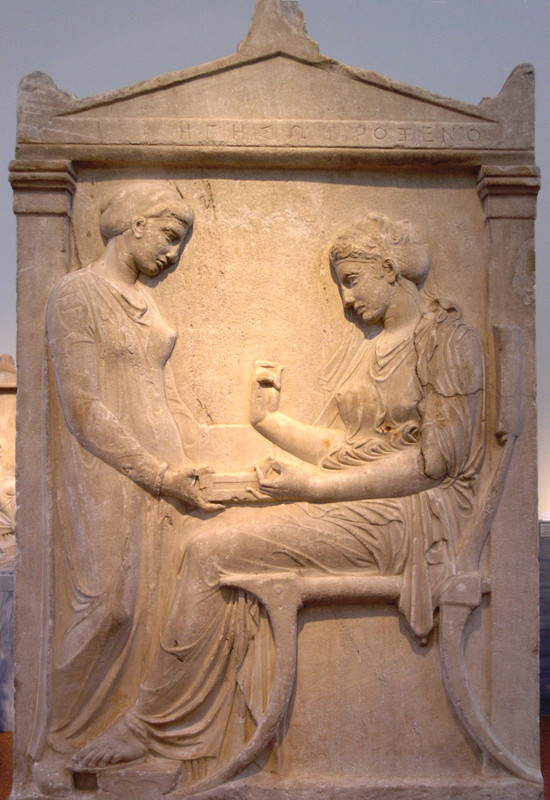
The two figures in this piece are holding either side of some object, which looks like it might be a little chest or tray of some kind. One figure sits upon a simple chair, curling one hand upward as if making a gesture of some sort and holding the object with the other, but sort of loosely, as if they’re trying to hand it off– only still touching it to make sure the other has a grip on it and it won’t fall. The standing figure looks down at the other, holding the chest/tray rightly in one hand.
They both seem to be women and neither have very happy expressions, but the sitting figure seems more upset, with a sort of glowering look on their face, while the standing one has a soft, confident, maybe even smug smile. I’m curious as to what the context is– maybe the sitting figure has lost something, whether status or money or something else, to the other, and is frustrated at having to give it up? I could be looking a bit too into that, though.
The seated one does have a seemingly more elaborate hairstyle/headdress, while the other is dressed simply, and the seated one is clearly much larger than the other, as well, which makes me think they’re more important– maybe a goddess or just royalty of some sort. Also, the seated one is depicted in much more detail than the other.
They’re very close to one another, with the standing figure being almost between the sitting person’s legs, and I’m curious as to why that might be. It makes me wonder if they might have a more intimate relationship of some kind.
Also– a big thing is that the standing woman’s boob is out! I’m curious as to why. Maybe there’s some sort of sexual relationship?
Outside of the art, there is the fact that this piece is clearly displayed on the side of a steele/headstone of perhaps a mausoleum (I can’t tell the size/if there are other sides). It’s made of stone, which definitely adds to the idea that it’s made to last, perhaps for some funerary thing. There’s words across the top of the building, though I don’t know what they say– probably some sort of ‘Rest in Peace’ thing.
Sarcophagus of the Spouses ; 520 BCE ; Caere, Etruria aka Cerveteri, Italy ; 3.7 ft × 6.2 ft ; Terracotta ceramic

I’m immediately amazed by this piece. It’s broken in half, which interests me, as I can’t really think of why it would be. That said, to me, it plainly seems like a sarcophagus shaped to look like a bed. Upon it lie two figures, sort of in a reclining position. I feel like there’s a bit of a twisted perspective to it, like maybe the anatomy’s a little bit off, with the way the feet/legs are angles as opposed to the torsos. My other idea, though, is that it could be representing their spirits rising out of their bodies, and maybe the sort of twisted perspective is very intentional in that regard.
The woman is wearing a little headdress over her long hair that seems to be in braids or twists of some kind. The man behind her has fairly long hair as well, alongside a very solid beard, and his arm drapes across her back, his hand on her shoulder. It’s kind of interesting, because she seems to be almost entirely dressed, though I can’t tell if she has a top on, or just a shawl, and he has no shoes or shirt, and possibly no bottom.
They definitely seem to be wealthy– maybe some kind of aristocrats– which I gather from the frilly pillows and nice bed frame alongside the beautiful shawl. Despite being a sarcophagus, it doesn’t really seem big enough to hold a body, so maybe it’s just for ashes, or I’m wrong and it’s something else entirely. I can’t quite tell the scale, though, so it could just be really huge (perhaps meant to hold a family, or two partners, or a person and their valuables). It’s also interesting and lovely that such a sweet scene is being associated with death in this piece, which reminds me personally of Mexican traditions of remembrance and love for the dead– much livelier and less tragic.
I’m curious about the context of them reclining in bed like this. Both seem to be smiling and gesturing, and his arms relax around/near her. I wonder if maybe they’re having some sort of animated discussion, or maybe just preparing themselves for bed– removing parts of their clothing, whether it’s for sleep or for sex or something else. I think a shawl is draped not quite over her shoulders, but around her arms, which sort of adds to that image for me.
It’s interesting because she isn’t holding anything, which makes me think she’s lost whatever she was originally holding. By the way her hands are set, I imagine it was some sort of bottle, though I’m not sure of what.
Either way, I really love the really intimate scene that’s being painted. The two feel very in love to me, especially in the way he’s holding her, and the soft expressions on their faces as they lie together. I can feel the good time they’re having, even though I have no idea what the context is.
Hunefer’s Judgment in the Presence of Osiris ; 1275 BCE (19th Dynasty Egypt) ; Thebes, Egypt ; 39.8 cm height ; Papyrus scroll

Looking at this image, I’m immediately struck by a few things. One is that the scroll-like layout reminds me of what we’ve learned of the concept of creating a Book of the Dead, and so I wonder if this is a part/scene in someone’s. This is also supported, in my eyes, by the fact that the figure is guided by Anubis, the God of the Dead, and meets Horus, the god of protection among other things.
The main scene seemingly depicts one of the judgment trials within Egyptian mythology, where a heart is weighed against a feather, and if it is heavier, then the alligator-dog creature (whose name I can’t remember) eats it and your soul does not progress.
I personally can’t say I find this scene very emotional, evocative, inspiring, etc, as it feels like a very straightforward depiction of a story. It is definitely more positive, as nothing bad is happening to the person, which makes sense, as a Book of the Dead is meant to portray your hopes of the afterlife– sort of manifesting reality. I am intrigued by two of the scenes within it though, the stories of which I’m less familiar with. I imagine that they are also judgment trials of some sort.
I like that Anubis has taken the person’s hand as he’s guiding them, though. It’s a nice detail that I do feel inspires some amount of emotion, and I like the depiction of him as a sort of supportive, comforting figure throughout these trials. He doesn’t harbor any ill-will, just is doing his job in guiding you through the necessary trials.
Horus, to me, feels a little more to the point. He doesn’t seem to have as much of a comforting aura– maybe a bit more demanding and to the point, though he does also hold the ankh in one hand as Anubis did. He seems to be guiding him to the green-skinned figure in the right panel who’s wearing a pharaoh's crown (seems to be a depiction of Osiris), but I don’t exactly understand what they’re doing or what the situation is generally. There are women behind him trying to get his attention, maybe, and Horus is flying above him (now depicted as a full falcon). He’s the god of resurrection, and so I imagine that some other aspect of the soul’s trial or general process of achieving rebirth/eternal life.
The scene along the top makes me wonder if it’s sort of the last aspect of the soul’s journey after death, or maybe some sort of remembrance of his life on Earth– paying his respects to the different Gods. It’s kind of interesting that some in the front of ankhs, though, and some in the back do not.
House Altar: Akhenaten, Nefertiti, and Their Three Daughters ; 1351-1334 BCE (18th Dynasty Egypt) ; Tell-el Amarna, Egypt ; 13 in height ; limestone stele

Two main figures, one man and one woman, sit across from each other on cushioned chairs, with what looks like cushions under their feet as well, and both hold smaller beings on their laps, and one crawls across the woman’s shoulder. I assume the smaller ones are children because of the way they’re interacting with the bigger parents (I’ll explore that later), but also wonder if they could be humans because of their weirdly adult-like proportions, with the bigger figures being the Gods.
One is holding the small figure up to his mouth, I think kissing it or showing it affection, but the face also doesn’t look that affectionate, so I’m not sure if it’s something else. On the woman’s lap, the small figure points at the other two while looking up at her, seemingly trying to show them what’s going on, and the one on her shoulder is pushing her head to look at the others, too.
I’m curious as to what the story is, and am somewhat reminded of how Cronus ate his children, who turned out to be the Gods, in Greek mythology, though I can clearly tell that this is an Egyptian piece, and not a Greek one. I get a feeling that it's not about that at all, but it just reminded me of it.
On a separate note, a sun in the middle-top shines down upon all figures present with little ankhs at the edge of their rays, making me think that maybe the figures are important, having eternal life bestowed upon them. That idea definitely feels supported by the fact that the man is sitting up straight and seems to have a fairly big headdress/crown and the woman is wearing a small headdress and slouching forward. It’s interesting, though, that their bodies don’t seem to be ‘ideal’.
Also, I’m intrigued by the fact that the woman and man are both painted the same size, insinuating that they’re ruling together. That said, there is clearly a power differential between the small and big beings. The fact that it’s in stone always gives a sense that it was truly meant to be permanent, and because of the implication that the big figures are pharaohs, I wonder if it’s dedicated to their children/inheritors to the crown, sort of trying to announce their futures.
There’s a lot of text (hieroglyphics?) surrounding the image, though I obviously can’t tell what it says, and I wonder, again, what story it’s exactly trying to tell (could also be a recreation of a myth of some kind, through art & engraving).
Along the right side of the image, there seems to be a staff or column of some sort that has what could be a sort of bird figure on the top (Horus?), but I can’t tell, as it also looks sort of just like a handle of a cane/staff.
Large Kneeling Statue of Hatshepsut ; 1479-1458 BCE (18th Dynasty Egypt) ; Deir el-Bahri in Thebes aka Luxor, Egypt ; 261.5 cm height ; granite figure
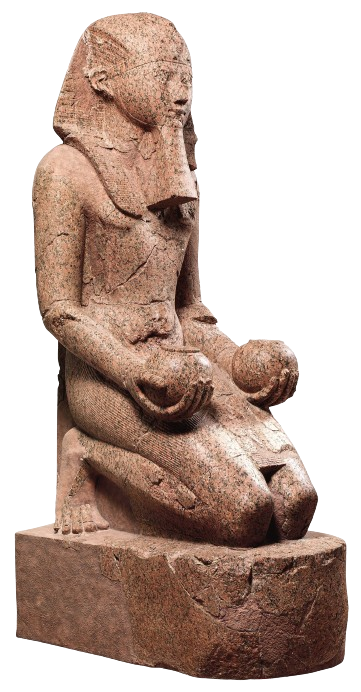
An Egyptian pharaoh kneels, both their hands holding two little spheres– maybe little vases or vessels of some kind? They’re kneeling upon a big stone piece of some kind, which I don’t imagine has much significance. It’s possible that there was some inscription on it at some time, which has now faded away.
There’s something around their waist that looks raised, like maybe it’s a belt of some kind, but I can’t tell. It’s been worn down very thoroughly– maybe through specific handling, but likely just through time. It’s hard to distinguish a lot of features from one another, the nose, eyes, and lips being very simple, and the ears, fingers, and feet standing out the most. There’s definitely some patterning in the headdress and beard, but it’s definitely light and faded. The piece has a lot of cracks as well.
I definitely feel a lot of balance in this piece, though, with a very strong sense of symmetry.
I’m intrigued by how humble they look, relaxed in a posture that seems to be praying or offering themselves to something– I imagine the Gods or a specific God. Especially with the little pots, it makes sense that they’d be praying/offering something, and I feel like this piece would have been used in a ceremony of some kind, and was likely made as a dedication to another God (sort of like the Palette of King Narmer, though that one was just decorative). It’s stone, too, which suggests the hope of permanence, and adds to that idea.
It makes sense to me as a piece– trying to show that even the pharaoh is not above the Gods, and that all should offer themselves.
Seated Scribe ; 2620-2500 BCE (4th Dynasty Egypt) ; Old Kingdom of Saqqara ; 53.7 cm height ; painted limestone statue, rock crystal eyes, magnesite, copper-arsenic alloy, and wooden nipples
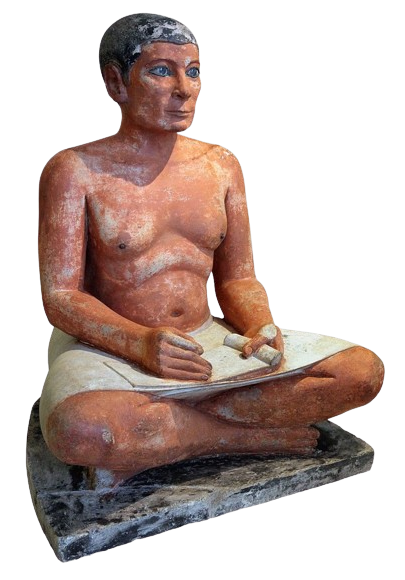
He seems peaceful, somehow, staring out at the world with a small smile and full eyes. I think his high cheekbones definitely add to that sense of peacefulness, joy, and even confidence in his eyes. His shoulders are relaxed, as is his core– leaning gently forward, though not slouching– and the crossed legs make me think that he might be resting or meditating, or even just working on something small in his hands.
In one hand, he’s holding some sort of writing utensil, with some sort of paper or stone slate of some kind in his lap (unless what’s in his hand is just rolled up paper). The other hand has his thumb pinched to his pointer finger, but I can’t tell if he’s holding something between them or not.
Mixed with the fact that he’s looking upward, as if he’s looking for guidance from some other being, which I think reaffirms the idea, I wonder if he’s some sort of scholar, scribe, priest, etc. It’s interesting, though, because he’s not depicted as a sort of ideal man– he has rolls and is a little slouched and only wears a skirt, making me think he’s not particularly powerful or viewed as very grand.
Also, the darkness around his eyes makes me think of kohl, so I wonder if he’s meant to be North African or West Asian.
He’s a very life-like character, in general, which sort of feeds into the idea that Egyptians view statues as sort of alive in their way (their word for a statue even meaning ‘living image’). It’s interesting to see the scribe be portrayed working, which I don’t feel is a commonly depicted job.
Palette of King Narmer ; 3200-3000 BCE ; Hierakonpolis aka Nekhen, Egypt ; 63.5 cm height ; smooth grayish-green siltstone ; ceremonial, special palette of some kind
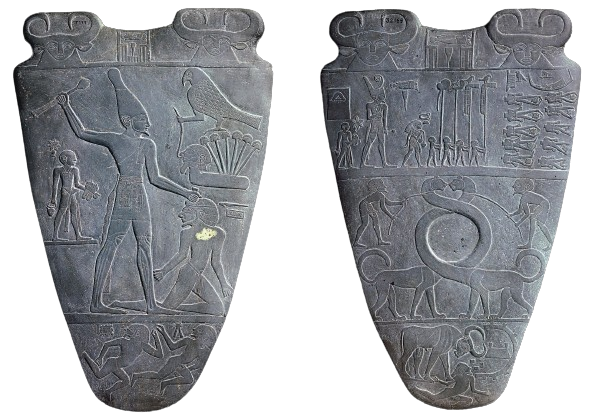
This piece is composed of two same-shaped stone pieces, almost flask-like with triangular bodies and a flat-ish top. To me, the piece’s distinct style is clearly Egyptian. Both depict their own scenes with several layers each, which reminds me of descriptions of the world and its afterlife in layers– maybe one with the living, one with the dead, one with the Gods, etc.
On the left piece, there’s one main layer with a smaller one below– the main one picturing a man (maybe a King or a God) seemingly getting ready to either bless or maybe strike (the second feels more likely) another man who kneels beside him, held by the hair. A bird (associated with Horus, who’s associated with kings) stands beside them, and a little man on what looks like a shelf on the other side. Below the floor under them is what looks like two nude people running from something, maybe defeated/humiliated in some way.
On the right piece, the piece is split into three somewhat equal layers. The middle one holds what looks like two lion-type creatures (serpopards) with incredibly long necks intertwining with one another, and a man atop each one who seems to have them lassoed/on reins of some kind, like they’re trying to hold them back. In the top one, I’m honestly not too sure what’s going on. There are an incredible amount of figures doing different things– some looking almost like children. One is wearing the crown of upper and lower Egypt, which is interesting to me. The figures along the right are laid on their sides, missing heads, so it’s definitely a violent scene. In the bottom layer, there’s a bull stomping on the arm of the man, and knowing that bulls tend to be associated with pharaohs, it feels like another display of dominance of leadership.
One similarity between the two pieces is the two little creatures atop both that look sort of like bulls or rams with human faces, and some sort of seal between them.
I’m honestly not too sure what’s going on in the piece, but I’m intrigued. There’s a lot of movement in both that reminds me of a sort of mythical scene. Maybe the pieces are meant to be a part of storytelling of some kind. I think the lack of a focus in the pieces makes it hard for me to really get a sense for what’s going on, especially without any other knowledge outside of just what I can see, and I could definitely imagine someone sort of leading you through the images to tell a story.
That said, I do definitely feel like that idea of different layers of the world keeps coming back to me. As an example, I can see that in some layers on each, there’s a bit of a theme of suffering, which makes me wonder if it’s trying to represent the different parts of humanity or something of the like.
I imagine that its use is related to something more decorative– maybe made for nobility of some kind? The piece, to me, is very striking. It feels very powerful and intense, with lots of scenes of intimidation and humiliation. I imagine that this is meant to be intimidating and intense– something to legitimize power. Since it has the falcon which is associated with Horus, I do imagine it’s sort of dedicating itself to the idea of a tie between the pharaoh and Horus.
Tlatilco Female Figurine ; 1500-1200 BCE ; Tlatilco, Mexico ; 9.5 cm height ; this type of figure is very common, usually in a brown tone & of an ideal body type (though can be much more varied in their representation of the human body), and this one is part of a large collection
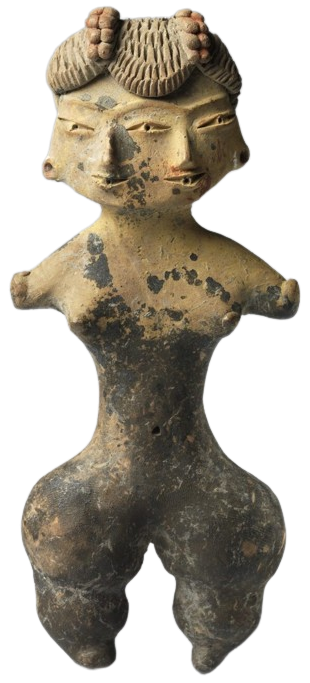
I’m noticing a pattern in myself of loving flowing movement and smooth curves in art, and in this piece I'm drawn immediately to look at the wide hips that branch from such a thin waist and torso, along with the way the legs look almost like little stacked blobs. It makes me wonder if they could’ve been wearing some kind of wide pantaloon the details of which were erased with time? I especially wonder so because the piece seems to have two different colors– one dark and faded, and one a bit brighter and more detailed.
It’s interesting to me that the figure doesn’t have arms, but it almost seems like they do have little fingers. It reminds me of ‘nubs’ that people sometimes have if their arms/hands don’t fully form. It could also be a sleeve of some kind, but we can clearly see the figure’s breasts and nipples, which makes me think not. An armband?
Of course, the being has two faces, which is definitely an interesting component. I’m reminded of a lot of different deities with several faces like the two-faced Roman Janus– god of doorways, crossroads, new beginnings, etc. and even Hindu Brahma– known as the Creator, whose four heads represent the four Vedas and are pointed to the four cardinal directions.
It makes me think of them also as a deity, and combined with the sort of mischievous look it has (a little grin and eyes that could just be a depiction of monolid eyes, but even then look like they’re almost squinted in excitement), I wonder if they’re some kind of deity. Maybe a trickster God of some sort? It especially makes sense with the idea of two-facedness being a symbol for liars, manipulators, etc. It could also just be representing duality in some regard?
Also, it looks like they have eyeballs or spouts or something circular in their mouth? I don’t know quite what’s going on with that, but I’m curious about the idea of them as being watchful and sort of a counterpart to the playfulness/trickster energy.
I’m curious as to what’s going on with the incredibly textured hat/hair/headdress? It almost looks like snakes or fruit or even udders of some kind, but I could also see it being some sort of string of beads.
I could also think of the piece as a talisman of some kind, but if it is a trickster, I’m not sure why it would be carried with you. The big hips could suggest fertility as well. In that case, the two faces could represent a community with childbirth and raising a family? Or, if we blend the two ideas (fertility and mischievousness), they could be a sort of representation of lust.
Running Horned Woman ; 6000-4000 BCE ; Tasilii, Algier ; plateau on one of largest massifs in Tassili N'Ajjer National Park ; 13 feet height

I’m intrigued from the first moment by the flowing movement of the figure’s body as they run– the way their joints are soft and rounded– but how the limbs are cut into sort of rectangular joints at the same time. The image feels very geometric.
I almost feel like there are two versions of the figure– one made from their solid body, dark and tangible, and the other from the white dots (scarification?) and lines that surround their head and body, whether it’s clothes or just an essence of their self. In fact, I feel like the entire image is sort of grappling with these two layers– one of the dark and one of the light, sometimes overlapping, and sometimes shown starkly against each other (as in the way the white outlines some darker bodies, or in the figure in the bottom right corner).
The figure has what seems like horns, which interests me and makes me wonder if they’re some kind of deity or mythological figure, famous or not– and also because of the scale between them and the other beings. I also wonder if maybe the horns are a weapon through their head, instead?
I’m also curious as to what they’re holding. At first, it looks to me almost like some sort of string or whip or something, but then I realize that there aren’t clearly defined hands, and I wonder if maybe it’s part of the cuffs/gloves/something else around their hands. Also– the band around their upper arm feels like flowing water. Why are there dots around their head, or the little patch of what looks almost like grass atop all the dots? Or maybe it’s a cloud with rain? Is it a headdress or halo?
Smaller figures surrounding our main focus draw my attention me mainly because it’s hard to tell where exactly in space they are, but I love at the same time how they seem to be moving around our main figure– holding up the cloth over their pelvis, and maybe hunting or fighting or dancing (I can’t quite tell). It almost looks like they’re holding the white strings coming from their wrists, too. I wonder why exactly they might not have heads, which leads me back to that idea of hunting or even war? I wonder if this art is trying to tell the story of some event (or myth).
There are three figures around the image that are particularly unique– one I can’t place on the left side, that looks to me almost like a little straw creature or man, one in the bottom right that I truly can’t place, but looks almost like different rocks or a little cutesy bear head, and the more defined figure between the main figure’s legs– someone with their breasts elongated and pulled forward and a straw skirt on, underneath an arch that looks almost like a rainbow. I’m curious to know more. They have the same dot patterning on the body as the main figure– scarification.
I don’t know quite what to say about the piece. Our main figure feels almost frantic to me– reminding me of an archetype I feel I know through different films and stories of a great, kind creature that cannot be saved, and ends up left behind somehow (I still love you, brachiosaurus in Jurassic World), yearning for more. Maybe that’s influenced by the great horns on their head, and the soft rolling shoulders. They feel too soft for the situation, somehow– like their body and mind are too gentle and warm for it– and as they run, swaying, their arms flailing, they feel hopeless and frantic and desperate and sad. Maybe they’re a God running with their people, sad for their loss and what they couldn’t help. I’m not sure. That’s just the energy I get.
